

The 620 Dealership Memories Increasing Hydraulic Power April 2024 GREEN Magazine® In this issue...
A Specialized Look Into The Unstyled Model A
The Handbook of the John Deere Model A 1934-1938
Fourth Edition • By Wes Malcolm
Now in its fourth printing with 15 more pages, this is the handbook of the John Deere model “A,” 1934-1938. A book that should be on the “must read” list of any unstyled “A” owner. There is probably no other book on the market that goes into so much detail on a single model of tractor. Shows illustrations of nearly every change made in the parts that make up the unstyled “A.” 95 pages, 11x8-1/2 inches, soft cover.

Both books include history, specifications, serial numbers, original prices and much more


The Handbook of the John Deere Model B 1934-1938
The same types of information as available in the book above, except now about the model “B,” written and compiled by a panel of experts who have spent decades collecting and restoring the unstyled version of Deere’s most popular tractor. This book shows nearly every change made in the parts that make up the unstyled “B.” 84 pages, 11”x8 ½”, soft cover, over 200 photos - most in color.





published by Green
WHAT A DEAL! SPECIAL BUNDLE PRICE on these TWO books
Magazine
A Specialized Look Into The Unstyled Model B
Order GMAB: $63.95 U.S. (Nebraska
$76.95 Canada (US funds) • $89.95 Foreign
funds)
the first
DEAL. •• Prices in this BUNDLE DEAL are up to 20% OFF the regular price •• Visa, Mastercard, Discover, American Express accepted • Nebraska residents add 5.5% sales tax • Price includes S/H Call 402-643-6269 • Email info@greenmagazine.com Online www.GreenMagazine.com Mail Green Magazine® • PO Box 95, Bee, NE 68314-0095
residents add 5.5% state tax)
(US
The prices shown here are for BOTH books shown above -
time for this BUNDLE
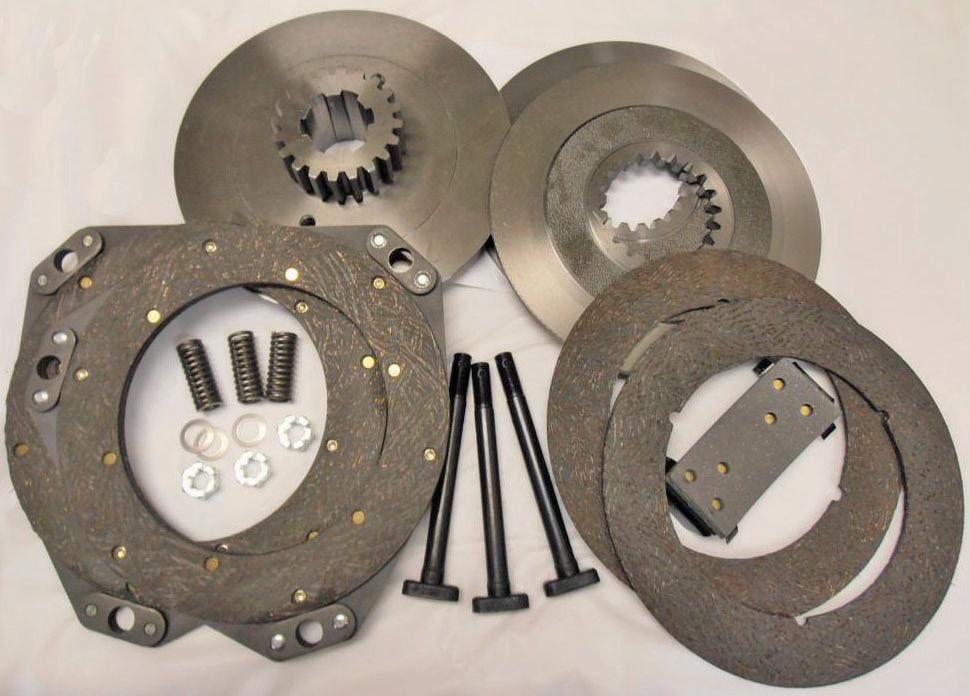

















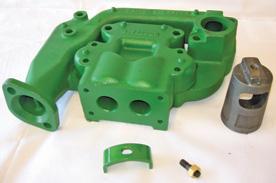

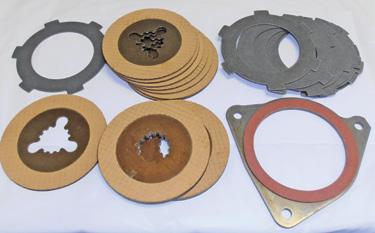


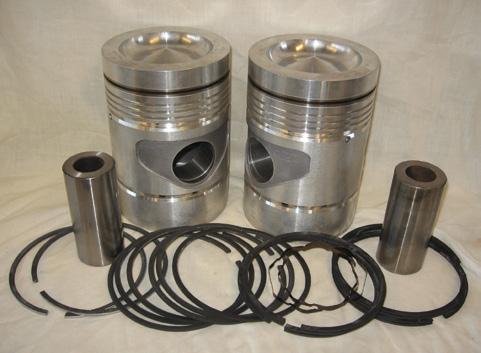









Martin Parts & Repair Oversize pistons available again for many two cylinder tractors Radiator cores, water pumps, bolt kits Emblems Chrome stacks Ignition parts Lights & light parts Battery boxes Fuel sediment bowls Valve train parts & kits Manifolds & exhaust pipes Gasket kits Seats and seat parts Grill screens PARTS TRACTORS 5020, Unstyled G, 430T, 2510 gas, 730 LP, 2010D, 530, Late 520, ’39 B, BN, 40U, ’53 AO, ’41 H, ‘46 A, late A’s, ‘46 B, late Bs, slant dash B, unstyled B, sty. D, G, unstyled L, M, MT, R, 40T, 40U, 40W, 70D std., 70G, 420U, 420W, 440 w/reverser and power steering, 440 gas, early & late 50s, early 60, 60 w/power block, 620, 620 LP, 630, 630 single front, 70G, 720G, 720 LP, 720D pony, 730D, 730G, 820, 1010, 2010, 2010D, 2010RU, 2020, 3010D, 3020, 4020D. Most of these tractors are parted out & on the shelf—ready for quick shipment! Electric start kits Tachometers and cables Complete clutch rebuild kits and clutch lining kits Brake rebuild parts SUPPLYING PARTS for your CLASSIC JOHN DEERE NEW & USED • IN STOCK • READY TO SHIP Call or e-mail with all your parts & restoration needs or for a FREE CATALOG PTO clutch kits & parts Full round main bearings for 2 cylinder tractors Sheet metal bolt kits Wide front parts Complete carburetors, kits and parts 7487 E. 450 N. • Rochester, IN 46975 574-598-6083 • 844-720-2510 Email: sales@martinparts.net Now stocking USA MADE GAUGES LOTS OF NOS PARTS Email for a price list Unstyled G #6221 5020 serial 019483, hood available

U.S.:
Nebraska
Canada:
Foreign:
First




“GREEN
POSTMASTER:
MAGAZINE®” (ISSN 0883-5462) is published monthly and released 12 times a year on or about the first of each month for $39.95 per year (Canada: $59.95 per year; Foreign: $69.95 per year) by Hain Publishing, Inc., 2652 Davey Road, Bee, NE 68314-9132. Periodicals postage paid at Bee, NE and additional mailing offices.
Send address changes to “GREEN MAGAZINE®, PO Box 95, NE 68314-0095.”
MAGAZINE® reserves all rights regarding reprints of this publication. Our phone number is (402) 643-6269. Copyright © 2024 Hain Publishing, Inc. All rights reserved. The monthly publication for John Deere enthusiasts 10 Riechmann Bros.: Dealership celebrates 100 years Cindy Ladage 16 John Deere model 620 Benjamin Hain 32 Dealership memories and John Deere Days Jimmy Dale Rinne 59 Dad, me and a JD “GP” Ken Heipel April 2024 • Volume 40 Number 4 Departments 5 Richard’s Column 6 Deere John 24 How our hobby started Tractor shows and TV shows Richard Hain 26 Tracks & Tales 1973 JDX-8 Joe Rainville 30 Saw it online Circles in competition Adam Smith and Benjamin Hain Each March issue of Green Magazine includes an index of major articles from past issues. The March 2024 issue features the newest index. 34 Auction highlight Orchards lead the way Eric W. Mickelson 38 Deere & There 40 More hydraulic power Rich Collins 42 What’s new—and old? Invoices tell a story Greg Stephen 48 Scale models Vintage harvesting set Bill Proft 51 Aussie Ken Canadian working holiday, Part 4 Ken Nicklas 54 Index: Do you have one? 56 The tractor doctor Step on it Ron O’Neill 69 Advertiser index 72 Mr. Thinker ON THE COVER: Dan Kaler of Sioux City, Iowa owns this 620 standard. Editor Richard Hain Managing Editor Carol Hain Layout/Design Debbie Behne Green Magazine® PO Box 95 Bee, NE 68314-0095 Hours: 8:30 AM to 4 PM M-F Phone: 402-643-6269 email: info@greenmagazine.com web: www.greenmagazine.com Check out the sample articles, catalog, ads and other features! NOTE: VISITS TO OUR OFFICE BY APPOINTMENT ONLY! Please call prior to visiting so we can be here to talk with you. At that time we can also give you our location. Thank you! Rates:
GREEN
$39.95 / 1 year
12 issues
-
residents, add 5.5% sales tax ($42.15)
$59.95 / 1 year - 12 issues
$69.95 / 1 year - 12 issues
Class/Airmail delivery available: See page 5 Visa/Mastercard/Discover/AmExpress accepted Page 4 April 2024 • Green Magazine

I’m finally getting back to working on the late styled “A” that has been apart in my shop for some time now. It’s running well and most of what I am doing is in preparation for painting. When I posted a photo of it online before I first tore it apart, quite a few told me not to paint it and leave it original. I have no problem with the trend of the last 10 years or so of keeping tractors in their original state, but this tractor has already been painted at least once and needs several repairs to its sheet metal. I don’t think that exposed Bondo and welds are a good look. At any rate, I need to clean some dirt from the tractor that has probably been riding along for 73 years and fix a loose steering wheel. The loose steering wheel is something that I have never run into before and I’m not sure how many times the steering wheel would have had to have been removed to wear out the end of the shaft, but in order to get the steering wheel on far enough to make it tight, it needs two large washers between the nut and the steering wheel. I’m going to try and use a shim designed for the rear axle of a model “A” Ford to get it tight. I will let you know if it works.
I’m still trying to figure out the order in which to paint this tractor. I suppose that getting all of the nooks and crannies painted and then putting the tractor back together is a problem with any model, but to me, the late styled “A” and “B” are the worst of any with the way they go together,
or apart. Most of you know the unorthodox way that these things go together where the first thing you need to do in order to replace the muffler is to remove the steering wheel. It seems like doing all that in reverse order with freshly painted parts is an invitation to scratching something. I’ve talked to several people about their processes and heard several schools of thought. Some paint the basic tractor and hood separately, put them together and give them both a couple more coats. A few others paint the engine, frame and drive train, mask or put tarps on everything that is already painted, install the unpainted sheet metal over it and then hit it with paint. Still others paint everything, put it together and then fix any scratches. There might even be some other methods I haven’t heard of.
We’ve had a good response to our request for 20 series two-cylinder tractors for our 2025 calendar, but keep them coming, especially if you have an uncommon variation. Remember, though, the tractors should be restored like original which means no chrome stacks, oversize tires or non-original fenders. I’m glad to publish those photos in the magazine, but not on the calendar which is supposed to look like the tractors came straight out of 1958 advertising.
By the time you read this, many of you will be hitting the fields, so please be careful out there.
See you next month.
Missing an issue? We mail every issue by the first of the month. Please contact your post office if you suspect a problem with delivery. We will not replace missed issues three or more months past original mail date (four or more months for foreign subscribers) free of charge.
U.S. subscribers: If it is on or after the 20th of the month and you haven’t received your issue, call us for a replacement.
Canadian subscribers: Due to postage costs, we are forced to ask for a $2 postage fee (U.S. funds, please) for re-sending issues that do not arrive by the end of the published month OR we can add an issue onto your subscription for the missed issue.
First Class/Airmail delivery: Call for rates for First Class in the U.S. or Airmail to foreign countries.
Foreign subscribers: We will add an issue onto your subscription OR for a $7 airmail postage fee (U.S. funds), we will resend the missed issue two months after publication date.
Notice: If your address label shows an expiration date of “4/24” above your name, this is your last issue. Renew immediately for continuous service. If your address label reads “5/24,” you have one more issue on your subscription.
Renewal notice: We send postcards to let you know your subscription is about to expire (or has expired). We NEVER call to ask if you would like to renew your subscription. If you
receive such a call, it is most likely from another publication—NOT Green Magazine® for John Deere enthusiasts.
Address Changes: Please send or call with notification of an address change as soon as you know what your new address will be. Periodical mail cannot be forwarded. Green Magazine will not replace issues missed due to late notice of address change. Those missed issues will have to be bought at back issue price. See the back issue listing and prices elsewhere in this issue.
Looking for your photos and stories! Accepted material is subject to such revision as to meet the requirements of this publication. Payment will be made at our current rate within 90 days of publication. Submission of manuscript implies that the material is original and in no way an infringement upon the rights of others. Please send good, clear photographs. If you would like these returned, send us a stamped return envelope to help us get them back to you.
Free Issue Offer: It seems you, our subscribers, are our best form of advertising! More people find out about this publication by “word of mouth” than other forms of advertising. So if you're enjoying Green Magazine®, why not spread the word? Telling others about it can pay benefits. When you tell a friend about Green Magazine® and they subscribe, make sure they tell us who let them know about it. When they do, you will get an issue added to your subscription. These must be new subscribers, not renewals.
Please wait until AFTER the 20th of the month to report a missed issue of Green Magazine Ph. 402-643-6269 or email info@greenmagazine.com Green Magazine® • April 2024 Page 5

This is a picture of our 8850 powering a 16 inch by 125 foot grain auger. Here is the story:
I purchased this 8850 in 1988. It had 1,100 hours and one season’s use. The farmer traded six of these for six more unused 8850s, remembering the machinery glut on the 1980s.
Prior to 1993, I had this tractor “top end” overhauled three times in less than 1,000 hours and then it completely destroyed itself. John Deere has a firm in Kansas that completely remanufactures/rebuilds engines for them. More expense and in less than 200 hours, the crank shaft broke.
There is a reason that Kinze Manufacturing and others made a big business changing out Deere engines and installing mostly Cummins engines. Very reluctantly, I became one of their customers. The tractor now performs like I thought it would many thousands of dollars ago.
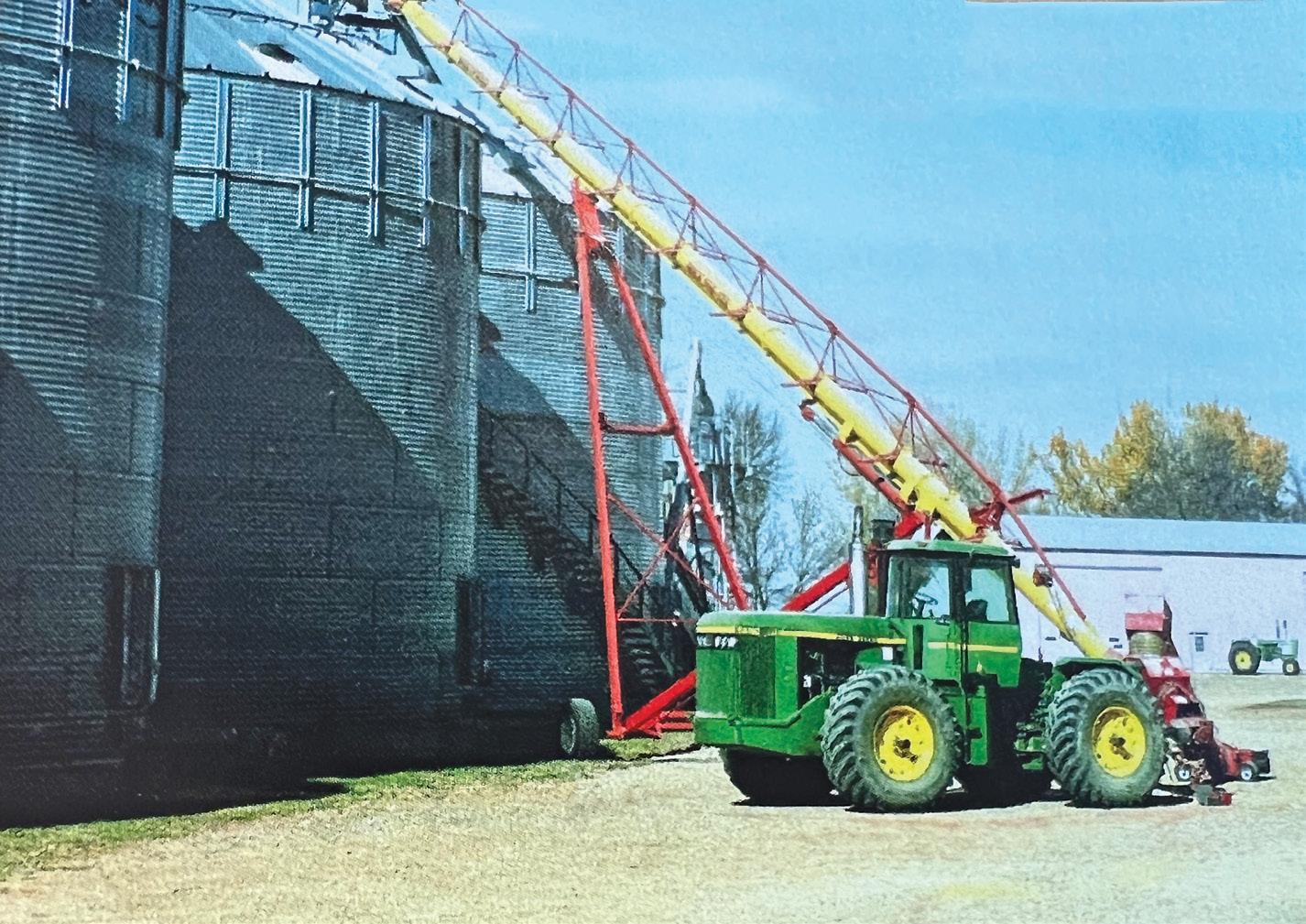
Model 8850s were of so little value to sell that we kept it. It is a backup tractor. When a 16 inch by 125 foot auger was purchased, requiring a 350 horsepower plus tractor, we were ready. The cheapest source of power was an 8850 with a 450 horsepower Cummins.
Our “backup” tractor backed right up and has been trouble free. Power, PTO stamina and hydraulics to help. All of a sudden, it became the “big engine that could.” I always liked it and now I am proud of it.
A little like Rudolph the red nosed reindeer, it took over 30 years to find its special place.
Cal Hayenga, SD
We welcome your submissions • Deere John letter • Restoration stories • Deere & There photos • Other stories, photos and more Green Magazine PO Box 95 • Bee, NE 68314-0095 Email: info@greenmagazine.com Please send high resolution photos if submitted electronically Include your phone number/address on all submissions Send your story today! Submissions accepted for publication will receive a monetary compensation. Page 6 April 2024 • Green Magazine








Bill & Sharon DeVries collection - Thursday, May 2, 12 NOON, 3694 S. Luce Ave., Fremont, MI 49412, Newaygo Co. 13 restored John Deere 2 cyl. tractors including 730 diesel plus 19 other brand tractors, JD manure spreader, JD farm toy collection, JD parade wagon, JD collectibles, etc.
#1:
Saturday, May 11, 10 AM, 49 W. 112th St. Grant, MI 49327, Newaygo Co. 16 antique tractors including restored JD 730 diesel Hi-Crop, farm toy collection, large quantity of JD collectibles, farm equipment, vehicles, tools & farm primitives.
#2:
Dale Snieder Estate,
John Kleyn Estate, Saturday, May 18, 10 AM, 7490 Taft St. Coopersville, MI 49404, Ottawa Co. Complete farm estate - 16 tractors including JD 7520, 5020, 4020 & others, full line of farm equip., lg. farm toy collection, antiques, collectibles & farm primitives. www.artsmithauctioneers.com or call for flyer • Ph. 616-308-0854 3 PUBLIC AUCTIONS! INCLUDING 70 ANTIQUE TRACTORS! GREATER MINNESOTA TWO-CYLINDER CLUB 32nd Annual FIELD DAYS and SWAP MEET Friday and Saturday, May 3 & 4, 2024 Morrison County Fairgrounds, Little Falls, MN FEATURING: John Deere models with multiple letters • All other brand models with both letters and numbers • All brands of garden tractors • Snowmobiles (Scorpion and Brut) Tractor, Garden Tractor, Gas Engine & Snowmobile Displays. Field Ready, Antique Tractor, Garden Tractor and Pedal Tractor Pulls. Swap Meet and Activities for Adults and Kids. ALL EXHIBITORS WELCOME Swap & Toy Vendor or General Info, contact: 320-733-0111 • www.gmntcc.com 1) Call 402-643-6269 with credit card in hand 2) Go online: www.greenmagazine.com 3) Send a check by mail with the subscriber’s name and address to: Green Magazine, PO Box 95, Bee, NE 68314-0095 For more info on subscription rates, see page 4. Questions? Call 402-643-6269 for great customer service! A&L Parts NEW, USED & REBUILT 2 CYLINDER PARTS Hundreds of tractors parted: Wide fronts, 3-point, carbs, starters, etc. • NOS parts MODELS A THROUGH 730 A&L PARTS 432 N. Flat Street • Penn Yan, NY 14527 Phone 315-536-0543 • We ship DAILY • Major credit cards accepted NEW PISTON KITS and RADIATOR CORES Green Magazine® • April 2024 Page 7
#3:


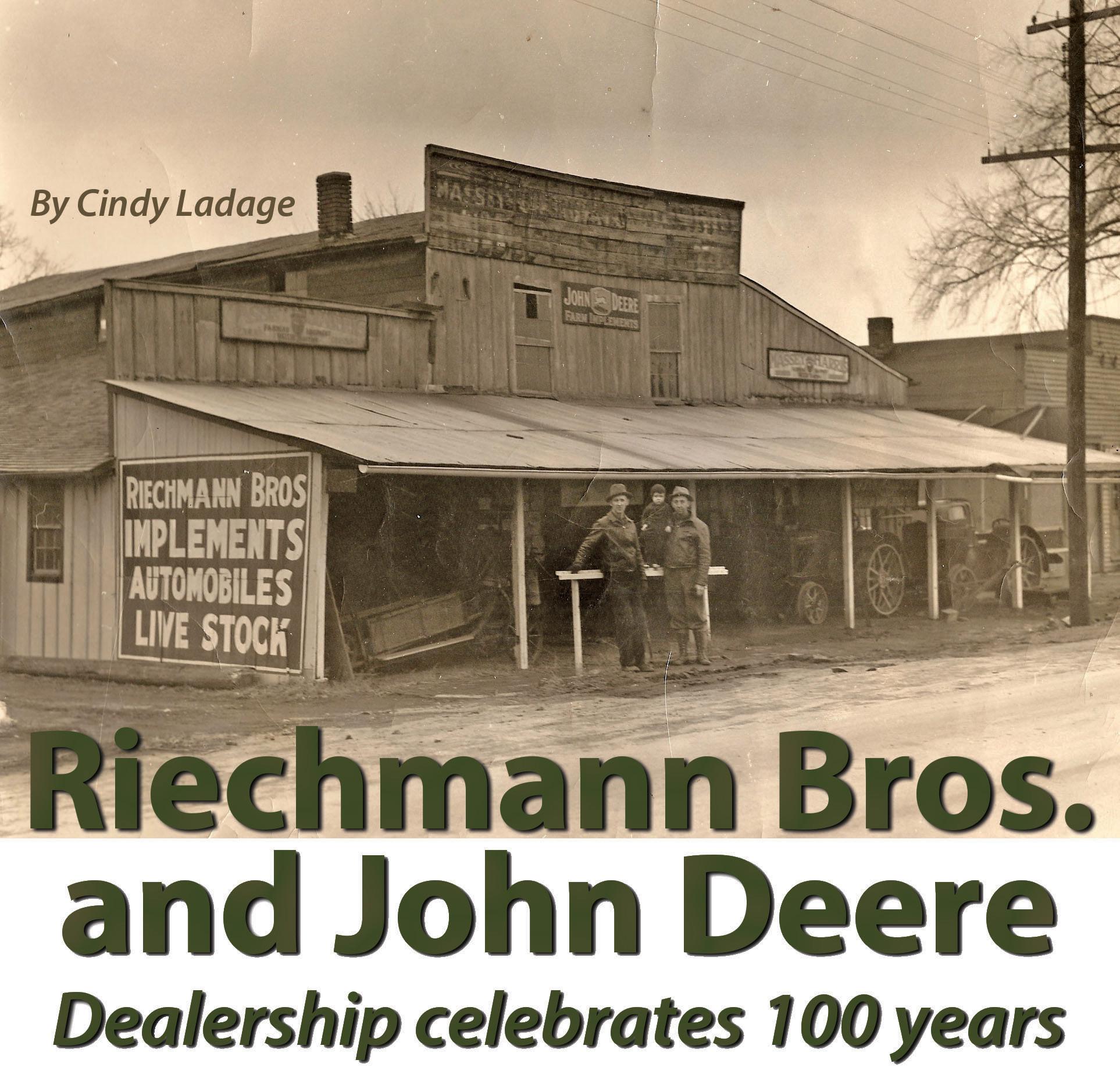
My friend and fellow John Deere collector, Mark Berkel, told me about Riechmann Bros. in Okawville, Illinois. This dealership is the oldest, continuous John Deere dealership in Illinois, and this past summer they celebrated their 100-year anniversary. Members of the Riechmann family shared the story about their dealership that has remained in the family since the beginning.
The Beginning
The story begins with Hugo and his brother Walter Riechmann. They founded Riechmann Bros. on December 23, 1922. “They borrowed $4,000 to
start the business,” Bill Riechmann Jr. shared. “They were the second generation of German immigrants.”
The brothers bought the business from C.H. Erke. Their website history states, “The first check stubs, which are framed on the west wall of the Okawville showroom if you come visit us, show that the first check was written to C.H. Erke, who had employed Hugo as a salesman the prior two years. The $3,400 check paid for the entire business inventory. The remaining $600 was left to do business as they had no money of their own.”
Loyd, Hugo’s son, said his ear-

liest memory is, “of being born and raised right here. Dad had worked in the blacksmith shop, and sold lightning rods, and whatever they could to make a living.”
Riechmann’s first sale was a buggy whip to his brother, William. At that time, they traded in buggies, converting them for farmers to use to haul milk cans and supplies.
When Hugo and Walter bought the business from C.H. Erke, they had contracts with both Massey Harris and John Deere. “I was born in 1937,” Bill Sr. said. “And Dad liked the Massey binder but didn’t care for the Massey
Page 10 April 2024 • Green Magazine
The Erke building, razed in 1938.
Harris tractor. He thought John Deere tractors were a coming thing.”
Both companies, Massey Harris, and John Deere, wanted the brothers to commit to selling just one of the brands. Since Hugo saw a future with the Deere tractors, they thankfully chose John Deere.
Roads were not easily traversed. Many were still using horses in those early days. So, both John Deere reps and the parts came to Okawville by rail. “Everything came on the train and arrived at the dock right here,” Bill Sr. said.
Loyd remembers the smoke from the trains. “Mother had to watch to take clothes off the line when the steam engine was coming because of the soot.”

The Riechmanns traveled to St. Louis to pick up parts and equipment after stopping to drop off livestock at the stockyards. Back then, some of the parts included grain binder parts, plows, cultivators, disks and hit and miss engines. “As a boy, I would go to St. Louis every week. We would take cattle in, and then go to 2212 N. Broadway at the warehouse to load equipment after washing the truck. We had a 1937 Dodge truck until we traded it for a 1947 truck that we still have. It had an Omaha bed on it with cattle racks that folded down.”
Livestock was an active part of the business. “We traded for a lot of horses, cows, and mules,” Bill Jr. said.
One trade in 1939 was six head of mules for a 1939 John Deere “A” trac-

tor. “When a man didn’t have money, he traded cows,” Loyd added. At the outset of World War II, they started handling more cows. It is interesting to note on the website they shared, “If a customer had a certain number of cows to milk, then he could keep a son at home. It was Walter’s job to feed the cattle, horses, and mules, and he was assisted by William and Loyd when they grew old enough. They remember the horses going to their stalls and cooperating, but the mules would bite, kick, and were a problem.”
During the war years, Loyd said they often would stay nights at the shop. “We sold gas and worked on cars and played a lot of pinochle. You didn’t have anything to do or spend money on.”
All metal was precious. Loyd added, “During 1943 to 1945, there were no automobiles built, the license plates were all cardboard. The government put a ceiling price on tractors during the war. At auctions, we would say, ‘If you want this tractor, put your name in this hat,’ then we drew to see who got it. They had money, but no tractors.”
There was a blacksmith shop during the ’20s and ’30s that kept the blacksmith busy sharpening plow shares and doing welding projects. The importance of the blacksmith shop is not overlooked. “The business evolved from the blacksmith shop to this,” Bill Jr. shared.
During the quiet winter months, Loyd said, “Dad collected iron and rags. There were no paper products back then, and the only toilet paper was Sears & Roebuck! My first six to eight years, we had no plumbing in the house.” They then sold the iron and rags for winter cash.
In 1928, Riechmann Bros. expanded into automobiles by buying the business next door. They sold Dodge and Plymouth models. “We sold a lot of tires too—the tread only lasted 3,000 miles,” Bill Sr. said.
During the ’40s and ’50s, they were known to sell as many cars and trucks as farm equipment. They eventually moved out of the automo-
Green Magazine® • April 2024 Page 11
The Riechmann brothers: Bill Sr. and Loyd.

tive business. “We sold Shell products too,” Bill Jr. said.
It took a while for customers to take to combines. “I just remember the end of the binders. A lot of people both combined and threshed. They thought they needed the straw pile,” Loyd said.
Loyd remembers when limestone came into play. “When limestone first came in, farmers would come in and scoop it into their wagons and spread it.”
Hugo told his sons that you could always tell who had used limestone to fertilize their fields and who had not because the dewberries grew well in fields without limestone. “The dewberry was a short bush crop you could pick and bring in and ship to the city.”
The second generation of Riechmanns took over when tragedy hit. Hugo Riechmann had a heart attack. His son, William, was only 21 and Loyd was just 15. “Dad died when I was 21,” Bill Sr. said. “I was sitting next to him in church on June 1, 1958.”
Second Generation
The boys had to step up to the plate. Bill said, “Dad and Mom’s first three children died. Then it was just my brother and me. Dad let us do just about anything. We were spoiled. But you knew what was right, and wrong.”
With a loving background and the help of their bachelor Uncle Walter who lived with them, they forged ahead. At first, though, Walter thought perhaps they should sell, but Bill said, “I want to keep going. Walter was good with parts. He said ‘Okay, we’d do our best’.”
Bill had experience selling from an early age. “I sold my first tractor when I was 13. It was a used JD ‘BR’.”
He sold it while his father was away at the DuQuoin State Fair. With Walter taking care of the parts and service, and William trading horses for tractors, business moved ahead.
Riechmann Bros. picked up parts at the St. Louis John Deere branch until the parts department there closed in 1953. This branch was only 45 miles away. They then got parts from Memphis, Tennessee, which was 4-1/2 hours away. Then, parts had to
The business’ main building until 1979.

be shipped from the East Moline, Illinois branch, which was 4-1/2 hours away. Next, Riechmann Bros. was moved to the Kansas City, Kansas branch, which was 4-1/2 hours away. John Deere Complete Goods continued out of the St. Louis branch until 1969, and Bill Jr. remembers going along on trips to pick up items at the St. Louis branch.
When the St. Louis Branch closed in 1969, Bill and Loyd purchased all remaining inventory after John Deere had moved out what they wanted. This stock inventory purchase provided Riechmann Bros. with tons of items, and they still have new in-the-box items from that purchase today. This buy included items that were shipped to the St. Louis branch from the New Orleans branch when it closed, and Bill Jr. said they acquired a few pieces of literature in French from that move.
There were a lot of equipment changes through the years. The first corn head was sold in 1958 because in the area they were still picking corn. Customers wanted to shell corn but had no storage so Riechmann Bros. entered the grain bin business until FS started selling bins, much to their relief.
“I remember the first draper head combines and thought how lucky we were to get rid of the draper combines for auger feeding combines,” Loyd said. “A few years ago when Deere came out with draper heads again, I was very concerned knowing how much trouble we had with them in the early days, but they turned out great.”
“We had wire balers with aircooled Wisconsin engines and sold a
lot of them. Farmers would not shut them off when they had lunch because they had trouble restarting the balers when they were hot,” he explained.
D-Day in Dallas
“I got along with the big wheels. I knew Bill Hewitt, and met Charles Wiman once,” Bill Sr. said. “I was married in 1959 and had never been on an airplane. The first time was on a plane to Dallas.”
In August of 1960, William had the opportunity to attend the John Deere event that unveiled the New Generation tractors in Dallas. “John Deere chartered a plane out of Lambert Field. Only one person from each dealership could go. I went by myself. I took off and got to go up in the cockpit and talked to the pilot.”
This was a TWA flight: “We flew into Dallas, then it was a two-hour drive on a bus.”
More than 5,000 dealers attended and he was one of the youngest ones at the age of 22! “The first day they didn’t show us anything. That night the Rockettes from New York danced and sang. They said tomorrow we will show you something you have never seen before. They then introduced the New Generations, one at a time with dancers for each tractor. It was quite a production.”
“Not long after Dad died, twocylinder tractors ended,” Loyd added. “We had to convince ourselves that we could sell the New Generation tractors.” Bill Sr. said that he was worried because he had been touting the glories of two-cylinders to his customers.
Loyd recalls that his father only
Page 12 April 2024 • Green Magazine

sold one John Deere “D” tractor; the “GPs” were the big sellers. “The GP was the first tractor I ever drove.”
It wasn’t long before Bill ordered the New Generation tractors; in fact, there is a picture of the first shipment in the showroom. “The first New Generation tractor I sold was a 2010. Within a week, I sold one of each size, except for the 1010 and 5010,” Bill Sr. said.
“The New Generation tractors put us on the map. The John Deere technicians and services are what kept us in business. Their support has been very good,” Loyd added.
The Auction Business
When Loyd turned 18, he went to auction school in Mason City, Iowa in 1960. “I went in a Greyhound bus, and it stopped every five miles,” Loyd recalls.
He held his first auction that same year. “I hired my math teacher to be my cashier,” Loyd said.
Since then, they have offered auctions over the years and started a tradition of a consignment auction in Okawville Park on the third Saturday in March, and third Saturday in August. This is still a huge sale, and today Loyd’s son, Michael, and nephew, Keith, are also auctioneers. “We used to have auctions every Saturday, but now we have the two big sales a year. Four auctioneers run it and we have several hundreds of items and antique tractors are a good addition. The auction draws a crowd from Iowa to the East Coast, Mexico and Belize.”
In Mexico and Belize, there is a large German Mennonite population that comes to the auction, Loyd said.
Today, Bill Sr. is 86, and Loyd is 80. Loyd still runs the auction business,” Bill Jr. said.
Expansion
Riechmann Bros. expanded into its third and current building in 1979. The older building was still used, but then just recently suffered the partial loss of the roof from a tornado. “The original building was built in 1939 with additions in 1948 and 1949.”
“For 30 years when we didn’t know what to do with things, we put
them in the old shop,” Bill Jr. explained. He added that is how they ended up with so many new in the box parts, models, signs, etcetera: “Old Germans never throw anything away. I found the first check ever written by us just a few years ago.”
Riechmann Bros. acquired their Breese dealership in 1988, Centralia in 1998, Farina in 2017, and built a new Breese dealership building in 2021 that opened in 2022. Today they continue selling combines, tractors, hay and tillage equipment, and they have expanded to add lawn and garden and utility vehicles.

Third and Fourth Generations
Several members of the third generation are involved in the business. Members of the third generation in the business working are all of Bill’s children: William, Kevin, and Keith Riechmann, and Donna Rabenort; and all of Loyd’s children: Mark, Michael, and Matthew Riechmann. “My sister, Donna, she’s the oldest,” Bill Jr. said., “and she came into the business 15 years ago.”
“My first job was herding sheep,” Bill Jr. said. “There were a lot of weekend farmers that came to the junkyard. The sheep kept the grass down. We would let the sheep out into the used equipment lot to eat grass, and it was mine and my sister’s job to keep them off the highway.”
The sheep and the yard are still part of the operation today.
The fourth generation is also now working at the dealership. Bill’s grandchildren—Kirk, Trey, and Logan Riechmann and Lance Rabenort—all work full time. Loyd’s grandchildren working full time are Zachary and Reed Riechmann.
The family has some collectible tractors like the John Deere 40 utility that Bill Jr. said: “It was our first loader tractor, and it never was sold or left the store.”
They also found that John Deere “D,” the only one that Hugo Riechmann sold, and they have restored it. They bought it from the late Verlan Heberer when he decided to sell a few tractors. “He sold it back to us for about what he bought it for,” Bill Jr. said appreciating Verlan’s kindness to return the tractor to the family at a good price.
“We have the 3300 combine with no cab that we first sold to Loyd’s father-in-law, Morey Stieg.”
Bill Jr., is also an antique tractor puller and has two beautiful John Deere pulling tractors. In his home, Bill has a wonderful collection of memorabilia, and a display case that was once in his other grandpa’s store in Covington, Illinois.
At the 100th anniversary celebration, their family brought out their 1927 Dodge and cool 1946 Jeep that Loyd said they used as a service truck. “My brother, Keith, and I tore it down to the frame,” Bill Jr. said.
During the celebration, one lucky visitor won a John Deere “A”!
Moving Forward
While Cherishing the Old
While many things have changed over the years, the Riechmann Bros. still cherish their history. Many items are collectible, like an original model of a patio set in an original box. Then there are family heirlooms like the desk originally used by Hugo, and more. A walk through the showroom and buildings brings a view of still new in the box John Deere parts, pictures from the past, and pieces of equipment reminding us of the 100 years of continuous service they have provided and continue to provide today. In fact, in 2022, they were named dealership of the year!
For more information about the dealership, check out their website at riechmannbros.com
Photos for this story provided by Bill Riechmann Jr.
Green Magazine® • April 2024 Page 13

DECALS
Our vinyl computer cut decals are a Licensed Product of Deere & Company.
• For John Deere tractors & equipment!
• Looks like silk screening.
• Pressure sensitive die cut vinyl.
• No film between the letters...they are on pre-spaced application tape.
REPRODUCED PARTS
• Nameplate for 1010 thru 7520, stamped, raised letters, like original.
• Medallions for styled AR through 830, including industrial tractors. Also medallions for steering wheels, power steering and non power steering.
• Correct size medallion: 320, 420, 520 USA made.
• D306R D manifold gasket.
• F55R early G head gasket.
• Air stacks for A, AR, AOs & B, BR & G unstyled tractors; also styled A, B, G, R, 80, 820.
• Air stack adaptors for 620-630 & 720-730.
• Tool boxes.
• New valves and guides: GP, D, G, A, B.
• Replacement upper and lower water pipe for 2 cyls.
• Flat top fenders 530-730, New Generation.
• Clamshell and also New Gen Hi-Crop fenders.
• BO Lindeman steps, side plates and fenders.
• PTO shields & casting 520-730.
• GP dust shields for brakes and muffler parts.
• Grill screens, back and seat cushions, arm rest.
• Spark plug wire looms for A, B, G, BR, BO & AR, AO.
• New radiator cores for John Deere and other tractors that use bolt up type radiators (made in USA).
• Wire hose clamps for unstyled A, B, G, 50-630 & 80-830.
• Reproduction steering wheels A-830 and New Gen.
• Early D & GP fuel tanks.
• We carry new parts for Wico mags, also for pony motors.
• Rebuilt mags and carbs for sale.

These exhaust pipes are made with smooth mandrel bends like the originals MADE IN
We make styled and unstyled A, B, G, GP Top Steer and 50 through 730D.
4 MUFFLERS
D, AO, GP, GPO Spark Arrestor Style
D, AO, AOS, BR, BO
A, AR, B, G Styled and Unstyled
50 through 730D
50 through 530 horizontal, 60, 620 Orchard Made in USA
• Restoration Quality

4 AR28048, AR28049 NAMEPLATE
Stamped, polished aluminum like originals Fits 1010 through early 7020

steel w/chain - 2 cylinder
AR52623, plastic w/chain - New Gen
4 AR45915 RAIN CAP
Fits 3020-4020 side console models
4 CHROME STACKS
Double walled, straight or curved
4 “ NEW” BATTERY TRAY
For 4000 model with brackets
SERVICES AVAILABLE
• We bore and sleeve JD 2 cylinder blocks.
rebuild
• We
carbs and mags for JD & other tractors.
Overseas shipping available - call today! K & K Antique Tractors Kent Kaster 5995 N. 100 W, Shelbyville, IN 46176 Ph. 317-398-9883 Check out our website: www.kkantiquetractors.com Email: info@kkantiquetractors.com 4 T10551 NAMEPLATE Like original, stamped polished aluminum with raised lettters, flat black background Each 3-3/8” x 27-3/4” • $140.00 per set plus S/H 4 HYDRAULIC OUTLET PLUG AF3001R,
USA
Green Magazine® • April 2024 Page 15


As the agricultural tractor went from a novelty to a necessity on American farms, the farms themselves began to change in reflection of the power and efficiency that tractors could provide. Farms grew bigger, first tearing up the pasture and hay land once needed to feed draft animals. Then they began to break new ground. Many of the smallest farms bought more land or sold their own to another farmer eager to work a larger area. With larger farms came the demand for more powerful tractors, and the cycle continued. Between the 1920s and the 1950s, the horsepower of Deere’s most popular tractor more than doubled, and it continued to increase from that point to the present day.
Deere’s engineers were already busy planning and designing what would become the New Generation tractors in the late 1940s. By the early 1950s, they had built a few experimental tractors. As time and test-

ing went on, it was realized that it would take still several more years of research before the new tractors were ready for production. So it was decided that another generation of tractors would be issued between the numbered series and the New Generation. The first focus of this set of tractors for both company and customer would be more power. A
Bryce Heithold of Wayne, Nebraska owns this 1958 model 620 row crop with wide front. Many 20 series tractors used the larger 30 series muffler after they were introduced.

Page 16 April 2024 • Green Magazine
20 percent increase in power was anticipated across the board, so Deere created the 20 series.
The 620 was created to replace the model 60—the middle child of the lineup. The 620 was a four-plow tractor that could also work four or six rows of crops, but was a bit lighter, cheaper, and more efficient than the 720 for those farmers who didn’t need its extra power. It was versatile and maneuverable and fit well with a loader, a blade, or just about any other piece of equipment for work around the farmyard. It hit the market in the fall of 1956.
The 20 percent increase in power for the 620 came through an increase in engine speed. To accomplish this and maintain reliability, Deere shortened the engine’s stroke from 6-3/4 inches to 6-3/8 inches. The bore remained the same at 5-1/2 inches. The steel pistons were replaced with lighter aluminum ones. The rod, main bearings, crankshaft, and connecting rods were all bulked up to withstand the extra power. A new engine block was created for the more powerful engine. The petcocks (or the space for them) was eliminated, since electric start was now a standard feature of the tractor. The spark plub holes were moved to the cylinder head. An extra stud and two pins were added to the block to improve the seal between it and the head. Leaking head gaskets were much less frequent after this change than they had been in the model 60.
Deere’s engineers further increased power through an improved combustion chamber. The ports and manifolds for the engine were also revised and improved, providing superior air movement through the engine. Valve rotators were added. With these, the valves wore more evenly and at a slower pace and deposits built up on them less than before. Compression in the engine was able to be increased without any knocking.
Of course, all of these improvements couldn’t be made without
also increasing the refinement of the electrical system. The distributor was moved to be driven at half speed by the crankshaft. At half speed, the spark plugs only fired on every compression stroke but not the exhaust stroke. The points and the plugs had their longevity doubled by this change. Having the distributor run at half speed also increased its precision, allowing for tighter ignition tuning and more power.
With everything put together, the engine now produced 48.68 horsepower at the belt and the LPgas engine made 50.34 horsepower. These figures were very close to the 20 percent increase that Deere had planned for the tractor. It is also important to note that both of the engines set new records for economy when they were tested at Nebraska.
The boost in power created a need to improve other parts of the tractor, since they would now be under more stress than before the upgrade. The rear end gear ratios were altered because of the engine speed change. If left alone, the travel

speed of the tractor would have increased. Deere changed them to keep ground speed the same. Gears and bearings in the rear end were strengthened, and the final drives were upgraded with a wider differential pinion. The bevel gears for the PTO were enhanced by mounting them in anti-friction bearings, reducing power loss and increasing their longevity. The clutch pack for the PTO was upgraded from seven disks to nine, and Raybestos woven material was now used in them.
On the topic of the PTO: the transmission-driven PTO was eliminated with the release of the 620. There was little demand and even less utility for the setup. Only the “live” PTO was offered for the 620. Furthermore, every tractor was built with the PTO internals already in place, so farmers who decided down the road that their tractor needed a PTO found it easy to add one. The PTO was operated by a foot pedal on these tractors and included a neutral position that made it possible to spin the PTO by hand to ease alignment of the splines on the shaft

Green Magazine® • April 2024 Page 17
Dean Vinson’s 1958 620 row crop is still hard at work.
to a piece of equipment.
Bypass starting was built into the 620. A full 12 volts was sent from the battery to the coil during ignition, providing maximum spark during startup. When the starter was disengaged, the tractor sent only six volts to the coil. Spark was still ample to avoid misfire, but the longevity of the electrical system was improved since it mostly ran at the lower voltage.
Deere revised the front end support for the tractor. They made it heavier for better balance and added attachment points for a new front weight package and a front-mounted rockshaft. Tractors with power steering had a heavier front end because of the system and showed better balance than tractors with manual steering. So Deere added 100 pounds of weight to the front pedestal on tractors with manual steering to better match power steering tractors and their superior balance.
Larger brakes and a larger fuel tank were the final standard improvements to the 620 over the 60. The sheet metal remained the same from the previous generation, but Deere included a yellow stripe painted down the hood and grill sides. This stripe served to differentiate the new series from the old. It also happened to draw in the eye and made more than a few farmers jealous enough to paint a yellow stripe down the side of their model 60. Deere also created a new front grill medallion to complete the new look.
A universal three-point hitch was finally available to Deere customers. Henry Ferguson had held the patents on the three-point but they had expired and Deere took advantage. A new type of rockshaft was built into the 620 for the threepoint. The tractor benefited with more accuracy for the tools attached to it and more work capacity on the three-point.
Deere initially created three different chassis types for the 620.
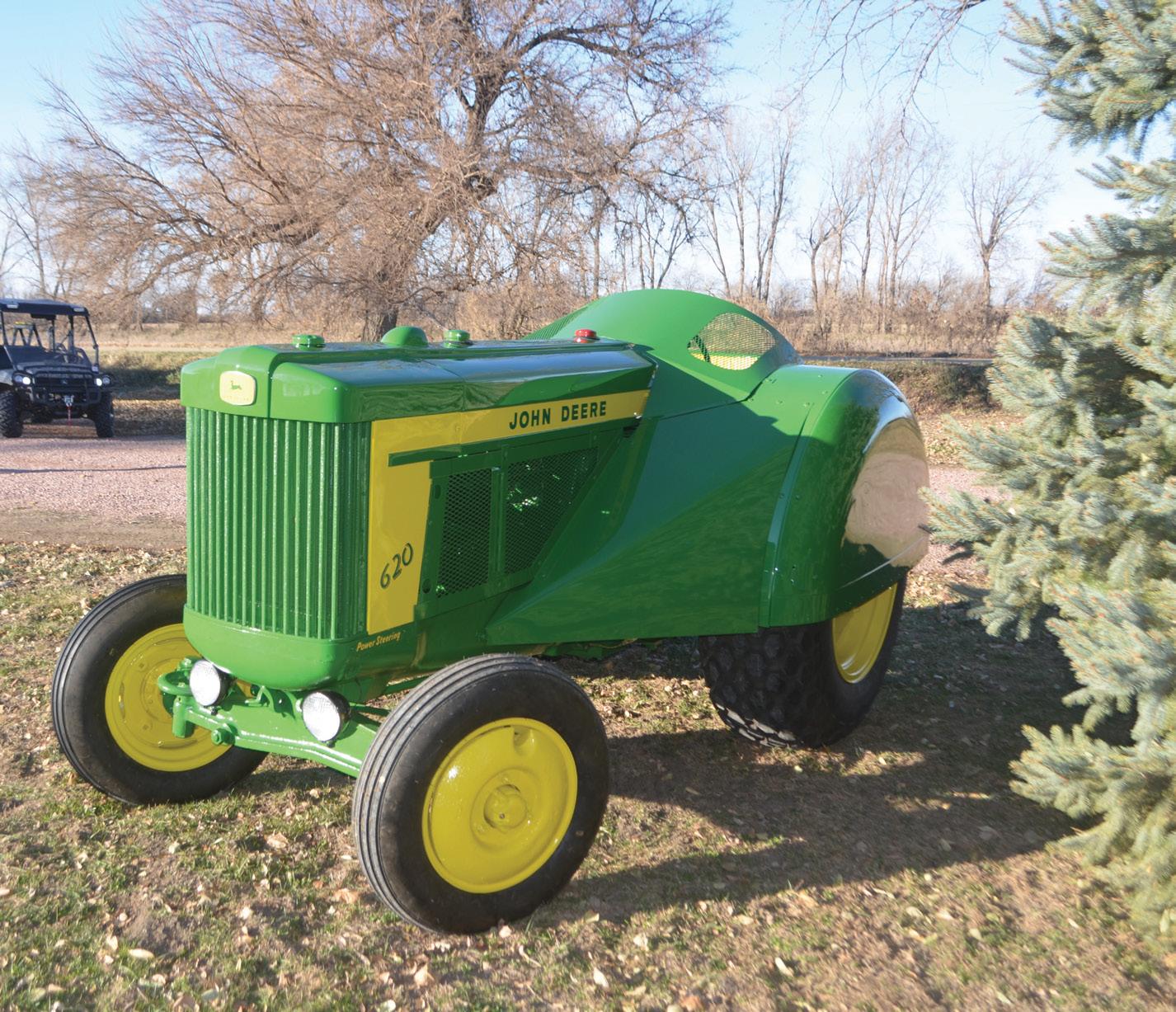
The most popular, by far, was the row crop model. Many combinations of axles, wheels, and tires were offered for the 620 row crop. The standard equipment was a solid narrow front end with 6.00-16 inch front tires and 12.4-38 inch rear tires. 13.6-38, 15.5-38, and 11-42 inch rear tires were available. 11-38 and 12-38 “open” or “closed” tread rice and cane tires were also available for the rear. A “dish” style cast offset wheel was also available for the 620 with any tire size.
The standard rear axle was adjustable from 58 to 88 inches. A long rear axle was an available option, and it allowed tread from 62 to 98 inches. Equipped with offset rear wheels, the tractor could set six inches narrower or wider than these measurements. Deere also offered an extra-long rear axle with range spreading from 61 to 120 inches. This axle was installed by the dealer, not at the factory, and Deere had a stated load limit for a tractor with this axle and wheels set to full width lest it bend or break the axle or put too much strain on the bearings.
At the front of a 620 row crop,

the farmer could replace the fixed narrow front with a Roll-O-Matic narrow front, a single front wheel, a 38 inch fixed-tread front end, or a 48 tp 80 inch adjustable “square” front axle. All two-wheel front end options came with 6.00-16 inch six-ply front tires. The single front wheel was either in 9.00-10 or 7.50-16 inch size. Deere still offered steel wheels for front, rear, or both.
Deere also built the 620 in a standard tread version. This tractor had a lower center of gravity and a fixed front axle. It created a more stable tractor and was a good platform for small grain farmers. The tractor was on 13-30 inch rear tires and 6.00-16 inch front tires on a 551/2 inch width front axle. 14-30 and 15-30 inch rear tires were available, with the 15-30s on either 14 or 16 inch rims and in regular tread or rice and cane. The front axle could be replaced with an adjustable version allowing spacing from 52 to 68 inches, and 6.50-18, 7.50-18 and single-rib 7.50-18 inch tires were available on either front axle. As on the row crop, steel wheels were available on the standard tractor.
Finally, there was the 620 Hi-
Page 18 April 2024 • Green Magazine
Dan Kaler’s 620 orchard.
Crop. Deere had been building an extra tall version of some models of their tractors for decades and they were not about to quit. The 620 HiCrop had 12.4-38 inch rear tires and 7.50-20 inch front tires, but could be ordered with 13.6-38 inch regular tread or 12-38 rice and cane tires. Deere did not offer any axle options for the tractor, but radius rods were offered for a price and gave a bit more support to the front axle.
Many options were offered for the model 620. The most exciting of these was custom Powr-Trol. This allowed full control of up to three separate hydraulic circuits, each with unmatched accuracy and finesse. No other manufacturer could provide so much precision to a farmer and his implements. Tractors equipped with custom Powr-Trol came with a rockshaft installed. Single or dual hydraulic controls were extra. The row crop and standard tread tractors had a universal three-point hitch as an option, while the 620 Hi-Crop had a special three-point hitch option. There was the option of leaving the rockshaft off of the 620 standard. In this case, the tractor could still
have remote hydraulics installed. The row crop and Hi-Crop tractors could be equipped with a solid or split front rockshaft. The Powr-Trol on tractors with a front rockshaft could be set up to perform a delayed lift. This caused the rear-mounted equipment to be raised later than the front-mounted equipment, with the aim that the delay would cause both sections of the implement to come out of the ground at approximately the same point in the field. The neat thing about this was that it was all done with a single hydraulic cylinder.
Power steering was another very popular option. Deere’s was easily the best power steering system on the market. In situations where steering was traditionally difficult, the system shined, making steering all but effortless even when the front of the tractor was heavily loaded, was moving slowly, or was in wet ground or a rut. In optimal condition, Deere’s power steering was still fantastic, as it made steering so light and responsive that it went from being a chore to an afterthought.

The Float-Ride seat made its debut with the 620. This seat added adjustable rubber torsion springs to the seat as a suspension. These springs allowed the seat to move somewhat independently of the tractor, isolating the operator from some of the bumps and jostles that the tractor ran over. The Float-Ride seat also provided some fore and aft adjustment, helping the operator find a more comfortable position for his ride. Deere may have been exaggerating when they claimed that the seat made “fields seem superhighway smooth,” but it was certainly an improvement over what came before.
Other options for the tractors were a “live” 540 RPM PTO, electric fuel gauge, speed-hour meter, precleaner, vertical air stack, rear exhaust, heavy duty batteries that provided 30 more amps, cigarette lighter, front frame weights, front wheel weights, rear wheel weight packages, heavy-duty drawbars for the Hi-Crop and standard tractors and a foam rubber seat cushion. Row crop tractors could have clamshell fenders. High altitude pistons
At the time this photo was taken, the beautiful collie and 620 standard were both owned by Louie Bartley.
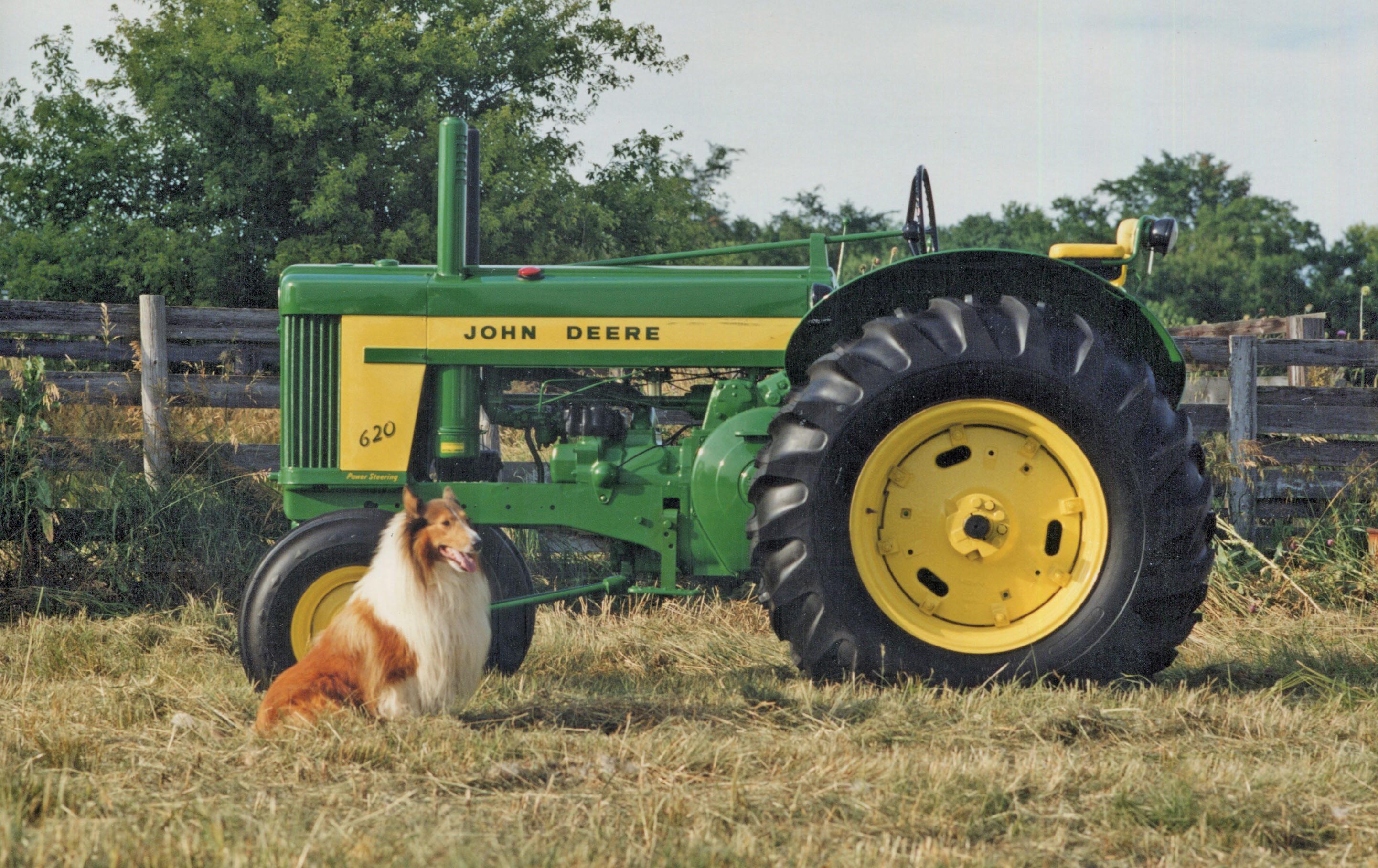
Green Magazine® • April 2024 Page 19
for gasoline and all-fuel tractors were automatically installed by Deere when the destination of the purchased tractor had an altitude over 3,000 feet. Deere did not charge for these.
The gap in power between the gasoline engine and the all-fuel engine in Deere’s tractors was widening. In the 620, the all-fuel engine could create only 32 horsepower— about 70 percent of the gas engine. This fact was causing the interest in the all-fuel engine to wane, especially as the price difference between gasoline and distillate fuels was shrinking. Deere still sold all-fuel engines, but tractors ordered with them were now less common than ever before.
About 13,000 model 620 tractors were built in the first year of production. The public was very excited by the machines and so they sold quite well and were successful at work. Deere had thought of a way to entice even more buyers however, and released the 620 orchard in May of 1957. Deere had continued to build the model 60 orchard even while the 620 was being sold. This gave grove and orchard growers a Deere tractor to buy, even though it was a slightly out-of-date one.
The 620 grove and orchard tractor was the beneficiary of all of the improvements that had been built into the rest of the model 620 tractors. Deere also added a speedhour meter and electric fuel gauge as standard equipment. Options for the tractor included the Float-Ride seat, “live” 540 RPM PTO, heavy duty drawbar, rear exhaust, and a cigarette lighter were all optional. The 620 grove and orchard did not have enough room to fit the “advanced” power steering system, but Deere could put a cylinder-assisted system on the tractor. This was not as nice of a setup, but it made the 620 the first of Deere’s orchard tractors with any available power steering. Other options for the tractor included citrus fenders, fender sides, engine side shields, and an opera-
tor’s shield. The full set of these cost $189, but they could be ordered separately in whatever combination was desired.
A 620 orchard in full shields is quite a site to behold, but they are quite rare. Many orchard tractors were purchased with few or none of the shields, and many more lost their shields over the years when they were removed and never returned. So if you are interested in finding a 620 orchard for your collection, don’t be surprised if you struggle to find the shields for one.
The 620 orchard had 13-26 inch rear and 6.00-16 inch front tires. 1426 inch rear and 7.50-16 inch front tires were available on the options
list. Regular and diamond tread were available on any of these tires, making the purchaser decide if traction or smooth ground was more important. The 14-26 inch rear tires could be installed on 16-inch rear rims for enhanced flotation. Again, steel wheels were available to those who wanted maximum gripping power.
Deere had a bit in store for the 620 for the 1958 model year. At serial number 6213100, sealed beam headlights replaced the older headlamps. The power steering and clutch were both updated and improved. A new, larger steering wheel covered in plastic was outfitted. The muffler was replaced by a part that
620 Row Crop Production Numbers and Serial Number Breaks
620 Standard Production and Serial Number Breaks
620 Orchard Production and Serial Number Breaks

620 Hi-Crop Production and Serial Number Breaks
Year Beginning/Ending Gas All-Fuel LP Total 1957 6200000-6213099 10,468 266 1,614 12,348 1958 6213100-6222686 6,302 182 642 7,126 Totals 16,770 448 2,256 19,474
Year Beginning/Ending Gas All-Fuel LP Total 1957 6200195-6213099 607 18 31 656 1958 6213100-6222524 281 13 5 299 Totals 888 31 36 955
Year Beginning/Ending Gas All-Fuel LP Total 1957 6211100-6213099 28 25 22 75 1958 6213100-6222686 40 21 18 79 1959 6223000-6223156 26 116 39 181 1960 6223157-6223247 7 24 5 36 Totals 101 186 84 371
Year Beginning/Ending Gas All-Fuel LP Total 1957 6201604-6211168 10 7 4 21 1958 6213508-6222550 12 11 4 27 Totals 22 18 8 48
Page 20 April 2024 • Green Magazine
had stainless steel on the interior to help reduce rusting. Ball-joint tie rod ends were installed on the standard and row crop tractors. Deere also decided to begin painting the dash panels in black instead of green, and these tractors are often now referred to as “black dash” 620s.
New options for the 1958 model 620 included power-adjusted rear wheels for the row crop tractors. These made changing the rear wheel tread much easier and allowed a range from 56 to 94 inches. The power-adjusted wheels were available with 12.4-38, 13.6-38, or 15.5-38 inch tires. The 620 row crop gained a step as standard equipment, where it had been just an option before. A heavy duty Roll-O-Matic front end with 7.50-16 inch tires joined the options list partway through the model year. 18-26 10-ply road grader tires were also available for the model 620. These were mostly aimed at industrial customers.
The 630 was released and replaced the 620 in July of 1958, marking one last half-step between the two-cylinder era and the New Generation tractors. The 620 orchard tractor continued to be produced beyond this date, however, and was not terminated until 1960. Deere felt that it was cost prohibitive to create a 630 orchard, but they did add a few of the improvements from the 30 series tractors to the 620 orchard.
The 620 sold very well. Because no diesel version of the tractor was produced, it sold extremely well, and nearly matched the 720 in sales numbers. A total of 22,532 620 tractors were built in all, and over 21,000 of those were row crop machines. Obviously, then, a 620 row crop is quite a common tractor. This also means that the three other chassis types were divided between just 1,000 tractors. Only 48 of the 620 Hi-crops were built, and just eight had LP-gas engines, making some 620s extremely rare.
In February 1958, Deere tooled up their Monterrey, Mexico assem-

bly plant to build about 40 model 620 tractors. These tractors were numbered from 6217400 to 6217439. Deere sent kits to the factory where they were put together into complete tractors. Most of these tractors were row crops with all-fuel engines. A few may have had gasoline engines, though. Deere added the words “John Deere de Mexico” to the serial number tags, but the tractors are otherwise basically identical to a tractor built in Waterloo.
Deere’s industrial version advertised and sold the model 620 to its customers. Most of the machines that they sold were standard tread tractors, but were little changed from any agricultural machine. There is the possibility that Deere sold a 620 to an industrial firm who wanted it painted in industrial or John Deere yellow, but there is no evidence showing that happened and no tractor painted that way has been unearthed. So, if you happen to find yellow paint on your 620, it is almost definitely a result of the yellow primer that Deere was using in this period. The sheet metal on

these tractors often did not have that primer on them so again, don’t be surprised if the yellow only shows up on certain parts of the tractor. Furthermore, Deere painted every tractor with a yellow stripe down the side of the hood. They did not paint them white. Any tractor with a white stripe has simply had the yellow paint bleached to that color by their time in the sun.
Model 620 tractors with a serial number prior to 6213100 should have green dash panels and black generators. After that serial number, the tractors would have black dashes and green generators. All tractors had black headlight housings and seats of either black or yellow—picked by the customer.
The 620 is another one of those tractors that is the quintessential two-cylinder John Deere machine. Besides being reliable, powerful, and versatile, the 620 is what many people picture when they close their eyes and think “classic John Deere tractor.” The tractor fit a wide range of farms in its day, and it would fit into a wide range of tractor collections today.
A restored 620 Hi-Crop.
Green Magazine® • April 2024 Page 21

5010,
Dust Shields
5010 Right, AR35334, $320 5010 Left, AR35335, $320
5020, 6030 RC Right, AR40930, $350
5020, 6030 RC Left, AR40931, $350
5020, 6030 Whd R, AR36772, $350 5020, 6030 Whd L, AR36773, $350
Rock Shaft Cover
5010, 5020 Right, R36420, $295
5010,5020 Left, R36422, $160
5010, 5020, 6030 Center, AR55756, $70
6030 Right, AR55755, $295
6030 Left, R51485, $160
Toolbox Cover
5010, 5020, 6030 - AR35050, $65
Hood Air Cleaner Cover 4050, 4520, 7020 - AR43256, $165
Hydraulic Dipstick Cover 5010, 5020, 6030 - R36421, $80
Step w/Pads
5010, 5020, 6030 - AR40914, $165
Step U Bolts $18
Seat Base Cover for Tractor w/o Rock Shaft - AR26846, $295
4000 & 4020 Std SN 201,000 & Above
AR40773 LH Rear Eng Panel = $80
AR40774 RH Rear Eng Panel = $80
AR40871 Platform (can modify AR48727) = $155
AR41097 Platform Support = $84
AR41098 Platform Support = $84
AR41137 Dust Shield RH = $315
AR41138 Dust Shield LH = $315
AR41174 Support To Dust Shield=$27
R41253 Ext Front Right = $156
AR41451 Ext. (RH) = $74
AR42594 Step Bracket w/2 pads = $215
F3195R Step Pad = $30
AR42989 Cover Battery Box = $80
AR45129 Battery Box Support = $75
AR45130 Battery Box Support = $75
AR45131 Ext L Ft AR48964 = $184
AR45207 Battery Box = $340
AR46289 Weight Bracket = $102
AR48964 Ext L Ft AR45131 = $176
3020 Standard Tractor
R34944 Floor Panel 3020 Std PS
R34943 Floor Panel 3020 Std PS
AR34801L Dust Shield = $325
AR34801R Dust Shield = $325
R42893 Fastener Pin for Battery Box = $36
Dave Haala: dave@haala.com or 507-920-9181
22 April

Burrey Carburetor Repair • We rebuild ALL John Deere models • We make carburetor parts no longer available from Deere • Single & dual induction bottom repairs • To personally drop off your carburetor, please call for an appointment • WE STOCK carburetors—rebuilt and ready to install on your tractor • ALL carburetors carry a 1 year guarantee • ALSO BUY, SELL & TRADE CARBURETORS Burrey Carburetor Repair Kurt & Mindy Bleke • 5026 Maples Road • Fort Wayne, IN 46816 Tollfree: 800-287-7390 Phone/Fax: 260-447-6347 Website: www.burreycarb.com Email: info@burreycarb.com 9 AM to 6 PM EST M-F • Saturday 9 - 12
Bracket
Fabricated tractor parts - Dave Haala Tractor Parts We Fabricate Weight
5020, 6030: AR58358, Pr $320
Engine Panels
Right, AR43290, $155
Left, AR51804, $255
Right, AR38206, $300
Left, AR38207, $220
Right, AR38838, AR38202, $300 2520 Left, AR38839, AR38203, $220 5010, 5020 R, AR35023, $300 L, AR35024 OR AR36796 $300
AR53645, $350 6030
AR53646, $350
Rear
4620
4620
2510
2510
2520
6030 Right,
Left,
Page
2024 • Green Magazine

Lakeside Service & Supply
New and Used Parts for Vintage JD Two Cylinder Tractors
We ship parts daily!
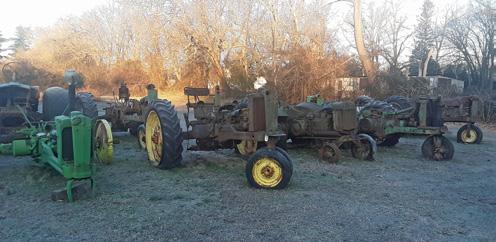
Lakeside Service & Supply
325 S. Main Street • Elmer, NJ 08318 856-358-2444
deereblaze@verizon.net
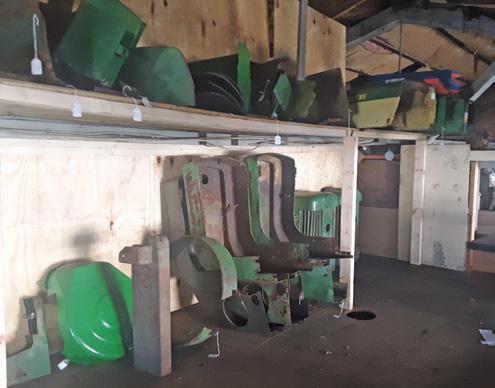
Like us on Facebook!
Visa/Mastercard/Paypal accepted

Wiring Harnesses - Cables - Switches
We build restoration quality wiring harnesses to fit these John Deere models and their variations:
AG Models: A, B, D, G, GM, L, LA, M, R, 40,
50, 60, 70,80, 320, 420, 430, 435, 440, 520, 530, 620, 630, 720, 730, 820 2 cyl, 820 3 cyl, 830 2 cyl, 830 3 cyl, 920, 1010, 1020, 1520,
1830, 2010, 2020, 2030, 2040, 2040, 2130, 2240, 2350, 2355, 2440, 2520, 2550, 2555, 2630, 2640, 2840, 2855, 2950, 2955, 3010, 3020, 3150, 3255, 4000, 4010, 4020, 4030, 4040, 4050, 4250, 4230, 4240, 4430, 4440, 4455 Mexico, 4630, 4640, 4840, 5010, 5020, 6030, 7020, 7520, 8010, 8020, 8430, 8630, 8440, 8640, 8560, 8760, 8960, 8770

Harnesses available for other models & brands
See website for complete listing
Due to numerous variations, call to order Shipping/handling not included
Visa, MC & Discover accepted
Prices subject to change without notice
Circuit protection kits for Diesel tractors
From $35 (2 cylinder)
From $60 (New Gen)
Industrial Models: Al, Bl, DI, 300, 301, 302, 302A, 310A, 350, 350B, 350C, 380, 400, 400 Scraper, 400B, 400C, 401, 410,
410C, 410D, 440I, 450, 4508, 450C, 450E, 455E, 480B, 500, 500A, 500C, 510D, 540E, 544A, 548E, 600, 7E Scraper, 700, 700A, 710D, 750, 755, 840, 1010C, 1010W, 2010C, 2010W, 3010I, 4010I AG Machinery: 45, 55, 4710, 5730, 5830 Lawn and Garden: Commercial mowers: 38”, 48”, 54”, GX1320, 727 Z-Trak, 60, 70, 110, 112, 120, 140, 200, 208, 210, 212, 216, 245, 300, 312, 314, 316, 318, 285, 320, 322, 330, 332, 420 Compact Tractor: 790, 850 Snowmobiles: 340 Cyclone We also carry: Starters, Regulators, Generators, Alternators, Relays, Coils, Lights, Alternator Brackets, Pulleys We make alternator conversion harnesses Call for a FREE 100 PAGE CATALOG! CALL: 716-937-6618 • WORLDWIDE SHIPPING International phone: 001-716-937-6618 Email: agriserv@rochester.rr.com 13899 North Road, Alden, New York 14004 www.wiringharnesses.com Green Magazine® • April 2024 Page 23


I am not real sure where I got the idea to commemorate the 10th anniversary of Green Magazine with a model tractor, but as some of us so often say about bad ideas, “It seemed like a good idea at the time.” There are two basic ways to offer a tractor, and both will subject you to criticism. You can either take a shelf model and change the wheels or add a cab or some other accessory and apply a commemorative sticker. The other way is to pay someone

to develop a new model. This involves making patterns, having the parts cast, assembling them, painting them, adding wheels, and decals, etc. If you do the first, people will say, somewhat rightfully so, that it’s just a shelf model with a sticker, and ask why you didn’t offer something new. If you do the second, many will complain that they are too expensive and only those born with a silver spoon
in their mouth can afford them. We chose the second option, and hired Paul Stephan to create our commemorative tractor. Being that it was our 10th anniversary, no one had built a toy of this model and I was really into collecting 10 series tractors, having the model be a 1010 seemed like a no brainer.
We began taking orders for the models in January of 1995 at a retail subscriber price of $199. Yes, some people complained that they were too expensive. We sold about 500 of them though, and if we made any profit on the endeavor, it wasn’t much. Notice we never did it again. Actually, eight or nine years later, Bill Proft (who by then had begun writing toy articles for us) asked if he could investigate the possibility of a tractor to commemorate our 20th anniversary. Though a bit skeptical, I told him to go ahead and investigate if he wanted to. I believe he contacted Deere, Ertl and maybe some others but soon grew so frustrated with the whole process that we put the whole idea to rest.
One of the big events of the 1990s was the Wheatland Poppin’ Johnnies indoor swap meet and tractor pull held at the Kansas Coliseum Pavilion in Wichita, usually the last weekend of October. It was an annual event that many looked forward to attending. It was held for more than 20 years, but like the Central Hawkeye Swap Meet we discussed a few months back, outside forces led to its demise. Eventually one of the local aircraft companies purchased the facility and its use was changed to component storage.
In the early spring of 1996, a new television program called The Tractor Show premiered. The half hour program was hosted by Rachael Landau and Gerald Devine. The hosts took phone calls, showed videos and toured enthusiasts’ collections. It aired Thursday nights right after Seinfeld but not on NBC, rather transponder 302, channel 5. What that means is that you had to have one of those
Page 24 April 2024 • Green Magazine
big movable satellite dishes to watch. It was interesting but the production values were nowhere near what you see today on RFD TV or even a lot of YouTube videos. For reasons that were never explained, it disappeared from the airwaves after a few months.
In July of 1996, the Illinois Valley Two-Cylinder Club held their extravaganza, which also featured an 8020 reunion. At the time, I owned an 8020 and I managed to have it hitch a ride on my local John Deere dealer’s semi when he was going that way. If I recall correctly, there were about a half dozen 8020s at the show. My tractor made it home safely, though I sold it a few years later and it now resides in Washington. I managed to sell it just before the price they bring quadrupled.
In July of 1996, A Specialized Look Into the Unstyled Model “A” was first introduced in Green Magazine. This first edition was self-published and sold by the author, Wes Malcolm. I don’t remember if it was Wes’ idea, or my idea, but a few years later, when his first run of books was sold out, we took over production and sales of the now somewhat famous book. Wes gave us some corrections and additional information that he wanted to see in the new edition and soon a printer was working on a new batch. We have done four more printings of this book, all but one of them with additional information. Next month we will look at changes Deere made in archives access and licensing that continue to affect the hobby today.
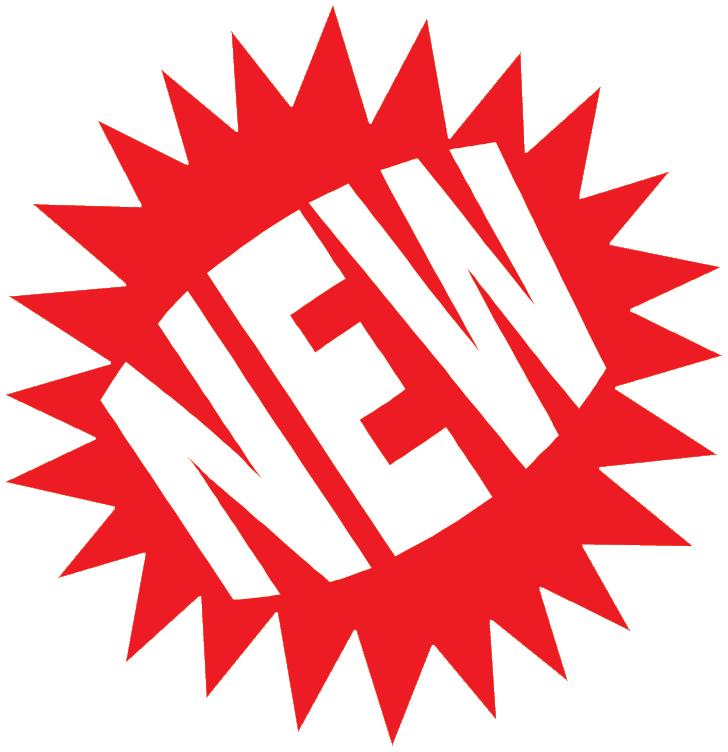

Send in your info today! Developing a new product? Or a new service? Let Green Magazine readers know about it in Product Review. New products and/or services will be considered for Product Review, a regular feature in Green Magazine. If you have a new product or service, write down the pertinent details, include a photo (if possible) and send to: Product Review / Green Magazine PO Box 95 • Bee, NE 68314-0095 Information can be emailed to: info@greenmagazine.com Green Magazine® • April 2024 Page 25

1973 JDX-8: Tough sledding in the high performance market
Every John Deere collector’s story starts somewhere, and back in 1983, my four-decades long obsession with John Deere snowmobiles was kicked off with the purchase of a rough 1973 JDX-8. Deere was still in the snowmobile business in 1983; I was a curious 14-year-old snowmobile fanatic who was thrilled to own a machine you could actually buy parts for at our local John Deere dealer, Falls Farm and Garden in Hudson Falls, New York. Parts availability was a major improvement over the out of production brands I tended to drag home before then. Come to think of it, parts availability 40 years after Deere exited the snowmobile business is still better than most of the brands that came and went over Deere’s 12 years of production.
For Deere’s second model year building snowmobiles, the 1973 JDX-8 was their first attempt at a hiperformance model. The new JDX line up, including the 440cc JDX-8 and the 292cc JDX-4, were intended to be the “top of the line” machines for the expanded and improved 1973 model year. The story goes that Deere VP RJ Carlson challenged the engineering team at Horicon to “pull ahead” the JDXs from the original 1974 planned introduction up to the 1973 model year. According to the book, John Deere
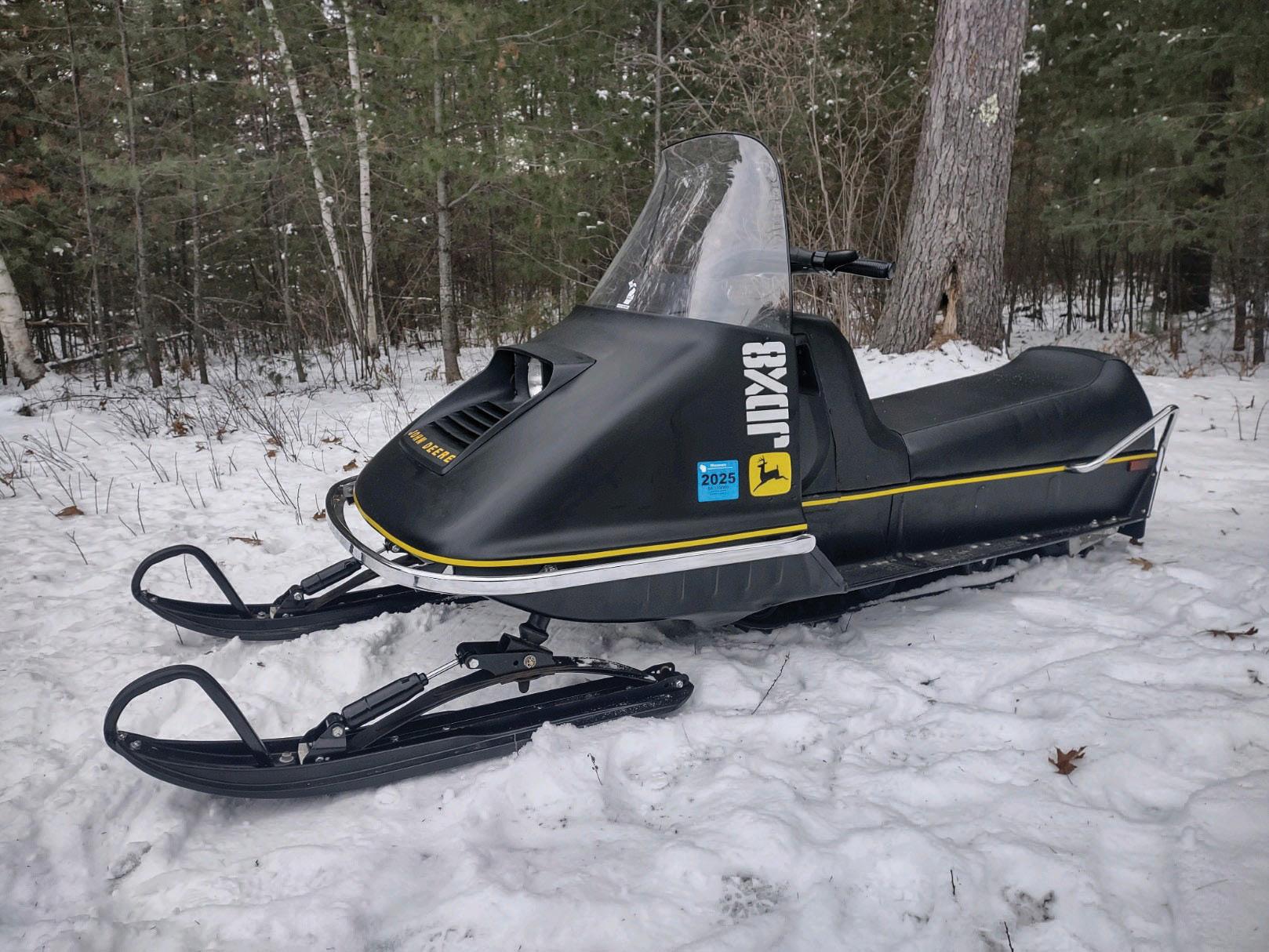
Snowmobiles by Leonard and Teal, when RJ Carlson called a meeting in the summer of ’71 to discuss tripling snowmobile production numbers from 12,660 machines from the ’72-model year to 36,000 for ’73, he also brought up “the possibility of producing the JDX performance machines as 1973 models that were originally planned
as ’74 models. These machines were to have more powerful engines and improved suspensions.”
This meant the team was going to have to make some compromises and test and development would be significantly compressed to get the JDXs to market a full year sooner. According to Leonard and Teal’s book, Deere was
Page 26 April 2024 • Green Magazine
Brian Lindner loaned us his restored 1973 JDX-8 for a photo model. It’s been updated with a few custom touches like modern plastic skis and of course a full coverage windshield.
already planning to expand the 1973 line-up from the original two machines built for 1972, the 340cc model 400 and 440cc model 500. Before the JDX pull ahead, two new models, the 300 and 600, were already scheduled for ’73 introduction that were originally planned for 1972 but were unable to get into production that first year. The 600 was a “wide track” that was basically a model 500 with the same powertrain but an 18 inch wide track instead of 15 inch and deeper chaincase gearing. The 600 did go into production as planned for ’73. The 300 was intended to be an entry level 292cc Kohler powered model below the model 400 but ended up getting pulled into the JDX family for ’73 as the new JDX-4. The Kohler powered model 300 with bogie wheels would have to wait until 1974 to finally appear as an update of the original JDX-4, while a significantly different 340cc machine called the “JDX-4 Special” was released with updated and expanded 1974 JDX machines.
The front view of the Lindner JDX-8 shows why most riders updated the windshield from the small factory bikini “sporty” windshield to the full size windshield from the 100 series “green machines.” The NOS front chrome steel bumper and rechromed rear grab bars contrast sharply against the Blitz Black paint scheme.
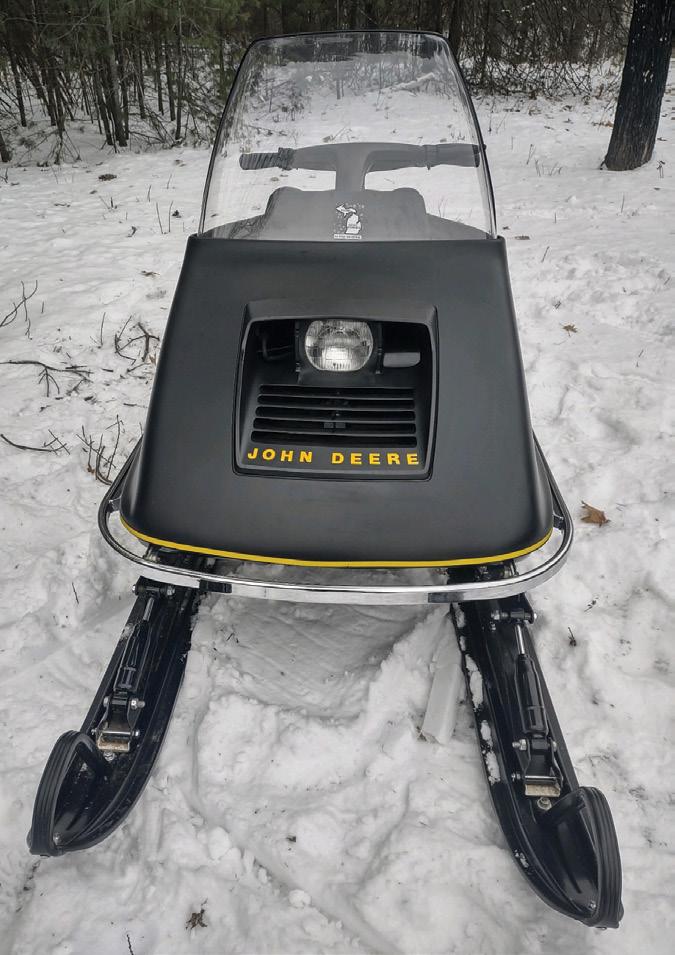
The “all new” ’73 JDX-8 featured CCW’s (Canadian Curtis Wright) allnew case reed 440cc engine, manufactured for them by Kioritz of Japan. The “KEC-440/21” was rated for 40 horsepower, four more than the piston ported model 500. While a step in the right direction for a family trail sled, it was off the pace for a “hi-performance” machine. Instead of sharing the green color with the ag line as the “100 series” snowmobiles did, the JDXs received a high quality all over “Blitz Black” paint job in an era when many snowmobiles had their aluminum tunnels left unpainted.
For a “sporty look,” the X-8 received a small “bikini” windshield that offered minimal wind protection. Deere added significant safety equipment across the board for ’73, such as a molded snowflap, a round hi/lo beam headlight and, on the JDX-8 and 600, a handlebar pad.Other standard equipment the JDX-8 received included carbide ski runners, ski shocks, a speedometer, and it was the only ’73 to receive a tachometer standard. Electric start, a passenger back rest kit and a matching black “JDX-8” cover were available as accessory items.
Deere was marketing the machine with “superior performance and distinctive styling” when the poor girl was unfortunately based on an already dated chassis. They called the somewhat “narrow-ish” 28 inch ski stance “wide” while other performance sleds of the era were up to four inches wider and, worse off, the engine was placed directly under the handlebars, or “mid-mounted,” the same as the ’72 machines.
On top of that, most all the major players had already introduced longer travel and better riding slide rail suspensions, while Deere plowed on with trailing arm bogie wheels suspending the track with steel flanged wheels literally purchased from a conveyer company. Interestingly enough, the entry level JDX-4 received Deere’s first aluminum flanged bogie wheel containing a sealed bearing that became standard equipment for all Deere bogie sleds from 1974 to ’77. The ’73-era front
“power unit” that housed the steering system, fuel tank, motor and chain case mounts was still steel while the rest of the chassis from front to back was stamped aluminum. The “power unit” was switched to aluminum construction for the ’74-model year, shaving 17 pounds off the front of the machines. The JDX-8 had a good, high-quality chassis, just not a hi-performance engine placement or ski center to center to promote competitive handling.
Just to add to the stress of increased production and pulling head the JDX a full model year, many of the new engineering features for ’73 caused headaches for Deere’s Horicon Works that designed and manufactured the snowmobile line. According to word-of-mouth stories and detailed in John Deere Snowmobiles , the new 40 horsepower case reed engines, the KEC 440/21 was not ready in time for the JDX8s to roll down the assembly line. The book quotes Jack Hoffman as recalling “that JDX8 production was assembled and crated for shipment without engines.” So Deere’s new flagship ran down the line without motors being installed. The solution was supposedly to have hired local schoolteachers on summer break to perform the final assembly in a separate area of the factory. The JDS book
Kioritz of Japan manufactured the KEC-440/21 case reed motor expressly for CCW, for use in the 1973 JDX-8. The 40 horsepower motor provided an 11 percent power increase over the model 500, but not industry leading performance. Optional electric start shown here adds a nice convenience to the machine.
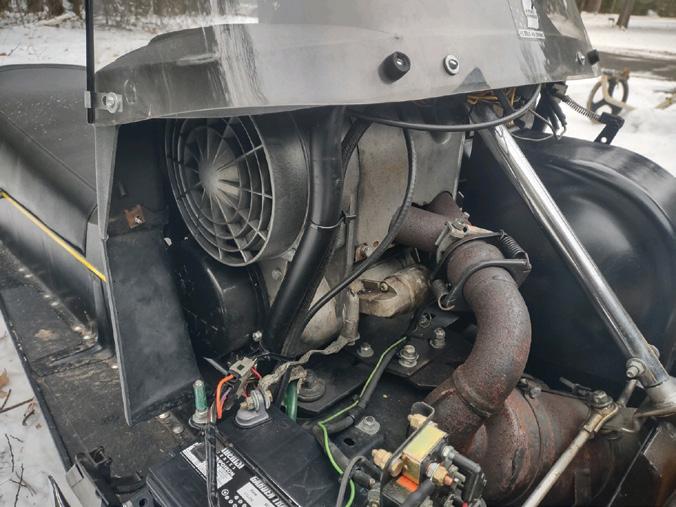
Green Magazine® • April 2024 Page 27
authors admit that the schoolteacher part of the story was not verified but considering that Jack Hoffman was an engineer on the program, the story about the sleds being built short engines seems quite legit. Stories also flew out of Horicon that Kioritz air freighted the new engines to Deere in a 747 as soon as they were built. Not surprisingly, no pictures of this or the offline assembly work can be located.
Aside from increased power, improved suspension was another stated goal of the JDXs. Yet, the ’73 JDX-4 and JDX-8s utilized Deere’s conventional bogie wheel system on an all-rubber Gates track, a total carryover from 1972. However, several years ago, I noticed something was different in the 1973 snowmobile brochure. Both JDXs pictured had the all rubber track but did not show the shiny external rear pivot plates typical of Deere’s bogie wheel suspension. I posted on www. jdsleds.com about it, to which Deere factory snowmobile technician Ed Kruel responded about a prototype steel slide bar suspension that ran directly on the rubber track. Apparently while it had more travel, and I
Interestingly enough, the Lindner JDX-8 was one of the few that did not receive the Mod Kit 160 clutch update, as it was optional for machines already in customers’ hands at the time the kit was released. Brian chose to update his machine with the newer 102-C drive but used the originally intended 90D driven clutch. Brian also installed the later optional “1974 muffler” update kit that included the extended motor plate that the updated muffler attaches to.

assume shocks to dampen that travel, the system did not work as hoped. Jack Hoffman was quoted in the JDS book as saying: “…the polyurethane track and steel slide arrangement is dependent on fairly generous amounts of snow for lubrication. Although we continue to try to make the combination of the poly track and the steel slide work, it appears the only satisfactory option…will be to use a track with steel clips running on a replaceable plastic rail.” So, while the brochure shows this unique suspension, all the production JDXs for 1973 stayed with the proven bogies until a slide rail with plastic hyfax and cleated track were released for 1974.
All the 440cc 1973 machines, the 500, 600 and JDX-8, received the new Salsbury 850 drive and matched driven clutches. This was the clutch that Deere technician Ed Kruel said “wouldn’t last a day” under harsh race conditions. Apparently, it did not hold up particularly well under aggressive trail riding either, as Deere issued a recall to replace it. Modification Program 160: PN BM21064 included a new Comet 100-C drive and 94D driven clutch, a drive belt and hardware. The update was mandatory on all 1973 440cc machines in dealer inventory and optional on customer owned units. The new Comet 100-C was standard on most of
It’s pretty uncommon to see a JDX-8 with the original Salsbury 850 set up, as most were replaced by the recall. Fortunately, Brian grabbed a picture of his set up before tearing his machine down. The vapor lock kit was also not originally installed before Brian got hold of the machine.

the ’74 machines (except the 300 that used the durable Salsbury 780) and eventually led to the development of the famous 102-C that was used by Deere from ’75 to ’84, and spread to other manufacturers. In fact, you can still buy new 102-Cs today that are used by racers, collectors, and hobbyists so the switch to Comet was a wise one.
The sound reduction effort caused even more grief. To help quiet the machines down to 82 dB at 50 feet, the engines had to be further enclosed, and carb intake sound attenuators and quieter exhaust mufflers had to be developed to reduce sound levels without lowering performance. After what was definitely a huge effort, the sound goals were met, and the power levels were maintained, but at a cost. That price was vapor lock. With the engines and carburetors more enclosed, it became too easy to heat soak the fuel system, causing hard starting and performance issues. The fix was another “PIP” or Product Improve Program, called “Modification Program 150” but this time to thermally insulate the fuel system.
This kit consisted of a two-piece aluminum heat shield that was covered in foil faced insulation that bolted to the tunnel of the machine, straight up behind the engine, allowing the
The full two-page 1973 brochure picture shows the unique prototype steel slide bar rear suspension that did not make production. You can also see the lack of a right side engine panel that the production sleds used for ’73 along with small “sport” windshield that added a little style but little wind protection.
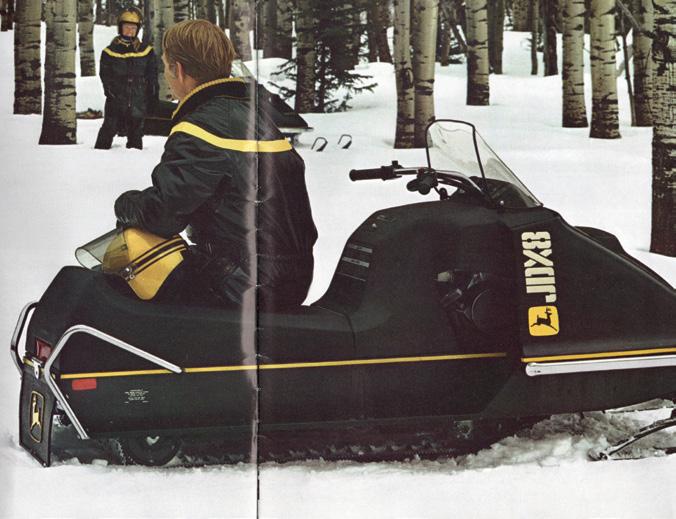
Page 28 April 2024 • Green Magazine

The 73 JDX-8 and all ’73 machines fully enclosed the engine, unlike the ’72 machines that had the recoil exposed with no cover. This helped promote the vapor locking issue that the later vapor lock kit then had to solve.
carb to poke through, capped with a new vented engine access cover to allow cool air to enter the carburetor. The fuel lines were also wrapped in insulation where they passed under the engine to prevent heat absorption. There were three kits designed to cover the variety of engines used that were supposed to be installed on all 37,000 machines built for ’73. The kit instructions additionally had instructions for several other of the Mod Kits, including Mod Kit 100, a JDX-4 carb spacer, Mod Kit 140, to add clearance to the throttle lever using sand paper, instructions to remove a carb fuel screen, a fuel filter and a reminder about clutch Mod Kit 160. This must have cost Deere a bundle. And much like the Comet 100-C / 94D clutch set, the “vapor lock kit” was standard on all ’74 and up machines.
The final significant issue with the JDX-8, that also affected several other ’73 machines, was carburetion and calibration. With so much work needing to be done in a compressed timeline, made worse by late availability of motors, the Walbro WDA34 carb flowed way too much fuel according to John Deere Snowmobiles. The fix, according to the book, involved somewhat crudely using a ballpeen hammer to close one of the fuel ports down to reduce flow. This allowed the high-speed needle

The production JDX-8 used the carry over tried-and-true steel wheel bogie, sourced from Aetna Bearing Company. 1973 was the last year of the steel bogie wheel, as the ’73 JDX-4 introduced aluminum wheels that became standard for the green machines until ’77.
to regain enough authority to be able to adjust fuel flow to the proper mixture. Other sleds were reported to have been misadjusted from the factory, especially the JDX-4. The ’74 JDX-8 used an improved WRA31 Walbro carb that did not suffer such issues.
What’s the final verdict on the ’73 JDX-8 as a snowmobile after all the compressed engineering and development timelines, late motor delivery, assembly challenges, after the fact PIP and customer satisfaction programs? Honestly, they are a decent machine for what they were. The small windshield isn’t popular with today’s collectors since no one likes cold hands, but it does look unique. I can’t imagine that was real popular back then either and it was the first thing I updated on my original JDX-8, even with a tight high school kid budget. The CCW case reed 440/21 was only used for ’73, before being replaced by the updated 440/22 for ’74. Fortunately, the “/21” was a solid and trouble-free motor once the carb and clutching issue were sorted out. While the chassis was entirely old school, it works well as a trail sled within its design limits.
The bogie wheels ride reasonable “for a bogie sled” and the ergonomics are quite well thought out for a machine with the motor directly under

The 40 HP CCW KEC440/21 was all new, but still used the older style short reach spark plug. The “/21” had a small 16 mm wrist pin and unique transfer ports. It was a one year only motor before being replaced by the 440/22 that was used for ’74-78 model years with various updates. Few parts directly interchange with the newer 440/22, making the 21 all the more distinct.
the handlebars. The relatively thick, high density multi-layer foam seat was supportive and miles ahead of what some manufacturers used for seating. The updated Mod Kit 160 Comet clutching was a responsive and relatively durable set up that wore well and gave predictable performance. Once the vapor lock kit was installed, the hard starting and fuel vaporization issues were minimized. These days, it is pretty uncommon to find a ’73 JDX-8 that was not updated, but it does happen.
Although it took Deere an extra season to sort out the ’73 JDX-8, Deere’s backing and addressing the teething issues seemed to have prevented a significant stigma against the ’73 JDX8 or any of the ’73s in general. Today, collectors seem to enjoy the sled for what it was intended to be—a fun, peppy trail sled. I liked my original ’73 enough that I bought and restored another one...and an NOS clutch kit, vapor lock kit and, finally, a ’74 Walbro WRA-31 carb just to make sure mine is fully updated.
Joe Rainville is from Fort Worth, Texas. To contact him, send an email: joerainville@hotmail.com
Green Magazine® • April 2024 Page 29

Circles in competition
Two circles will battle it out for top dollar this month in What Brought More? The first of these circles is a circular thermometer from the 1950s

and an Owosso, Michigan dealership. The seven-inch thermometer is made of a white plastic material with green print including the “Quality Farm Equipment” logo. The glass thermometer is wired to the plastic. There is a bit of staining or discoloration on the plastic, but it is in good condition overall without any cracks or breaks.
The second circle is a small coin.
The California State Agricultural Society gave this special award to John Deere for the company’s electric generator and dynamo in 1912. One side of the coin states this commemoration, and the other side features the California state seal. The seller says that they had the coin tested, and it was reported to be .999 silver. The coin is about 1-3/4 inches in diameter and weighs about 45 grams. The coin has suffered a few bumps and bruises,

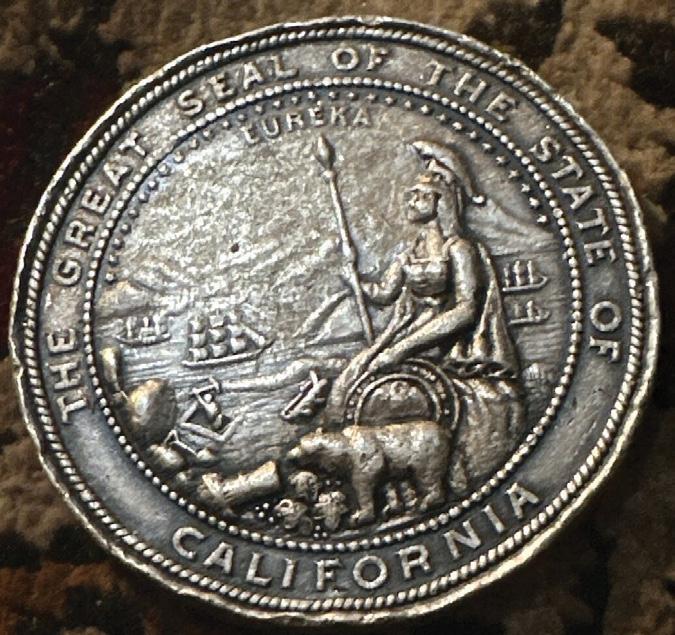
and the edges show wear. The faces, though, appear to be reasonably clear for the age. So, do you think the value of this old coin can beat that of the very collectible thermometer? Find out at the end of the article.
Most of a rain gauge from a California Deere and Caterpillar dealer showed up on eBay this month. This is a steel gauge with yellow paint and green print. It is a little rusty and dirty and missing the glass tube that was meant to catch the rain, but it still

garnered some interest and picked up 13 bids for a final price of $51. An interesting “hot-cold pump pot” with a John Deere logo on it sold this month. This is essentially a thermos that dispenses its contents by pumping the button on the top. It is tan with a black Deere logo on the front and comes with a box. It’s a bit dirty and has a small dent in the side, but it seems to be serviceable. It sold for $56.

Page 30 April 2024 • Green Magazine

Here we have a combination money clip and pocket knife. The clip is stainless with yellow and green enamel. It houses a small 1-1/2 inch knife, which would probably come in handy from time to time…just try not to cut up your money when you use it. It took $81 to bring this home.
Another interesting knife sold on eBay this month. This pocket knife had two blades and a hole punch/file combination tool. It is brass and steel

and was made in Solingen, Germany so naturally says “John Deere Lanz” on the emblem on its side. The handle of this pocket knife is pretty unique. It includes a bunch of filigree throughout each side. The knife has been well used but is still in good condition. It sold for $86.
If you are putting an old tractor back together again, you want to try to cover all of your bases before you flip the flywheel over or engage the starter for the first time, praying that

the machine roars to life. Spark is obviously an essential part of getting most old tractors to run, and knowing that your magneto is in good working condition could save you some headaches down the line. Someone on eBay sold a magneto test stand last month. With this, you could tell for certain whether or not your magneto was ready for service. The test stand was meant to work with both long and short magneto drives. It sold for $350.
Now that you know your magneto works, you might want a new spark plug cable. You could slap some newfangled wire on there and call it a day, or you could buy this new old stock part 32006R John Deere spark plug cable and put it together just like new. This spool of cable, which started at 50 feet long, is about half-spent. It went out the door at $35.
This month, an interesting new

old stock replacement plow share was found on eBay. This is part 215U and would have likely been produced sometime around the 1920s. This plow share also comes with the original shipping tag. To some it may look like little more than a hunk of iron, but the plow is what put John Deere’s company on the map. In that way, this old piece is kind of symbolic. It brought a price of $75.99.


One of the rare and popular John Deere toy tractors sold this month. This model 7520 toy has a single hole in the hood and no intake stack. It was in great condition, with nary a scratch on it. It sold for $680.
Getting back to What Brought More? we’ll find the final value of the two round items that opened up this article. The thermometer was first. It is a highly collectible piece, as thermometers of all sorts seem to be quite popular. This one also had one of the most attractive Deere trademarks on it, and looked good in its circular format. It brought $350.67 in its time on eBay. The second item, the coin, was worth about $32 in silver, but what was it worth to a collector? $390. Keeping in mind that this could be a one-of-akind piece, this high price might not be surprising. This was a big deal in a small package.
See something interesting on eBay? Forward it to sawitonebay@ yahoo.com
If you see a John Deere item of interest for sale online: Email: sawitonebay@yahoo.com or info@greenmagazine.com Mail: Green Magazine/Saw it Online PO Box 95 • Bee, NE 68314-0095 Green Magazine® • April 2024 Page 31
Dealership memories and John Deere Days
I have been a reader of Green Magazine for only two to three years, but every issue intrigues me because I have been a John Deere lover since my childhood days. My life with John Deere started in about 1950, when I was five years old. We had a John Deere dealer in town and, of course, they sold John Deere toys. A lot of the boys back then were from a farm family. I was not raised on a farm, but like most boys in my era, I liked to play with toy tractors.
Our family was on the poor side and a lot of toys for birthdays and Christmas were out of the picture. Every year for my birthday in August and at Christmas, I would get “a” John Deere tractor or implement. By the time the next year came around, being one of the few toys I had to play with, they were pretty worn out and I was ready for the next set. My brother, who is one year younger than me, also got the same number of toys. I can still remember the green and yellow boxes they came in and, of course, you threw them in the trash can. If only I knew then what I know now.
got married. Charles was 30 years old when he opened the business in the small town of Beaufort, Missouri. When the store opened, it was a furniture and hardware store.
Then, Charles Honold received correspondence from the John Deere Plow Company on June 20, 1925, notifying them they could start selling implements for the John Deere Company.
Charles and his wife, Clara, had three sons and two daughters. On

December 24, 1950, one of his sons, Wilfred, was killed in a car wreck. He was 21 when he got killed. This was a terrible shock to the family.

The John Deere dealer was also a hardware store. Every time Dad and I would go to the hardware store, I would make an abrupt right turn to the wall of John Deere toys. I would wish I could take one home.
I was very interested in the articles about the Caroline, Wisconsin dealership in the February and March 2023 issues. Because of this article, I am writing to you about a similar dealership in my little town of Beaufort, Missouri.
The dealership’s name was Honold Hardware. This store was opened in 1917 by Charles Honold. That was the same year that Charles and Clara
In 1952, Charles Honold incorporated the store and split it between his children. At this time, it officially became Honold Hardware Company. And then, on July 14, 1952, Charles Honold passed away.
At some point in the late ‘40s or early in the ‘50s, Charles’ son, Leonard (Spitz), took on the John Deere dealership and store. The reason I am a little vague about how these things transpired is because I am 78 years old, so I was only about five to eight years old when this all unfolded.
The youngest son of Charles Honold is still living in Virginia. I don’t remember if he was associated with his dad and Spitz in running the business.
Sometime during the time Spitz was running the store, his brotherin-law, Everett Peters, who was the husband of his sister, Ruth, went to work in the store. Then in 1964, when Spitz passed away, Everett ran the store, with Ruth being the bookkeeper. It was after Spitz passed away that the dealership was no longer in existence.
One of Charlie’s granddaughters, Janet Story, who is now in her 60s, says she does not remember any of this because a lot of this occurred before she was born. When Spitz Honold passed away, Janet (only nine years old) started working at the store. She watched the store while her dad, Everett Peters, took care of repairs, etc. in the basement.
Sometime after getting married, Janet and her husband, Larry, went to work at the store fulltime. This was Everett and Ruth’s third daughter. Janet did all the ordering and Larry was a lawn mower and small engine mechanic. This helped the store keep going because, by this time, the large chain hardware stores were eating into the profits of the little mom and pop stores.
The hardware store sold lawn and garden equipment until sometime in the 1980s. Business was tapering off and the profits weren’t as great. At time passed, Everett’s health started going downhill and in 2009, he passed away, leaving Larry and Janet to run the store with Ruth. Then in 2012, Ruth Honold Peters also passed away, leaving Larry and Janet in charge. Then shortly after that, Larry developed cancer and business became less and less because of the competition of the big stores so on March 18, 2019, they closed the store.
Honold Hardware served the Beaufort community for more than 100 years. You could go there, through the
Page 32 April 2024 • Green Magazine
years, for everything from tractors and implements to an odd sized bolt and anything in between. This store also became a meeting place, where the old timers could reminisce about the good old days! They sold the store and property to another Beaufort resident. Since then, the store is sitting empty with lots of memories inside. Everyone in the Beaufort and surrounding area really misses the old store, but we all understand when there is no profit, it has to come to an end.
The John Deere dealership was a very thriving business in our farming community of Beaufort, Missouri. Every January or February, during the ‘50s, the dealership would host a John Deere show in our church hall and give away attendance prices—some of these were toys. When you would enter the hall, you would sign your name on a piece of paper and you were given a current year pocket ledger and a little pencil. Then a representative from the John Deere company would show a movie about the coming year’s tractor line and newest implements. This event was geared to selling tractors and implements to farmers. (It was not for little boys to get a toy.)
At the end of the program, each year, they would give attendance prizes. Well, at the show in 1955, they pulled my name for an attendance prize. I jumped out of my seat and made a dash to the stage and grabbed a brand new John Deere crawler! Needless to say, I was in seventh heaven and I still have this toy in my collection today.
The poster that advertised the show is shown at left. It was held at our church hall, at St. John’s Lutheran Church. This advertisement is from that exact year I won the toy. This is also the church where the whole Honold family were members.
Another interesting fact—in January of 1957, someone came and stole a new 1957 model 520 tricycle tractor from the business. It just disappeared! The area was searched by everyone. Since they did not find it anywhere around, Spitz turned it into the insurance company and they paid him in

full for his tractor. Sometime later, the tractor was found. They man who stole the tractor put it in a hay shed, stacked bales around it to hide it and then after this period of time, uncovered it and someone tipped off the sheriff’s department. It was returned to Honold Hardware. Spitz was paid for it through insurance, so he put every farmer’s name in the area in a hat and drew one out and that farmer got a brand new tractor.
hay all summer until the next fall, from early morning to late evening. This is when I learned to drive real tractors and also learned what farming is all about. These farmers I worked for did not have John Deeres, but I was pleased to be able to drive one of their tractors anyway.
Then my tractor days ended until my friend, Don, and our wives went on vacation to the National Farm Toy Museum in Dyersville, Iowa in the summer of 1998. They had a toy store next to the museum and I bought a 1/16th scale old Waterloo Boy model “N” and the toy fever got back in my blood. My John Deere collection consists of six in 1/8th scale, 188 in 1/16th scale, 227 in 1/64th scale, 37 in 1/32nd scale, 12 in 1/43rd scale, 11 in 1/50th scale, 16 in 1/87th scale and a few other miscellaneous pieces. I have all the pocket ledgers for about every year of the 1930s, ‘40s and ‘50s. My oldest one is dated 1901. I have a good amount of advertising brochures and owner’s manuals for various pieces. This is my retirement hobby. I enjoy it very much!

One interesting note is the farmer who received the tractor had a farm where the old original town of Beaufort was located before the railroad came through. Then the town moved to its present location and where Honold Hardware is also located.
This wasn’t the only item stolen. Back in 1954, a lime spreader was stolen and there were other times the store was broken into at night and items were stolen.
Back to my toy tractor days. As I got older and into high school, my interest for toys got put on the back burner. When school was over for the year, I worked for farmers putting up

I also host a farm toy show in the same building where the John Deere show was held back in the 1950s. This toy show is held every year on the third Saturday of September. It’s great to see adults and kids looking over the toys for that special toy tractor.
This is my story about the hardware store and the John Deere dealership that I am glad I got to experience in my lifetime. It’s a place I will never forget as a lifelong resident of Beaufort.
In closing, I am very much a fan of John Deere and I am very interested in making our younger kids interested in taking over their parents’ farms because, frankly, I love to eat. Thank you for Green Magazine and I will always be a green and yellow lover.
Submitted by,
Jimmy Dale Rinne Beaufort, MO
Green Magazine® • April 2024 Page 33


The warmest winter in Minnesota’s history! That’s what we have been through this year. On the radio the other day, they quoted the statistics—I think the report said the temperatures from December through the end of February averaged five degrees per day warmer than the average Minnesota winter. My 4640 is a little bit cold blooded, but this winter feeding

hay to the cows has been a breeze! My tractor loving grandson is here so we will have to start her up and feed the cows, one of his favorite activities at grandpa’s house!
Even though the winter was warm, we were able to take a trip to Arizona to see the sights around the Grand Canyon and, thanks to my daughter-in-law, I was even able to check out some John Deeres!
Speaking of checking out the John Deeres, I also had to opportunity to check out some auction sales. One of the tractors that piqued my attention happened to be an orchard tractor. At one time in history, it was proven that orchards did better if they were cultivated or harrowed between the rows.
This was initially done with horses but with the advent of gasoline powered tractors, a way was conceived to allow tractors to do the job once done by horses and work in the orchards. The early tractors were simply too large and eventually designs changed and special models were built lower to the ground and sheet metal was added to streamline the tractors and keep the branches out of the mechanical parts of the tractor, as well as protecting the operator.
This first tractor I will mention was one of these sleek orchard machines. It was a 1956 model 60 orchard tractor, an LP version. This running 60 orchard, one of 45 built, is an awful nice looking machine and it got attention not from just me. Somebody wanted it 43,250 dollars worth, and I can see why.
her a toy Case model “L.” If I wanted to buy a real 1944 model “LA” with a single bottom plow, it would have taken a lot more than toy prices. The final bid on this “LA” was $5,050!

Let’s jump to a little

The next tractor on the same sale was a “BO” Lindeman crawler. The serial number is not readable but believed to be 333872. Crawler tractors were preferred for use in the hilly orchards of the west coast. John Deere’s Lindeman-adapted crawler machines were popular there. The nice looking, running “BO” John Deere Lindeman crawler reached a bid of $14,500.
New Generation fun! This is a tractor I have never personally been around, but I certainly think it would be a great one. From the Earl Martin Estate near Waynesboro, Pennsylvania, we have a 2520 with a canopy and added windshield. This unrestored unit had nice tires and, including a $770 buyers’ premium, this tractor sold for $14,270.
After looking for and at many “D” John Deere tractors last year, for

Finally, a little model “LA.” My granddaughter’s name is Lola so when she was born, I gave her a toy model “L.” When she turned one, I got


Page 34 April 2024 • Green Magazine
the 100th anniversary of the model, I did come across a nice looking styled “D.” It was sold by Schrader Real Estate and Auction Company, Inc., in Columbia City, Indiana. This one was a 1947 model with 16.9 by 30 tires and electric start. The gavel dropped at $3,100. I kind of wish it was a little closer to me…I might have had my first model “D”!
The next four tractors came from the collection of the late Dardan Jarman of Silver City, North Carolina and were sold by Rogers Auctioneers.
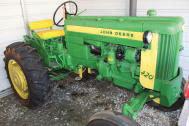
First, a nice little Dubuque made 320 John Deere. There were a total of 3,084 model 320s built from 1956 to 1958. The little tractors were rated at about 21 belt horsepower with a four speed transmission. If you wanted to take this particular 320 home with you,
you would have had to outbid the leading bidder of $6,600.

Next, I like this nice little “BR” tractor. It was advertised as a “B” with an orchard hood. The auctioneer said this tractor was running when parked. This 1936 model could have been yours for a bid of $2,825.
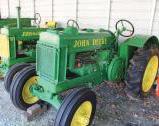
with a wide front, and as time went by, my wife’s grandfather, Clifford Follmann, also had a 1949 “B” with a narrow front. I now have acquired a 1949 “B” John Deere in “memory” of the two “Bs” that have a bit of family history. So you maybe can see why this styled “B” with the mounted cultivator made me take a close look!

After that, I came across a model “H” tractor. Not much information was shared except it was a 1945 model that also was running when parked. Price? $2,925!
Finally my favorite tractor on this sale, a newer styled “B” with a mounted two row cultivator. My dad, Winton “Mickey” Mickelson, had a new 1949 “B” John Deere

This “B” from the Dardan Jarman sale ended up selling for $2,125. That is a steal in my book!
I can’t wait for the summer auction season to get here! Thanks for the heads up messages I received this month; I am still chasing down a few of those sale results! As always, if you have any leads, please let me know and happy auctioning!
Email Eric W. Mickelson at mickelsonauctions@gmail.com
Email: mickelsonauctions@gmail.com or info@greenmagazine.com

If you see interesting auction results for John Deere items, submit that information for possible publication.
Mail: Green Magazine/Auction Highlight • PO Box 95 • Bee, NE 68314-0095
HEY, SNOWBIRDS and anyone else who is moving Whether you are heading south, going back home or moving to a new location, remember to call Green Magazine® with your address change FOUR WEEKS PRIOR to the move. Missed issues will NOT be resent free if your address has not been changed due to a seasonal move. NOTE: ANYONE moving should call or email Green Magazine® FOUR WEEKS PRIOR TO A MOVE to change the address on a subscription. Call or email Green Magazine® to change the address on your subscription. Ph. 402-643-6269 info@greenmagazine.com Green Magazine® • April 2024 Page 35

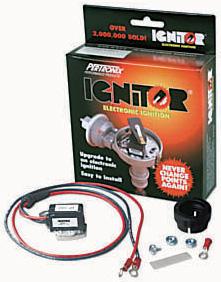

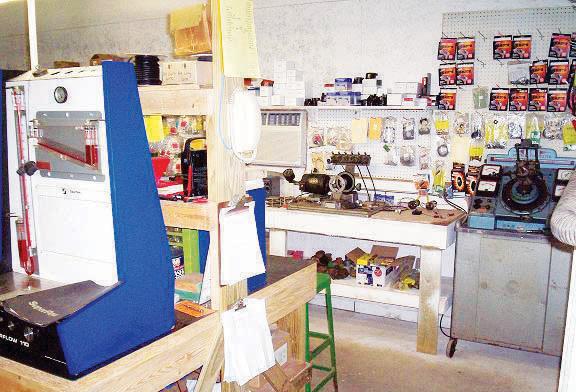



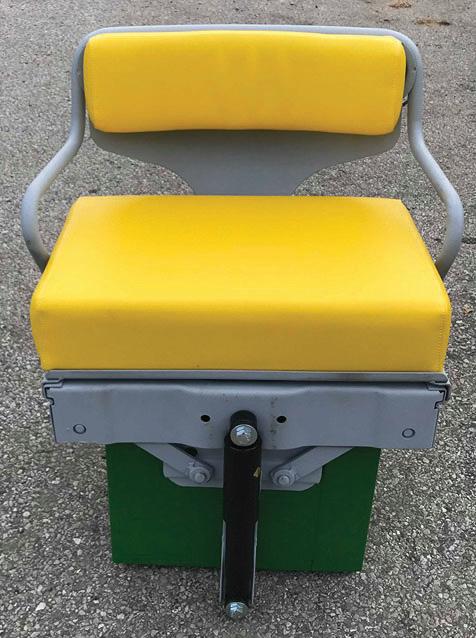

•
•
•
•


parts include: Taper-Loc flywheels, electric start conversion kits, float ride seats, starters, carburetors, cleaned and lined gas tanks. Also have crack checked heads and blocks.



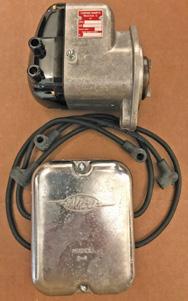


McDonald Carb & Ignition McDonald Carb & Ignition 1001 Commerce Rd. • Jefferson, GA 30549 Ph. 706-367-4179 info@mcdonaldcarb.com Guaranteed Quality Parts and Service Virtually All Makes and Models Stock or Modified Buy, Sell, Trade Check us out on the web for info and online ordering: www.mcdonaldcarb.com
Bros Tractor and Parts, LLC
Lind
New aftermarket, rebuilt and used parts for JD A, B , D, G, H, M, R, 320, 330, 40, 420, 430, 50, 520, 530, 60, 620, 630, 70, 720, 730, 80, 820, 830, 3010 3020, 4010, 4020.
Used parts include: weights, 3-pts., toplinks, dual hydraulics, float ride seats, clutch parts,
and
720-730 ES parts, all-fuel
and
tube WFEs, heads, blocks and PTO parts.
hubs, transmission gears, sheet metal, tires
rims,
manifolds, brake parts, square
round
New
include:
carburetor
overhaul
parts
manifolds, battery boxes,
kits, air stacks, mufflers, grill screens, radiator cores, lights and
kits.
Rebuilt
Lind Bros Tractors and Parts, LLC 830 Saint Peter’s Church Road SE • Corydon, IN 47112 sales@lindbros.com • www.lindbros.com 812-952-3010 • 833-952-3010 Call or email today! Orders can also be placed online. Page 36 April 2024 • Green Magazine



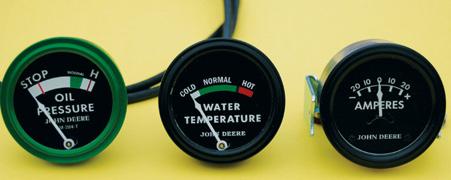




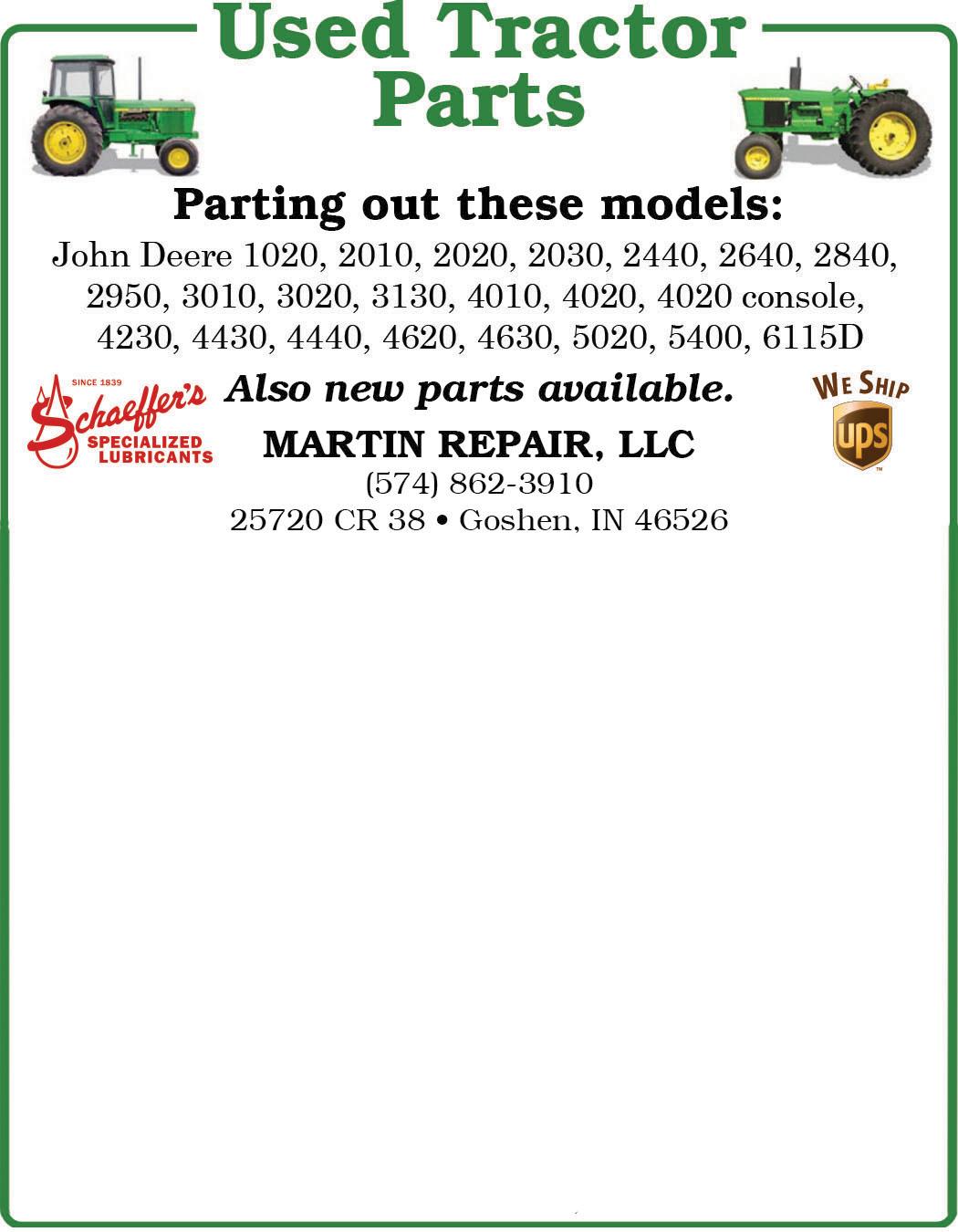
Classic Green Reunion 2025 June 12-14, 2025 Washington County Fair Park & Conference Center West Bend, Wisconsin See ClassicGreen.org or find us on Facebook Call for more information on these tractors 4430 Syncro, running engine PARTING OUT! 4020D, dual remotes, running engine • PARTING OUT! EverGreen EverGreenRestoration Restoration Gauge prices: $65 for oil/amp $80 - $90 for temp, depending on length of the lead Oil, amp and temperature GAUGES with white or black faces for most 2-cylinder models for the unstyled to the 30 series, Waterloo and Dubuque built models Made in the USA • All gauges have real glass • On hand, ready for shipping • Painted, ready to install • Gauges come with mounting clamp and hardware • Faces made by Jorde Decals and have all details of the original gauges • All gauges are calibrated EverGreen Restoration Jerry Trcka W7619 Walnut Dr Spooner, WI 54801 Cell 715-520-7876 tractorgauges@yahoo.com www.evergreengauges.com NEW GENERATION GAUGES now available! RECOVERING ORIGINAL STEERING WHEELS - CALL! Oil, amp and temp gauges available for OTHER BRANDS of antique tractors Green Magazine® • April 2024 Page 37



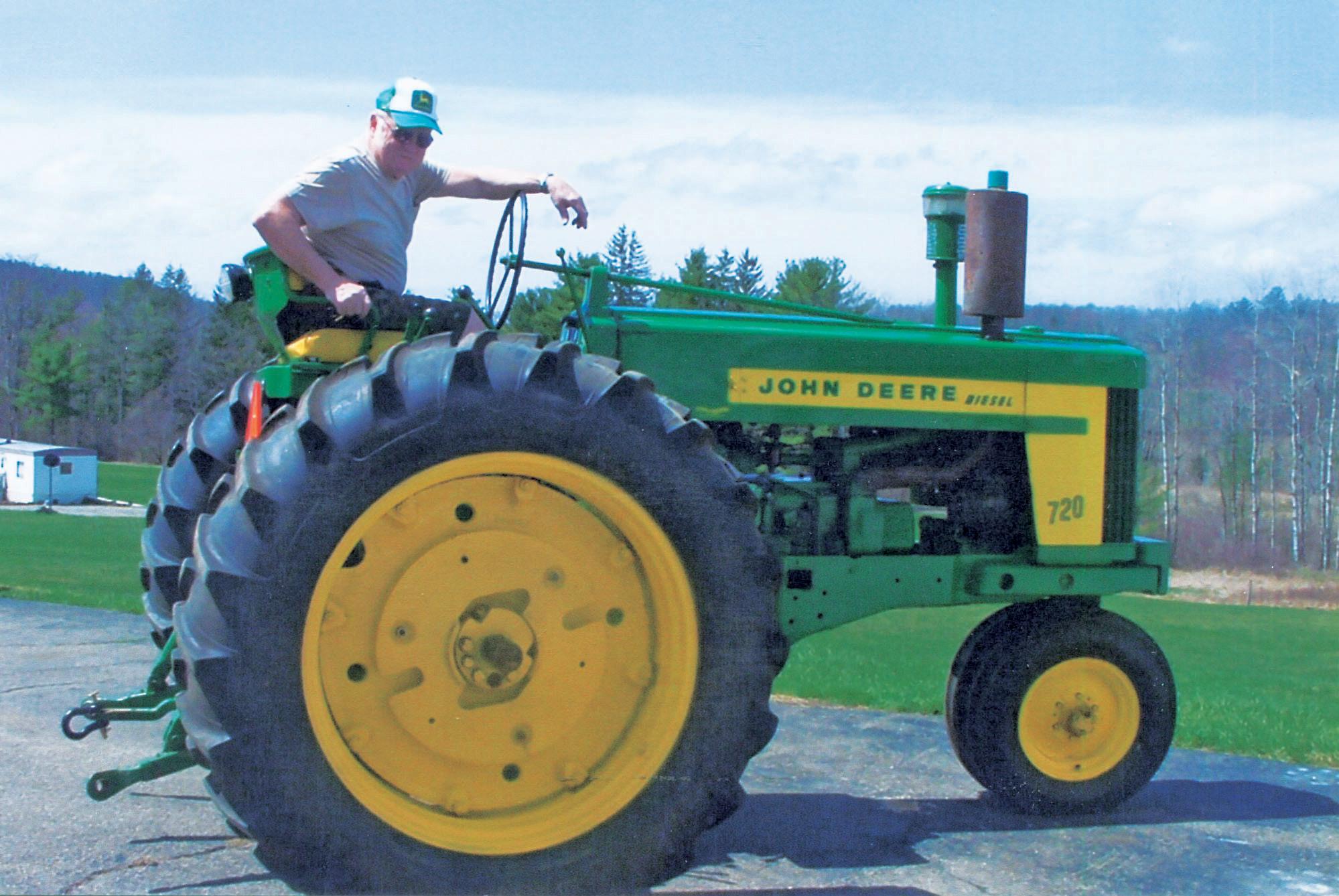
 A 1938 “A” with No. 25 cable lift loader owned by Mike Bowers of Lancaster, Ohio.
Right: Pictured here is Herman Schiel of Barton, New York with his 1957 model 720.
Right: Terry Harrimon and his 1969 4020 that his dad bought brand new in Scottsbluff, Nebraska from Frank Implement company. It’s been in the family ever since his purchase.
A 1938 “A” with No. 25 cable lift loader owned by Mike Bowers of Lancaster, Ohio.
Right: Pictured here is Herman Schiel of Barton, New York with his 1957 model 720.
Right: Terry Harrimon and his 1969 4020 that his dad bought brand new in Scottsbluff, Nebraska from Frank Implement company. It’s been in the family ever since his purchase.




Oliver Lindemer resurrected this ’51 “G” after a long sleep due to some mechanical failure. After 20 years, it’s back up and cruising the farm. He’s says that it may not have the prettiest paint, but its weathered look definitely shows how hard it has worked in its life. Nothing sounds better than this two-cylinder John Deere cruising the fields on a calm 20 degree day.
 Left: Don Papenburg of Streator, Illinois cultivates with his 1937 “A.” The tractor was bought new by his grandfather from G.W. Riss and Sons.
Left: Don Papenburg of Streator, Illinois cultivates with his 1937 “A.” The tractor was bought new by his grandfather from G.W. Riss and Sons.
Green Magazine® • April 2024 Page 39
Left: Tim Biesecker of Covington, Indiana plowing with 1952 “G” and F650AH 3x14 plow near Collision, Illinois at a plow day event on September 10, 2022. Tim’s grandfather farmed with this “G” north of Perrysville, Indiana.
More power!
(Hydraulic power, that is) • By Rich Collins
Have you heard that your John Deere lettered series, or early numbered two cylinder tractor, doesn’t have nearly the hydraulic power as a new tractor? I’ve been told that a number of times. Then, a few years ago, I got some real evidence that it might be true. Read on, however, for a different ending than you might expect.
After farming as much as 500 acres over many years, I had tapered down and finally given it up about 12 years ago. I had used several two cylinder tractors, and in the later years, also owned a 4430 and a 2950. Naturally, those newer tractors with cabs were the ones hooked to the heavier implements, so I never really got to test out the theory of lack of hydraulic power.
When I got out of farming, the two newer tractors were sold, but I kept the two cylinders. In 2018, I got the itch again and bought a small farm where I could actually use the old girls. I had also sold my planter, so I bought a John Deere 7000 no-till planter with liquid fertilizer tanks to get the crop into the ground.
I quickly found out that neither my “B” or “G” would even begin to pick that planter up, even without fertilizer in the tanks. The planter came with a fairly small cylinder, so I switched it out for a 3-1/2 inch version. It made no difference.
Fortunately, my 720 would pick it up, so I didn’t really worry about it. I just wondered how it was possible that a hydraulic system could be so weak.
Over the years, I asked John Deere dealerships, different mechanics, and two cylinder enthusiasts about the problem. The consensus was that the tractors just didn’t generate enough hydraulic pressure in the “old days.”
I did get recommendations to try 40 weight oil and larger cylinders. I was also told the pumps were probably worn.
I checked the actual hydraulic pressure with a gauge, and it definitely was below factory specs. I even put some extra washers in the relief valve to overcome the wear issue, but the lifting power didn’t improve.
Then came a crisis! In 2021, I was preparing to plant my corn when I realized the 720 had a bad transmission bearing and could not be used. Not really expecting anything to have improved, I hooked the “G” up to the planter, with the same lack of results as before.
I searched the owner’s manual, but other than talk about “lifting springs,” which the planter didn’t have, there was no guidance whatsoever. Of course, I already
owned the John Deere hydraulic manual SM2011, entitled Hydraulic Equipment, and had studied it many times. In fact, when I was about to give up and call my neighbor to plant my corn, I looked at it one more time.
Out of total frustration, I flung open the book to a random page near the middle and EUREKA! There was the answer I had been searching for all along, on page 30-5-17!
The information on this page applies to models “A,” “B,” “G,” “AR,” “R,” 50, and 60 with Powr-Trol. It explains why your tractor may have far more hydraulic power than you ever imagined.
These tractors have a inner check valve that can be adjusted for different size cylinders. If your tractor is set for a small cylinder, it won’t pass enough oil to develop power in a large cylinder.
I checked my “G,” and my “B,” and found both of them were set for a 2-1/2 inch cylinder. It took five minutes and one wrench to change each of them to the 4 inch setting. The result was like owning new tractors!
Previously, the “G” wouldn’t pick up the planter even with empty fertilizer tanks. Now, I could fill the tanks and it lifted the load with no problem whatsoever!
The result was a truly happy ending. I got the corn planted in timely fashion, was able to use my own equipment, and the result was a record yield for me on dryland corn.
Now you may ask, why didn’t John Deere explain this in the owner’s manual? I have no way of knowing for sure, but remember, in 1945 the Powr-Trol system had just been released. It was state of the art, and probably the most advanced system in agriculture. I doubt seriously that John Deere really wanted people who had never seen a hydraulic system to be poking around in the innards.
In addition, in those days, most farmers had only one hydraulic cylinder and it was switched to different implements. I’m willing to bet that trained mechanics were expected to set the system to match the cylinder the tractor was sold with. As time went on, multiple cylinders with one tractor quickly became common. The idea of adjusting a tractor for different cylinders was probably quickly forgotten, and tractor owners were probably never told about it in the first place.
So now, it’s time to “free the Powr-Trol!” Let’s get out there and show those upstart modern tractors, particularly the compacts, that they’re not as great as they thought they were. I can tell you that today, when I visit my two cylinder
Page 40 April 2024 • Green Magazine
tractors in the shed, they are standing more proud, almost with a haughty look on their grills. They know when they get in the field, they’ll be able to issue orders to those heavy implements, and they will be obeyed!
How To Do It
CAUTION! You should consult the Deere hydraulic manual SM2011 before attempting this work. Although I believe it is an easy job, I make no claims to being a PowrTrol expert. Consider this a “how I do it,” not a “how to do it.” (I got that phrase from Captain Kleeman on YouTube. You might want to check him out.)
Also, it appears this information applies only to a hydraulic cylinder. I do not believe it will increase your three-point hitch capacity. (I truly believe if you don’t have a three-point hitch and you use your tractor for actual work, you should ask yourself why.)
We are going to adjust the “inner check valve” in the Powr-Trol. There are two versions of that valve in these units. Both of my tractors use the older version.
Changing the newer version looks just as easy, and involves removing the inner check valve and turning it end for end. According to SM2011, there is a ball that will be the first item to come out. Make sure you don’t lose it.
I personally, however, have no hands-on experience with the newer version, so consulting SM2011 is vital.
Adjusting the Older Version
First, make sure the tractor is off and that the threepoint or any cylinders are lowered to the ground. Work the PowrTrol lever back and forth to eliminate any hydraulic
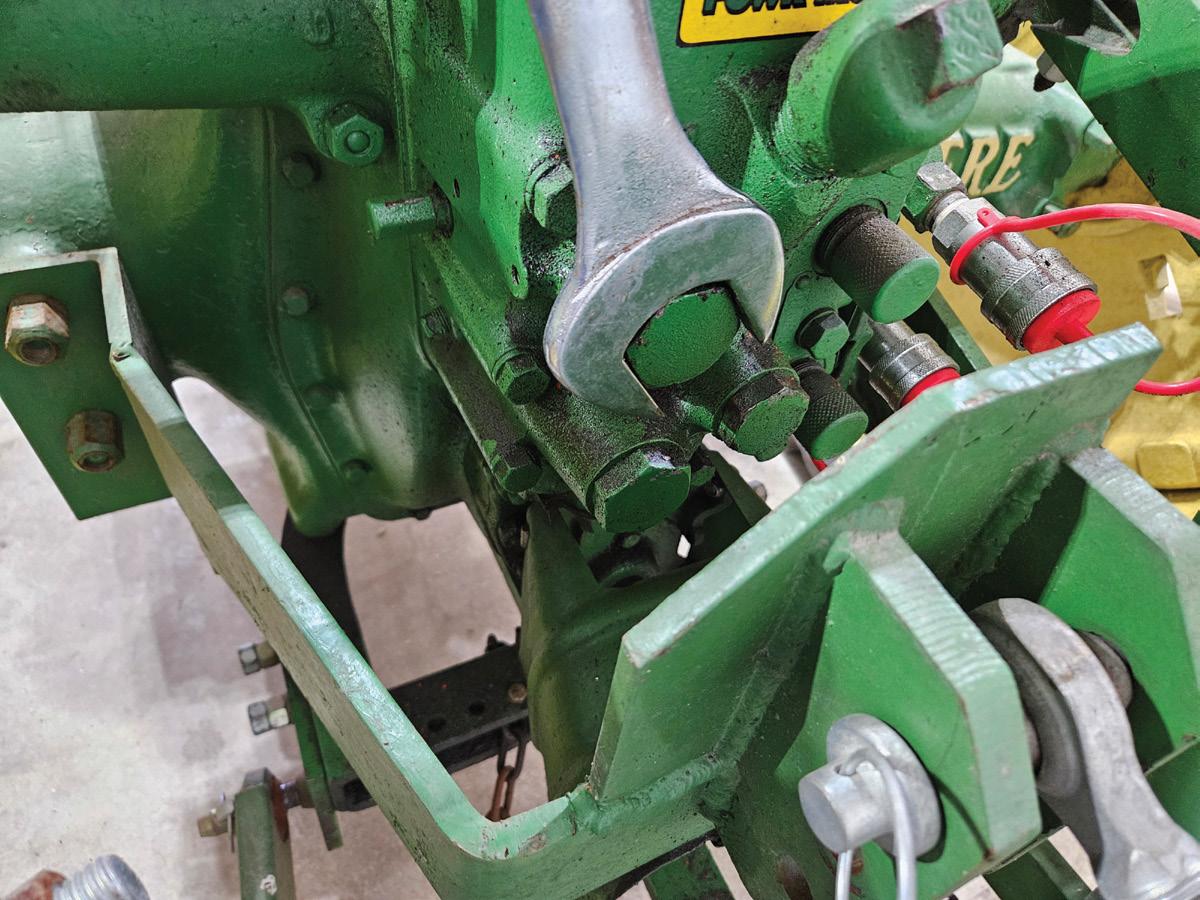
Remove the plug. You might want to have a small container to collect any oil that drips out. The first thing that will come out will be the spring. On my two tractors, the spring came out seperately in one case and was attached to the plug in the other.
These are the only other two parts that need to come out—the outer check valve and the inner check valve. Take your needle nose pliers, stick them in the hole, grab as shown,


and pull out the outer valve, which will also remove the inner valve.
You will see three different size holes in the larger, outside part. Hopefully, if you need more hydraulic power, you will find that the system is registered with one of the

smaller holes. If it is, simply re-align the flat spot on the smaller part with the largest hole and insert back in. Then put the combined check valve back in the tractor, add the spring, and reinstall the plug back.
That’s it. I got two new tractors for no cost! Believe me, it made me happy, and I hope it will make you happy, too!
Until next time, keep ‘em crankin’!
Rich Collins is a very small farmer in Sussex County, Delaware. He uses John Deere two cylinder tractors and other antique machines to get the work done. You can reach him by email at richcollins41@outlook.com.
pressure. Locate this plug on your tractor and break out your trusty 1-5/8 inch wrench.
Green Magazine® • April 2024 Page 41


I was sorting through a pile of 50 invoices from one dealer I had recently purchased. They date from June 1948 through December 1948. The dealership name was Smith-Cary Implement Service, and they were based in Harrisonburg, Virginia. As I looked through the invoices, being a partsman, I was looking at the various parts and items that were billed out. As I looked, it occurred to me that these invoices told a story and that is what I am going to share with you this month.
the prefix “H,” which would normally designate combine or mower parts, but in this case, with the “HW” suffix, these are corn binder parts, a machine supplied by the Welland factory.
Next is “VB,” which stands for the Van Brunt factory. These are all grain drill and cultivator parts. Then we have “Pltr,” which is the planter factory. This single part is a disk part. Finally, we have “Wloo,” which is of course the Waterloo factory where the tractors were made. As I looked

Photo 1 is our first invoice we will be looking at. Note the dealer’s name at the top left-hand corner, Smith-Cary Implement. In the middle, we see their servicing John Deere depot was John Deere Plow Company, based in Baltimore, Maryland. At the right it says, “Sheet #2,” so this was the second sheet of a larger order. Invoice number 69585 is also listed. We can see the actual parts are broken down into four sections. The first section has the label “Well” at the top. This stands for the Welland factory, so these parts were sourced from Welland. These parts start with

at the part number being charged out, AC1079R, I instantly knew what that was. Why did I know what it was? Because, back in the 1980s and 1990s when I was heavily involved in selling two-cylinder parts, AC1079R was one part I was always on the lookout for.
What is AC1079R? It is the top for the fuel sediment bowl used on so many two cylinders. The metal top had the all important “T” handle shutoff that, after decades, had failed on most surviving tractors. In all of my searching, I only ever found two new old stock AC1079R. You have
to realize that back in the ’80s and ’90s, there were many old-line Deere dealers still in business who had old parts stock that could be searched and purchased. Today, Deere has all but completed their eradication of the old, single store dealers and replaced them with what are, to them at least, modern marvels of efficiency and production. As I have said before, in my opinion, Deere has lost something rare and valuable by closing these old dealers. A crucial part of their history
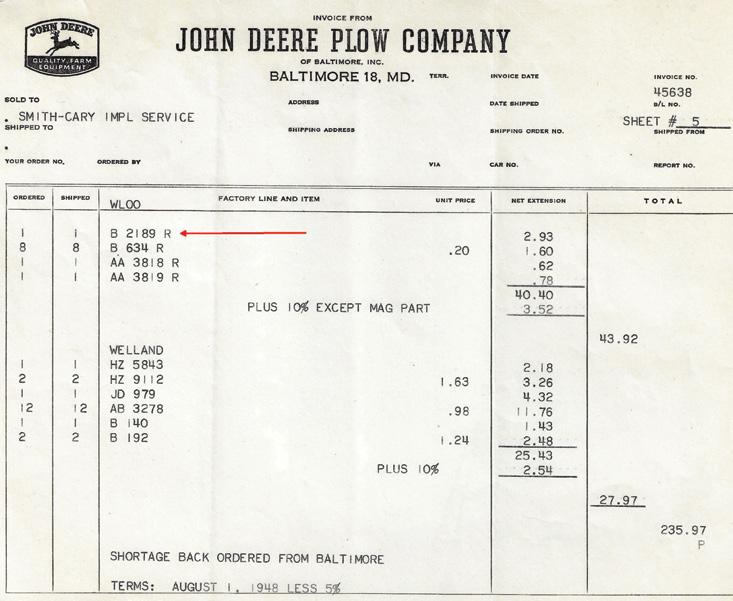
has been lost and it was by their own hands. Time will tell, I suppose. Back then, we had no other option than to install the current replacement that Deere and others offered. It was not cast iron like the original and did not have the “T” handle shutoff, but it did work. Today, there are several reproductions offered by the aftermarket of the original style. AC1079R is pointed out with an arrow in this page from the model “GP” parts catalog in Photo 2.
Photo 3 is sheet 5 and is invoice number 45638. This starts out with Waterloo parts, of which AA3818R and
Photo 1
Photo 3
Page 42 April 2024 • Green Magazine
Photo 2
AA3819R are rear wheel hub bolts for model “A” tractors and others. The lower half are Welland parts. I am puzzled by the notation “Plus 10%” at both the top and the bottom. Why was 10 percent added to the dealer cost? It does not make any sense to me. If I were that dealer, I would have demanded to know what was going on and why. I neglected to mention the great old four legged deer logo on each invoice. We cannot miss that!


Photo 4 shows one of the parts, B2189R rear wheel clamp or “donut,” with an arrow. Wow, $2.93, right? Of course, that is 1948 dollars.
Photo 5 is invoice number 9644 and is sheet 2, part of a larger order. Two part numbers jumped right out at me immediately. Part AA300R, which is the correct, original muffler for the model “A” tractor, and which was replaced by part AF3770R and part AA380R. AA380R is near and dear to me as it is the steering wheel for models “A,” “D” and “G” tractors but would fit so many, many other applications. When I was doing this in the ‘80s and ‘90s, the aftermarket barely existed for tractor parts so I was forced to source parts and often would end up having the parts made so customers could have them to either restore or keep their tractors running. I spent hours and hours researching parts Deere still had available and, wonder of wonders,
I found a steering wheel that, with a little modification, would replace the AA380R perfectly. Remember, back then there were not any reproduction or recovered steering wheels available. Once I had this steering wheel available, it was off to the races. I ordered and sold literally hundreds of these over the next few years. I even once got a call from Deere, who was concerned we had made a mistake in ordering so many of the steering wheels. I told them no; I had a need for them and to release the order. For a long time, we had more of these in stock than Deere itself did; it was comical to look the part AA380R up on Deere’s computer and see I had more sitting on my shelves than Deere did. All good things come to an end, however, and eventually they began to go on back order. I had sold everything Deere had available in the United States and eventually got a call from Deere telling me they were out of stock and unable to supply but did show to have some in Europe. Did I want them to source them from there? Of course I did, but there were not very many. Finally, the day arrived that the order I had placed came in with something new. Part AA380R was now obsolete and had been replaced by part AR505R. Now AR505R was also a steering wheel and at one time it looked like the original, like the AA380R did. I remember as one of the first times I came up against Deere’s “If it fits, it ships” policy. Yes, they did fit but they were a black injection molded monstrosity that were all plastic and did not have the metal spokes and rubber rim we needed for our restorations. So, I returned them all and put that part number to bed. It was a good run while it lasted. I did this with quite a few parts over the years, eventually selling all available stock Deere had until the part went obsolete. It was tremendous fun and fun to know Deere knew what I was doing. Why did they care? They were making money and getting rid of old


inventory. Good times. The other tractor parts are interesting also, as are the prices and the Delco part numbers at the bottom.
Photo 6 shows the AA380R steering wheel with an arrow.
Photo 7 I found interesting as Letz is at the top. Normally I would have thought B34 to be a tractor or grain binder part but in this case, it is for Letz feed mills. If I remember right, I believe the B34 were the grinder or burr plates. During my early years at the dealership, I would have a customer come in once in a while looking for burr plates and they were tougher than heck to locate in the mid 1970s—there just were not any left anywhere. Deere marketed Letz products and would eventually buy the Letz company and finally wound parts availability down in the 1970s. It also says shipped from factory; in this case I would assume it be the Letz factory and not Deere.
 Photo 8
Photo 6 • Photo 7, below
Photo 8
Photo 6 • Photo 7, below
Green Magazine® • April 2024 Page 43
Photo 4 • Photo 5, below
Under the “Ordered by” space at the top is a string of numbers which I believe were Deere’s order with Letz for these parts.
Photo 8 also has something interesting. Do you see the part number AM812T? and the price $3.29? Well, settle back and follow along. AM812T was replaced by part AM357T. Turns out AM812T/AM357T is the ignition switch on a model “M” tractor. In 1948, AM812T was $3.29. Surprisingly, the replacement AM357T is still offered by Deere. Any idea what the price is today from Deere? No? It is over $200! That is right—over $200. Converting 1948 dollars to current dollars, it comes out to $41.52. Obviously, something has changed.
Yes, the world and especially business has changed but something else has also. Corporations. In my opinion, this part is an example of today’s corporate pricing trends. The more, the better is their mantra. I think this mentality of everything being about a dollar is a lot of what is wrong with our country today. But that is just me. This is even harder to stomach when you can get the same switch aftermarket for just over $100. Still tough but easier to pay that price. The other part, AM346T, was replaced by part M2544T and it is the knob that goes

on the starter link you pull to start a model “M.” These do tend to fail and looks like they were having the same problem as Smith-Cary ordered five of them. M2544T—16 cents in 1948 and now, it is $21.92 from Deere, under $8 aftermarket.
Photo 9 shows the AM357T switch with an arrow.
Photo 10 caught my eye due to the word “doubletrees.” I guess it should not be surprising that in 1948, Deere was still offering parts for horse farming. On many farms, horses were still used alongside the tractor in the 1940s. The “PW” above the part designates Plow Works so this was a hitch part for a horse drawn plow or similar. Interesting.
Photo 11 is an invoice for something different—jackets! As this was December, we might surmise that


someone was going to get a neat Christmas present! No doubt this was an outside vendor and under the “ordered by,” we have text and date that likely enabled Deere to track this order from this vendor. I wish I knew what #810 jacket is, but catalogs for this early clothing and merchandise are notoriously difficult to locate. Must have been a nice jacket as $7.25 in 1948 is the same as $91.49 in current dollars.

This June 1948 invoice has machinery charged on it so that is a bit different than just parts (Photo 12). Here we have three No. 4 mowers and two No. 5 sickle mowers. The No. 4 mowers were ordered
with oilers and rock guards. The No. 5 mowers also were equipped with rock guards from the factory. The figures handwritten to the right of the No. 4 mowers I believe were the landed cost to the dealer with freight added in. The figures written to the right of the No. 5 mowers are totals owed with a deduction for the amount paid,
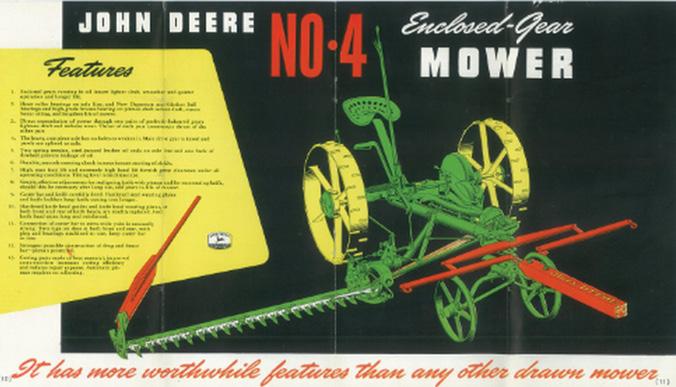
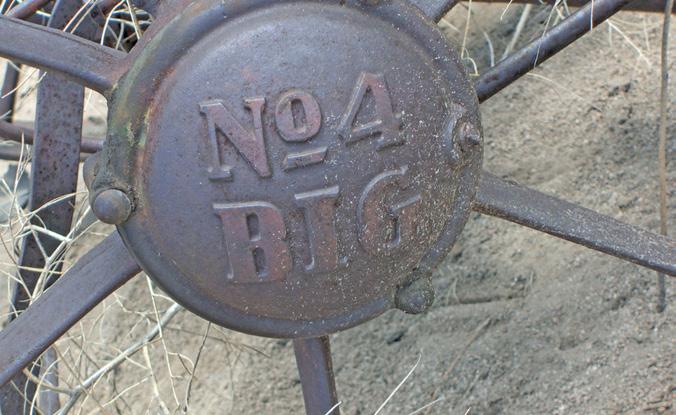
leaving total owed at the bottom and marked “Due.” This order highlights the horse versus tractor scenario that was still going on with farmers as the No. 4 are tongue or horse drawn whereas the No. 5 is drawbar or tractor mounted.
Photo 13 is the No. 4 pull behind mower, taken from a sales brochure.
Completely disregarding anything else, this hubcap with “No. 4 BIG” cast in it is the single best thing to me about the No. 4 mower (Photo 14). When I was first getting into all this, at a John Deere Day, the video we showed to customers had a segment featuring Lawrence VanZante of Pella, Iowa, a well known restorer renowned for his flawless restorations and silk-screened hoods. I never did meet Lawrence, but I certainly respect the work he did. He passed in 2019, I understand. I wish I
 Photo 11 • Photo 12, below
Photo 13 • Photo 14, below
Photo 15
Photo 11 • Photo 12, below
Photo 13 • Photo 14, below
Photo 15
Page 44 April 2024 • Green Magazine
Photo 9 • Photo 10, below


had talked with him. In this segment, Lawrence is shown taking down his cloth spine parts catalogs and a No. 4 mower is also shown with this hubcap. I became obsessed until I too had cloth spine parts books and a No. 4 mower. It did take me some years, but I eventually did get them. I even have somewhere one or two new old stock No. 4 hubcaps. Pretty neat stuff.
Photo 15 is where Smith-Cary ordered some toy wagons! They ordered 12 and the cost was 85 cents each. This was in October of 1948.
In December, Smith-Cary ordered quarts of both green and yellow John Deere paint. The yellow was on back order and would ship when available. Cost was 89 cents for each



quart. You do not often see anything about paint from this time period, so this is nice to have (Photo 16).
Photo 17 is an invoice for more Letz parts and also, SPDR (Spreader), PW (Plow Works) and PLTR (Planter) parts. Wow! The toy wagons must have been selling like hot cakes as now 36 more were ordered! Who knows, this might have been getting ready for Christmas, maybe they were sold to a local business for a giveaway or



maybe even were donated. We will never know (Photo 18).
I have written before about the fact that John Deere used to not only sell parts but if sent in, they would also repair items such as crankshafts, connecting rods, carburetors, and a lot more. In this case, this invoice was for a repair on AH6553R magneto, the magneto used on a model “H” tractor. This was a Wico type “C” magneto and, in this case, the main bakelite body, part X2798, was used in the repair. The part was $2.25, and the labor was $2.00 (Photo 19).
Photo 20 is the parts breakdown for the AH653R magneto and the X2798 is shown with an arrow.
Photo 21 is an invoice for a case of John Deere book matches, imprinted with the dealer name. This was a more than common giveaway in most businesses at this time and continued up until the 1980s, maybe? I know we used to always have a box of matches, free for the taking, that had our name on them. Eventually, as the health issues with smoking became more prominent and restrictions were placed on where and when you could smoke, the free matches went away and became, mostly, a thing of the past. Again, I have never seen an invoice for matches before so was glad to get this one.
Photo 22 shows freight charges. This freight is for Smith-Cary’s portion of a rail car that a tractor was shipped on. Rail cars were often shared, and this car was shipped to Lupton Or-
Photo 18 • Photo 19, below
Photo 22 • Photo 23, below
Photo 20 • Photo 21, below
Green Magazine® • April 2024 Page 45
Photo 16 • Photo 17, below

chard Services in Winchester, Virginia. More than likely the Lupton Orchard dealer had more freight on the car than Smith-Carry did. Looking it up, it appears the two towns are 68 miles apart so that is not too bad, and a split load makes sense.
On this invoice, we again have a lot of parts from the Welland factory (Photo 23). This time they are from a grain binder. At the bottom we have the WGN designation for the Wagon Works factory.
Thirty-six of part HZ147HW were ordered (Photo 24). These are the guards used on the light running grain binder, so this is an often-needed part. This guard is shown in the parts page here with the arrow. These guards were 33 cents at this time and of course are obsolete today. I can tell you that single guards for many John Deere sickle mowers, part AE36136, are a bit over $14 today.
Photo 25 is an invoice for part AE36. It is marked DUB for the Dubuque factory. I could not locate my parts catalog, of course, but from memory, I thought that AE36 is the part number for the magneto on a John Deere type “E” gas engine. Still grumbling about being able to locate my catalog, I went to the John Deere/ Root N VanDerVoort group I belong




to on Facebook and, as I hoped, they had a pdf of the parts catalog. It is confirmed that AE36 is indeed the part number for the complete magneto on the type “E” flywheel engines. This is one of the many part numbers that have taken up permanent residence in what was once my formidable brain.
The reason I remember this one is that not too long after we bought the dealership in 1976, I found three gas engines tucked away under a shelf in the shop. Two were type “E” engines. I dug around and found an original parts catalog we had in the parts department and studied it a bit. From my memory and this being in the late 1970s, I believe Deere still had stock on AE36RT magneto. Being as I was young and very fresh to the hobby, I was hesitant to order one. I waffled on this decision off and on for a year. When I finally decided I should, guess what? Yep, they were gone and obsolete. If it had been a few years later, I would have ordered every single one they had. I always wished I had ordered just one to have a new
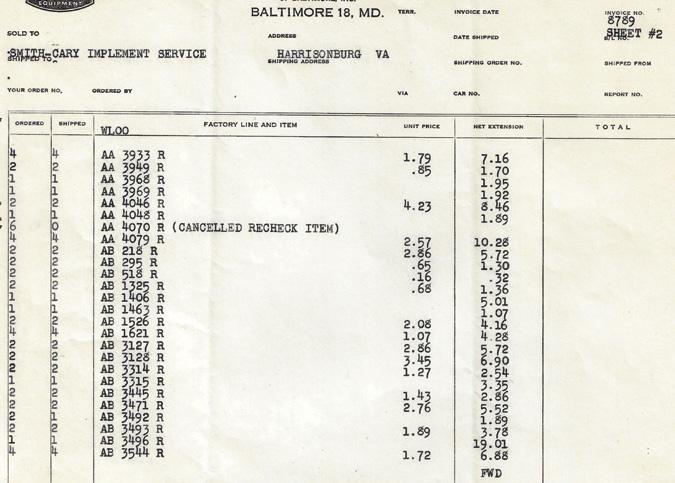

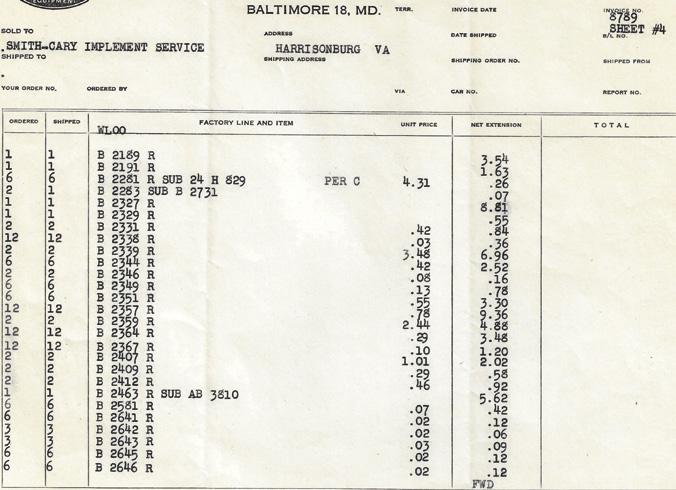
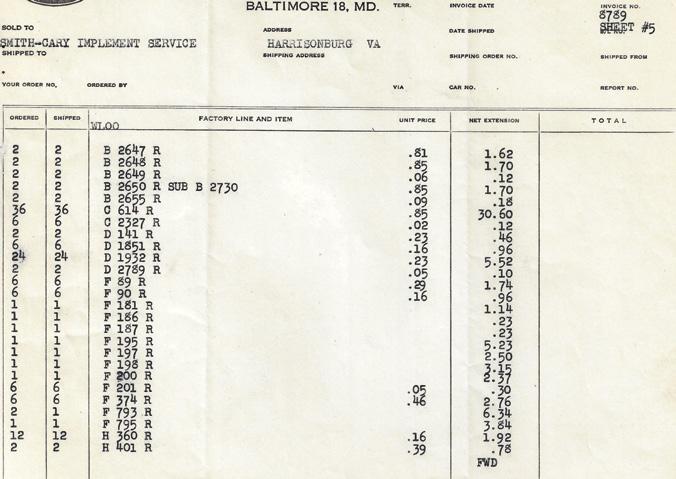
old stock gas engine magneto in my hands. Anyway, to see the AE36 on an invoice means a great deal to me. In current money, the magneto would have cost $226.14. New ones are now available aftermarket as this is one of the main problem areas when restoring a John Deere gas engine. I believe they are in the $200 to $300 range today reproduction.
Here is another great invoice (Photo 26). This one is for John Deere
Photo 31 • Photo 32, below
Photo 29 • Photo 30, below
Photo 27 • Photo 28, below
Photo 25 • Photo 26, below
Page 46 April 2024 • Green Magazine
Photo 24


key chains! Smith-Cary ordered 12 and they were 18 cents each. I think I can say without fear of contradiction that they would bring a good bit more than 18 cents today!
Another good one—this invoice shows parts but at the top is a charge for 500 of the DC173 repair bin tags (Photo 27). All of these items we are looking at—the toys, key tags, coats, bin tags—are all highly collectible today. It is neat to see when they were originally ordered, I think.
Photo 28 shows what the DC173 repair bin tags look like. Thanks to the sharing of a friend, I have these in my collection. Thank you, friend!
The next few pictures are from a very large order, which is interesting by itself. I suspect this was some form of a preseason or stock order as it does not make sense that this many parts were sold in this space of time. Let us see what is on it. This entire invoice, and it is sheet 2 by the way, consists of Waterloo or tractor parts. It starts with the “AA” prefix parts at the top and works down to the “AB” prefix at the bottom (Photo 29).
Photo 30 is sheet 3 and the “AB” numbers continue, through “AF” and down to the “B” prefix. Still tractor parts.

Sheet 4 is next, and it has all “B” prefix part numbers (Photo 31).
Photo 32 is sheet 5 and it is “B,” “C,” “D” and “F” prefix part numbers. So, parts for models “B,” “GP,” “D” and “G” tractors!
Sheet 6 is this one (Photo 33). This invoice has a lot of JD prefix bearings and then Delco part numbers.
This invoice has SPDR or Spreader Works parts at the top then Waterloo or tractor parts at the bottom (Photo 34).
Photo 35 we have parts from OTTUM or the Ottumwa factory. This is mainly haying equipment like balers, rakes, and the like. At the bottom we have more tractor parts.
For our final picture, I finally found one item on the internet that was from Smith-Cary Implement. I had looked and looked and searched and I was convinced that the only evidence they ever existed were these invoices I had as there is no mention of the company anywhere I could find. I tried one more time and I finally located this.
Photo 36 is a picture of a pocket ledger from Smith-Cary Implement Service. It is great to see at least one token of this company has survived although I am sure there are others. I found this one on Worthpoint as it had been sold some time ago.
I know it is part just my predisposition for parts but there is a lot of information in these vintage invoices. It is a snapshot into the life of John Deere dealer at this time as the parts ordered and invoiced reflect what was going on at that dealership. This dealer I think had to have been fairly busy for this number of parts to have been ordered during this seven-month

period. And remember, I do not have all of the invoices and we may be missing others entirely.
What I think makes these worth looking at is it is not just the parts. The ancillary items, for advertising, such as the toys, matchbooks, and more, help us build a more complete picture of what it took to be a dealer at this time. No doubt there are many other invoices and billings for machinery, advertising and more that are lost to us forever.
I was so glad to find that picture of the Smith-Cary pocket ledger. It made their dealership seem more of a real thing to me for some reason. I am sure other bits and pieces exist or are in collections that are from them but there likely are not very many. I know somewhere I have a catalog or two that may show what the items like the coats, toys and matches were. That would have been great to be able to share those too, but they are lost at this point, for now. I still have many invoices from our days as a dealer stored away and I am thinking I maybe should keep a few of them. There is no way to keep all of them, there are far too many, but a few would a good thing to have, I think. I hope you enjoyed taking a look at these—until next time.
Write Greg Stephen at The Old Tractor Company, Box 89, Franktown, CO 80116; phone 231-846-8243 or email deeredr@hotmail.com
Photo 36
Photo 35
Green Magazine® • April 2024 Page 47
Photo 33 • Photo 34, below


This month I decided to share a 1/64th scale set within the Replica series of Ertl toys. Recall that Replica models are truly toys designed to be played with, versus Prestige and Precision miniatures that are highly detailed pieces intended for collectors. The truth is that prior to the early 1980s, all of the Ertl toys were really “Replica” models. The difference is that they weren’t called that; they were just farm toys. In the 2022 Ertl John Deere toy catalog, the “Vintage 7720 Combine Harvesting Set” was identified as a new item. It continued in the 2023 catalog and is now in the 2024 catalog. I purchased one of these sets recently at my local John Deere dealership just to check out the quality and detail on current Replica models in 1/64th scale, and because it seemed to be a really neat collection of toys. It carries Ertl stock number LP81106 and Sku 45821.
Photo 1 shows the carton with the toys inside. This is an open top and front cardboard carton printed with a green, yellow, and white background. The lettering uses the same colors plus black. Note the “REPLICA PLAY” insignia in the lower right corner and the John Deere trademark in the upper left. These items are included on most of the panels of the carton. On the left end panel, there is a partial full color photograph of a 55 series John Deere tractor and, on the right panel, there is a similar style of picture of a John Deere model 500 grain cart. The rear


panel (Photo 2) features a photograph of a real 7720 combine with a grain head. It appears like it could have been artwork from the introduction of the real machine.
Inside the carton is a heavy cardstock sleeve printed with a yellow background as shown in Photo 3. The toys rest on a clear plastic base that is held in place with a clear plastic cover that is glued to the sleeve. So, in order to remove the toys, the plastic cover has to be cut away or ripped off of the sleeve. I chose not to completely destroy the materials so I gently cut away part of the outer cover with a razor knife.
Photo 4 shows the complete set of toys. Included are a 7720 combine, model 643 corn head, model 216 grain head, 4555 tractor, and model 500
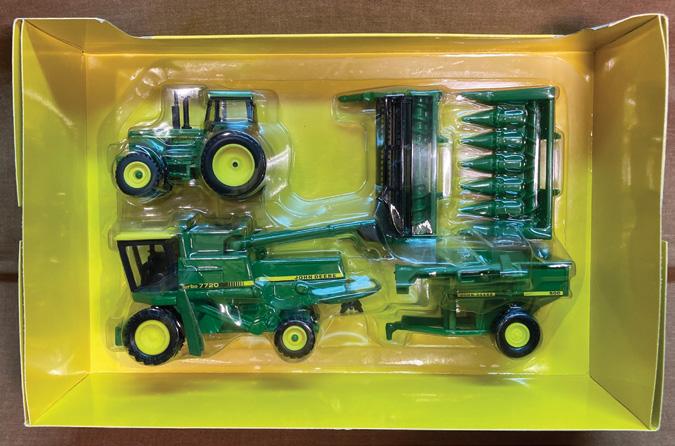

grain cart. While Ertl and John Deere consider machines that are 20 years old or more “vintage,” it is hard for me to consider these specific examples from the 1980s to be “vintage.” Time simply passes way too fast.
The two headers are shown in Photo 5. Both are made completely of plastic. The corn head is a six-row model that is a single cast piece. The gathering chains and auger are molded directly in place. Tiny green, yellow, and black self-adhesive decals are provided on each end, which include the John Deere trademark and the model designation. The grain head is made from two plastic parts. The first is the main structure that includes the cutter bar with sections, feeding auger,
Photo 1 • Photo 2, below
Page 48 April 2024 • Green Magazine
Photo 3 • Photo 4, below
and the ends. This is molded in green plastic. The other is the gathering reel that is molded in black plastic. The reel is pressed into place on top of the sides of the head and it is able to be rotated. Either head can be attached to the feeder house of the combine by pressing two notches on the rear over metal tabs on the combine.
Photos 6 and 7 provide left and right side views of the 7720 combine. Much of the toy is made from three die-cast metal pieces. These include a left and right “half” on the lower portion and a single “top” that includes the engine area, lower portion of the grain tank, and the top of the combine over the walker area. What is especially nice is that the Ertl designers placed the seams in an arrangement such that they are barely visible. In addition, they did a really nice job of casting in several details for added realism. As examples, there are small “handrails” on the front of the combine, immediately behind the cab entrance door, and next to the access ladder on the right side. Some of the belts and guards, and portions of the clean grain elevator, are also present.
All of the items that I would call “added” details are made of plastic. The cab features a yellow roof with strengthening ribs, a black outer structure, and a clear set of “windows.” Molded into the windshield is a wiper, accented in silver. Inside it is possible
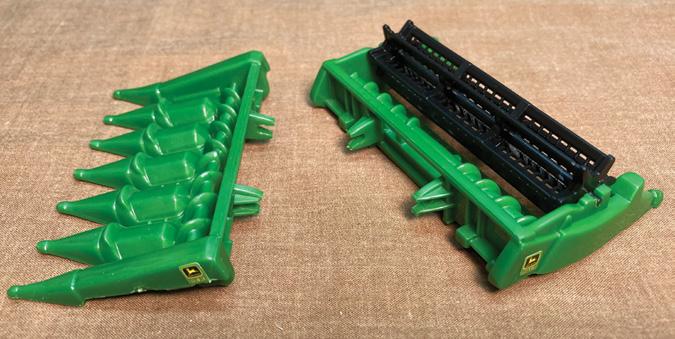


to see the steering column, steering wheel, and seat. These have been painted in a combination of beige and black. Access ladders are provided on both sides of the machine. Along the right side of the grain tank is a black plastic pre-cleaner for the engine. Just below that, and near the front of the machine, is the rotary screen with vacuum pickup molded in place. The grain tank is also plastic and includes the loading auger and some of the structural supports that are found on the real combine. The unloading auger swings 90 degrees and includes the discharge “spout” on the end highlighted in black. An optional straw spreader is attached to the rear of the machine with a green guard and two black “fans.” The guard appears to be just a bit too large in size, but had to be made that way to have enough strength for play.
Dual wheels and tires are provided on the front, and bar tread tires are on the rear, indicating that this machine has the four-wheel-drive option. The rear axle oscillates, but does not “steer” despite having steering arms and a tie-rod.
The fit, finish, and graphics are very good on this toy. Yellow and black self-adhesive strobe decals are on both sides of the toy with “TURBO 7720” and the John Deere name printed in yellow and black letters respectively. A slow moving vehicle sign is on the rear, which is also a self-adhesive decal. Black and yellow John Deere trademarks are printed on the back of the machine and also on the front just below the cab. “Hydrostatic” is also printed on the front in black-outlined yellow letters.
The model 500 grain cart is
shown in Photos 8 and 9. This is a much simpler toy than the combine, but has several realistic details nonetheless. It is made from two die-cast metal pieces. The first is the hitch and frame that includes the PTO shield. The second is the grain box which is secured to the frame with four rivets. A ladder is cast directly into the front of the grain box and the unloading auger cover is cast into the bottom of the interior of the box. The unloading auger consists of two plastic pieces that are connected with a “hinge” between them. This allows the auger to be raised for unloading and lowered for transport.
The tires have a turf-style pattern and are mounted on yellow plastic rims. Interestingly enough, the graphics are all printed in place which I feel really adds realism. Included are a yellow and black John Deere trademark on the back and yellow stripes with a black outline on each side. The John Deere name and the model designation are printed in black on top of the stripes.
Photos 10 and 11 provide a couple of views of the model 4555 tractor. This toy is assembled in a fashion much more like what I would expect for a Replica series tractor. Not that it

 Photo 8 • Photo 9, below
Photo 5 • Photo 6, below
Photo 8 • Photo 9, below
Photo 5 • Photo 6, below
Green Magazine® • April 2024 Page 49
Photo 7

is bad, but the main part of the toy is formed from two die-cast metal halves that have a seam right down the middle of the tractor. The plastic cab roof and black paint on the cab structure help to hide some of this. However, the seam on the hood and through the front weights is noticeable. In addition, the weights have an unusual taper which is required to allow the castings to come out of their respective molds. Regardless, this is a nicely detailed tractor.
The air intake and muffler with rain cap are separately-cast black plastic items. Red and black paint circles are on the top of the hood to represent the fuel and radiator caps. A hood ornament is cast in place and has been accented in silver.
I included Photo 12 to help point out some of the great details provided on a toy tractor of this size. Note the two handrails cast into the side of the hood. One is directly above the front wheel and the other immediately in front of the cab. All of the air intake screens are provided, and a section of them is blacked out just in front of the engine as on the real tractor. The amount of engine detail is very good, and is typical of most Ertl toy tractors. However, it appears that a little bit of creative license was taken. Note that this miniature has an aftercooler and that there is a bump on the rear cover just ahead of the cab. These items would have been on the 4755,
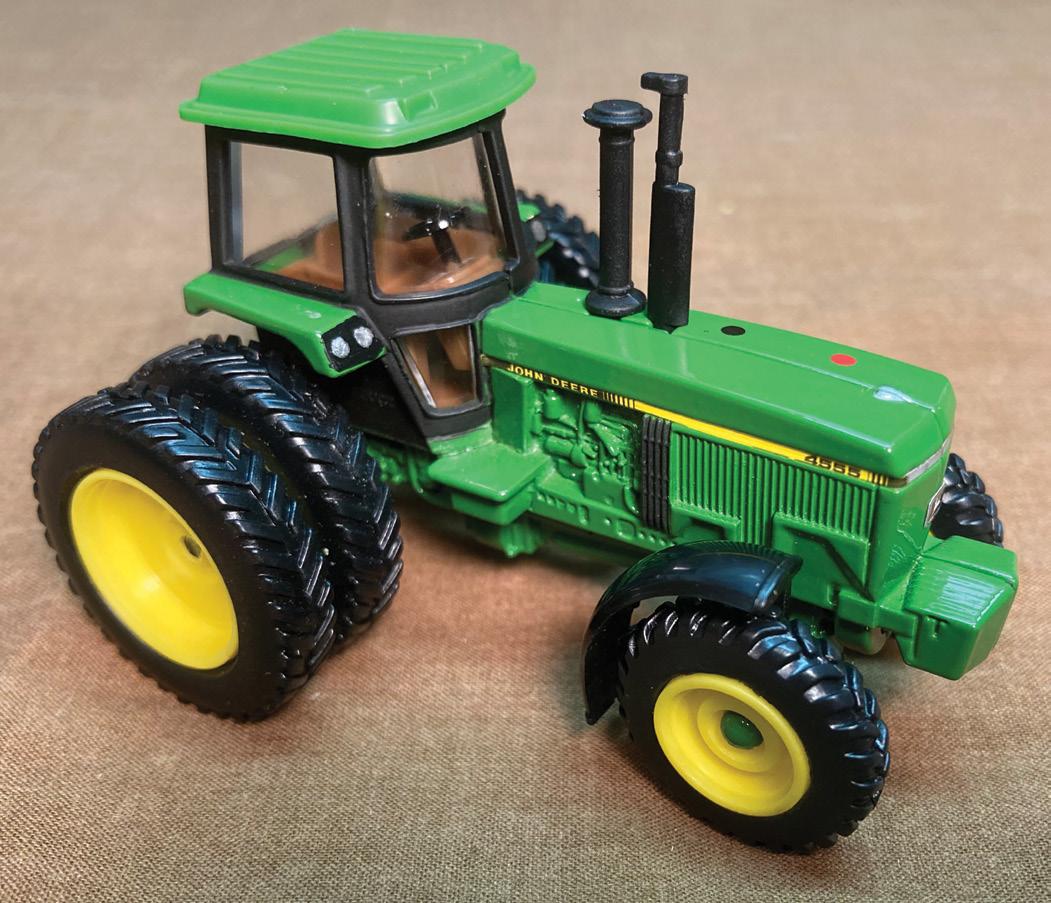
but not the 4555. Since the tractors are dimensionally the same, it appears that Ertl repurposed some of their castings from other models. It’s not a big deal for a child’s toy, but would be for a collector.
A full set of cab access steps is included and the cab has clear plastic “windows.” While it is difficult to see much of the interior, the seat, dash, and steering wheel are included. The steering wheel is black and the rest of the interior is brown. Silver work lights in a black housing are printed on the front of the fenders and red tail lights are on the rear. A slow moving vehicle emblem is also on the back of the cab.
This tractor features mechanical front wheel drive, so the front tires have a bar tread pattern. In addition, there is a driveshaft cast into the bottom of the tractor. Optional front fenders are included as a bonus. Dual rear wheels and tires are mounted on the rear, and the rear axle is accented in black.
The overall fit and finish of the tractor are very good. The paint is smooth and the components are installed correctly. In addition to the graphics already mentioned, there is a self-adhesive decal that covers both sides and the front of the tractor. It has the yellow stripe with the black strobe pattern, along with the John Deere name and the 4555 model designation. On the front, there are four

headlights printed into this stripe. Just below the headlights is a tiny silver and black John Deere trademark.
In overall terms, I am impressed with the amount and quality of detail on the toys in this Replica set. I was expecting simpler toys with fewer features and much less in the way of graphics. Perhaps some of this is a carry-over from other models that Ertl has already produced. The only complaint I have is the price. I paid $36.99 plus tax at my local John Deere dealership. This set is intended for children age three and above and for the same price, it is possible to purchase approximately 30 Hot Wheels or Matchbox cars and trucks. So, I’m just wondering whether or not these farm toys are really intended just for little kids. Enjoy.
Contact Bill Proft at N1366 Woodland Dr., Greenville, WI 54942 or email billproft@sbcglobal.net
Photo 12
Page 50 April 2024 • Green Magazine
Photo 10 • Photo 11, right


G’day, mates. As we near the end of summer in Australia, I will say that it has been one of the most hot and humid summers we have experienced in the 10-1/2 years living here. We had hot weather in Goondiwindi in 2013, but it is a dry heat without the added humidity. Rain has been ridiculous in our area as well as most of Australia over the past few months. On February 25th, the area of Tully (which is 1,000 miles/1,600 kilometers north of our property) received 450 millimetres/18 inches of rain in 24 hours—incredible numbers! I have returned to work after my hip replacement surgery. The rehabilitation has gone very well; I am pain free for the first time in five years.
This month, I will finish my Canada working holiday trip. On September 8th, the washing company returned and rewashed all the tractors, hitting any of the spots they missed the previous day. While they were washing the tractors, my friend, Dave Lockwood, came back for the day to help. He had several items of vintage John Deere equipment stored up in the barn. I assisted him to pull all the items out of the barn with my 2155 and park them outside. Over the next couple weeks, Dave would bring new tires on rims and install them on the equipment. Then he would transport the equipment to his storage building near where he lives. We spent the rest of that day going through my wagon load of parts and pieces. Dave picked parts he wanted to keep, and I picked
out what I wanted to keep to ship to Australia.
September the 10th, I started the morning at the farm getting all my farm toys out of the containers. I used a water hose and washed all the farm toys to get them clean to ship to Australia. After lunch, I attended the local fall fair with my mother and sister and then my mother hosted a family get together at her house for my cousins on my father's side of the family. I had posted an ad on our Ontario two-cylinder clubs’ Facebook pages, looking for parts to possibly bring back to Australia for people. My friend, Don near Woodstock, phoned to say that he had several parts I was looking for. After supper, I traveled to his place, checked out his collection and the parts that he wanted to sell. He has a lovely collection of vintage John Deere tractors.
September 11th and 12th were spent going through more of the household items, including my farm toys and getting them packed up. My friend, Wayne, was able to come and help package up the farm toys and other items for us to ship to Australia.
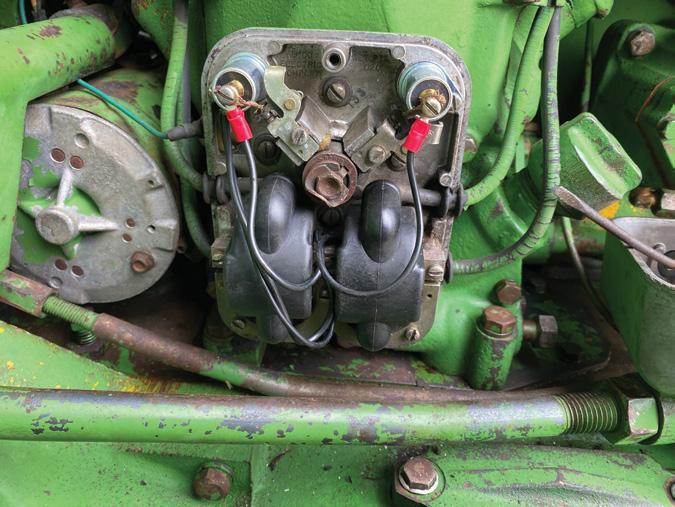
After I fixed the 820 starting issue, I realized I needed ignition coils to fix the 720 cranking engine. I ordered a few parts from my supplier in the USA, which arrived within a week. These parts included ignition coils, a muffler and a pulley cover for the 720. I had them shipped to my mom’s apartment in Tavistock. On the 13th, I decided to tackle the 720 non starting issue on the cranking engine that had been there since I've owned it. I did the same repairs as I did on the 820 to replace the coils. After the new coils were installed and the points cleaned and adjusted, I tried to start the 720 cranking engine. After several spins of the starter, the cranking engine roared to life. The cranking engine idled good and revved up perfectly to start the main diesel engine. This repair was long overdue and should have been done years ago.
I went to install the new muffler on the 720. I had to order the 24 inch tall muffler as that is the only reproduction muffler available without the dent on the side. The muffler that I had on the tractor was for a model “A” with the dent on the side. It matched the height of the pre-cleaner on the air cleaner. Years ago, I had taken a tool and torch and internally pressed out the dent as the 720 does not need it. The “A” muffler with the dent is 21 inches tall and the only muffler that can be ordered that height. I asked the question on a Facebook page, and I was told that I had the incorrect air cleaner pipe on
Green Magazine® • April 2024 Page 51
New coils installed.
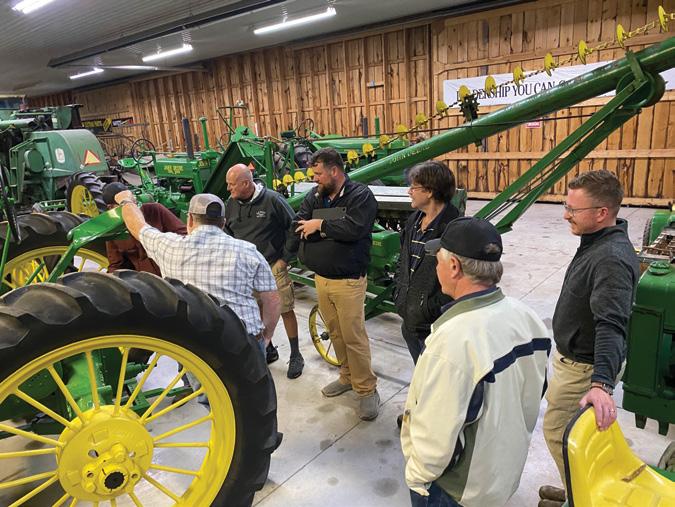


my tractor, even though it is original. I was told that the air cleaner needed that cast iron riser block that the 730 tractors used. Once I had the muffler bolted on, it sat three inches taller than then the top of the pre-cleaner. I personally think this looks terrible; I will sort this out when I get to Australia.
I had talked to Tyler Buchheit on Facebook and realized that he was in Ontario to attend the Outdoor Farm Show. The show is only 25 kilometres/ 15 miles south of my former farm. We arranged to meet up for dinner and to catch up. I had not seen him since 2017 when we met at the New York State Expo. I credit him with me writing in Green Magazine. He had previously read my Facebook posts and thought that my way of telling a story would be a good addition to the magazine. Richard and Carol Hain were also at the New York State Expo that year. Tyler took me over to meet them and I just happened to have a copy of our local two-cylinder club newsletter that I wrote a story for. Carol read over the story and asked if I would be interested in writing articles for their magazine, which I said yes!
Back to present day, Tyler and I decided to meet up for dinner. I decided to get a few of my local tractor friends to also attend the dinner, including Don and Julie Budd. After a great dinner, we went to Don and Julie’s museum for Tyler to view the collection. It was great to meet up with Tyler again.
September 14th was spent going through more items, boxing up some for shipment to Australia. September the 15th was a big day. Calvin brought his truck and trailer and parked them in the yard. He waited with me until the truck arrived with the sea container
on the trailer. That trucker unhooked his highway tractor and left. Calvin hooked onto the sea container trailer and backed it into position in front of his trailer in the middle of the yard. Calvin left his highway tractor at my place, connected to the sea container trailer, and I drove him back to his farm. I had a great tour of his collection, which is Allis Chalmers. It was great to see his collection. I like all brands of tractors but personally stick to the green and yellow. That evening I went down to Dave Lockwood’s son Matthew’s house. They were busy restoring Matthew’s 110 lawn mower that he had completely dismantled and was busy putting back together. We had a good night working on the lawn mower and had a great visit.
Saturday, September 16th, was a huge day. I had arranged for some neighbors and friends, including my daughter, Maris, to assist loading the sea container. Matthew Lockwood had the task of building plywood blocks. He cut three inch strips of plywood and then stacked them on top of each other to build a block. These blocks were nailed to the floor of the sea container on the inside edge of all the rear tires. We started with the 820 backing it in and then tying it down to the sea container hold down points. After it was in place, we placed a bunch of boxes of personal items around the tractor on each side to take up the space. Once that area was full, then we backed the 620 in front of the 820 and strapped it down to the floor. Then more boxes and articles were packed around the 620.
The 720 was driven in forward so that it would overlap the front of the 620 nose. The 720 was then tied down and then articles were placed in front of the 720, between it and the 620 on the floor. The little Ford Jubilee
was driven in next. After measuring and viewing the situation, I decided that the priority was to get the two 110 lawn mowers loaded as well as all the parts. The hard decision was made to park the little Ford back outside and possibly leave it until I can ship another sea container of tractors. Our vertical log splitter was put in first on the left side and then my Snap-on toolbox fit on the right side. The 110s were driven in and parked side by side. After some thought and a phone message from Graeme Howden in New Zealand, I agreed to his idea. He suggested that I build a frame and floor on top of the 110s to store all the pieces and parts. That was a good idea, and I came up with a design in a game plan.
September 17th, my former neighbor Eric and Dave Lockwood came over to assist. We discussed my frame idea, and we went over to the local welding shop. The owner was available on Sunday morning to help and sold me some steel. I purchased 1-1/2 inch square tubing in the correct amount and cut the length. After we returned to the farm with the steel, I asked Eric to go to the local Home Depot to get plywood. While he was gone, Dave Lockwood and I welded up the tube frame and then carried it over and set it in the sea container. When Eric returned, I bolted the plywood onto the frame to make a shelf.
After that was completed, Dave and Eric left. I proceeded to pack parts and pieces into the container to fill the back of the container. I was able to fit Janis’ childhood cedar chest on top of the shelf under some of the tractor hoods. September 18th was spent also cleaning up items to go into container as well as a few that I purchased that morning from another friend in the area. These parts included a belt pul-
Tyler and friends checking out the Budds’ museum.
Page 52 April 2024 • Green Magazine
Tyler and me. Boxes packed around the 820.



ley for a 1010 to 4010 tractor. All these items were then put into blue plastic bins in the back of container and on the shelf. Once everything was packed in, I strapped it all down. Calvin arrived late in the day. He pulled the sea container trailer out of the way and left with his truck and trailer.
September 19th in the morning, I was able to go to the last few items that I wanted to put in the sea container. I had to use a step ladder to put the last items in. Around lunchtime, the truck arrived to transport the sea container on its journey to Australia. The rest of the day and the 20th, I went through some boxes and realized that those items should have been in the container. I ended up re-boxing a bunch of items to mail over.
September 21st—Dave Lockwood arrived at the farm. We loaded the unstyled “D” and Ford Jubilee on separate trailer loads. We delivered them to my friend Doug’s farm to store in a former hog barn. The 22nd, Eric arrived, and we transported the hay wagon and all the left over farm items to an upcoming auction sale. The 23rd, another auction company came to the farm and loaded all the furniture and items that were saleable onto a truck. September 24th was another sad day. I finished up the need for my 2155 loader tractor, and it was time for it to leave to its new owner. My friend, Leigh, had bought the tractor and sent my other friend, Bob Walker, to my farm to pick it up. Once he left, I drove the 720 gas standard the 10 miles to my friend Doug’s farm to its new home! At the end of that day, no more tractors were on my former farm anymore. It was the end of an era.
September 25 and 26th were
spent doing errands and cleaning up some loose ends. I toured the Minler family’s new vintage tractor museum and saw their fabulous collection. They also own the 820 that was at the local sawmill I remember from when I was a young boy. It was a great night. The 27th, I helped Eric prepare his forage harvester for the upcoming corn silage harvest. The 28th, I stopped in at my former dealership and visited with staff there. Only two staff remain that were there when I worked there in 2013. The 29th was spent helping Eric again on his forage harvester. Later in the afternoon, I traveled to the place of my friends, Pat and Henry Deter, to visit and catch up. I stayed overnight there, and then the next morning, on the 30th, I went to the auction sale where my items were being sold. I was happy to see all my items go to new homes. I was able to see a few more tractor friends there that I had not seen previously during my Ontario visit. That evening was spent with my friends, Joan and Dave Lockwood, for a visit and dinner. It was another great night.
October 1st, my mother planned a family dinner for her relatives at my sister’s place. It was another great day of catching up with my relatives.
One last picture with my mom before heading to the airport.

October 2nd, I was able to get the Ford Jubilee and the unstyled “D” parked in Doug’s barn and stored away. After that was completed, I was able to ride along with Doug while he opened his silage fields with their John Deere 5400 self-propelled forage harvester. I was able to take the wheel for a couple of loads as well. It was a highlight day of the trip! October 3rd, I was able to visit tractor collections of my friends, Reg, Jim and Wayne Gurney. They all have fabulous collections as well. October 4th was spent making sure all loose ends were finished at the former farm. I took one good last look around as this was the end of my life on this property. A lot of good and bad memories happened over the years. I will say I did shed a bit of moisture on the last tour, but I knew it was time to leave.
October 5th was my last day in Ontario. I had a good last morning with my mom at her apartment building. The airbus arrived around lunch and took me to the Toronto International Airport. The flights went well, first to Vancouver, then a transfer to a second flight to Brisbane. The flight arrived in the morning on the 7th, so the 6th was totally lost in the time change. All the baggage arrived with me and there were no issues with customs. Janis was there to meet me, and it was a lovely reunion.
That ends the story of the Ontario working holiday. I know it was a long story and a big trip, but I wanted to share the adventure. I hope everyone enjoyed traveling along with me. Stay tuned next month, when I cover the trip of the sea container and the arrival of our tractors and items to Australia. Until next time—cheers, mates!
Contact Ken Nicklas by email at kenanicklas@gmail.com
Reg and Jim Gurney’s big diesels lined up.
Sitting on my childhood 820. 5400 in action.
Green Magazine® • April 2024 Page 53

No results yet from our February quest to find a 282 cotton stripper. They were likely very few sold, so finding one now might be nearly impossible.
I was recently asked if there was a list anywhere of the items we have searched for in the past. I have kept a list on my computer for quite a while, in order to try and keep myself from repeating searches. So for anyone else who might be interested, you will find it on this page and the next. Anything listed with an asterisk after it was never found. As you can see we, maybe I should say you, have had a pretty good success rate.

For our next search let us see if anyone out there has a plow with “Scotch bottoms.” Okay, I have two questions about that. As you will read, it states that they are designed to stand the furrow slice on edge. My first question is why Mr. Farmer would want to do that? My second is—why are they called “Scotch”? Is this something common to Scotland?
Do you have a plow with Scotch bottoms? If so, be the first to send a photo of it to us and we will add one year to your subscription. We would also love to hear about anyone’s experiences plowing with one.
INDEX: Do you have one?
12/12 200A self propelled windrower
1/13 ..... LD liquid fertilizer distributor*
2/13 Kaffir header
3/13 220 bi-fold disk
4/13 ..... Sur Flex disk tiller with seeder
5/13 LS200 and 400 land leveler
6/13 49A power hoe
7/13 ..... 88, 98 crop dryer
8/13 Level bed potato digger
9/13 111 peanut combine
10/13 ... No. 2 swath fluffer
11/13 Basin disk
12/13 GL grassland drill
1/14 812 cornhead
2/14 950 bunk feeder
3/14 ..... Seed potato cutter
4/14 BFA finishing harrow
5/14 22 roller mill
6/14 ..... 7 combine
7/14 880 windrower
8/14 900 silo unloader
9/14 ..... Plantrol transplanter
10/14 Axle crop deflector
11/14 1010 toy
12/14 ... 6 corn sheller
Do you have one?
Page 54 April 2024 • Green Magazine
1/15 ..... BBQ grill
2/15 ..... 400 grinder mixer
3/15 Max-Emerge runner planter
4/15 ..... 990 bale loader
5/15 ..... Corn binder
6/15 Engine gang plow
7/15 ..... Hay cuber
8/15 ..... 5 flail pickup for baler
9/15 Grain dryer
10/15 Moisture tester
11/15 ... Damming lister
12/15 6602 combine
1/16 ..... DDT applicator
2/16 Syracuse contractor plow
3/16 1020 HU tractor
4/16 ..... Gen II mechanical cylinder
5/16 Deere dealer shelf unit
6/16 Pick up hay press
7/16 ..... 494 check row planter
8/16 Sickle knife block
9/16 Furrow Magazine
10/16 ... 3300
11/16 65 combine
12/16 Forage box attachment
1/17 Rice thresher
2/17 Warehouse sheller*
3/17 ..... Large key
4/17 1300 planter*
5/17 No. 2 fertilizer attachment
6/17 ..... 33 vegetable planter
7/17 ..... 323 baler
8/17 Auger
9/17 ..... Dual caster No. 5
10/17 ... 40 plow spring hitch
11/17 930 NH3 machine
12/17 ... 32B sprayer
1/18 ..... Wheel track planter*
2/18 ..... Synchronous thinner*
3/18 ET spreader*
4/18 ..... Combine on tracks
5/18 ..... Ground driven cornpicker*
6/18 E engine pump jack
7/18 ..... 70 skid loader
8/18 ..... 16 or 18 planter hitch
9/18 No. 9 sheller
10/18 Planter run in stands
11/18 ... 227 on off brand tractor
12/18 Stack wagon
1/19 ..... Self-propelled windrower
2/19 Welder
3/19 TA 217 engine
4/19 ..... Variable depth planter
5/19 Hay sweep
6/19 Plow ripper
7/19 ..... No. 5 sprayer
8/19 RO plow
9/19 No. 50 sprayer
10/19 ... No. 77 duster
11/19 Power lift jack
12/19 Waterproof tractor cover*
1/20 Hay loader
2/20 Stationary hay cuber*
3/20 ..... No. 45 or 60 rotary hoe
4/20 116 baler with Dubuque engine
5/20 277 cotton stripper
6/20 ..... Chevy 70 with JD engine
7/20 ..... No. 1 two row planter
8/20 Chamberlain tractor
9/20 ..... One horse mower
10/20 ... 127 picker
11/20 FWA disc
12/20 ... Pony disc plow
1/21 ..... 223 beet harvester
2/21 ..... No. 56 plow
3/21 Swinger disc
4/21 ..... Deere shirt
5/21 ..... 1010 ag
6/21 No. 1 crane
7/21 ..... 90/96 electric mower
8/21 ..... Deere Stetson
9/21 L integral rake
10/21 No. 20 trailer
11/21 ... 65 pull type combine
12/21 22 roller mill
1/22 ..... D speed reducer*
2/22 5200/5400 silage chopper
3/22 212 dual rake hitch
4/22 ..... New Way engine
5/22 1010 with one-row cultivator
6/22 Green Magazine catalog
7/22 ...... Drill seed covering attachment*
8/22 2280 windrower
9/22 One horse wagon*
10/22 ... Mechanical see monitor
11/22 100 series disc plow
12/22 Variable speed reel control
1/23 4-row potato planter*
2/23 Sacking attach one hole sheller
3/23 ..... Notched B disc blade
4/23 No. 10 blade
5/23 3 FM or FD plow
6/23 ..... No. 1 cotton picker*
7/23 ..... F931H hydraulic drawbar
8/23 840 tub grinder
9/23 ..... Hammer
10/23 ... 840 tub grinder
11/23 No. 5 mower foot lift
12/23 ... Analog fuel gauge
1/24 No. 4 cultivator*
2/24 ..... 282 cotton stripper*
Green Magazine’s email and postal addresses for entries: email: info@greenmagazine.com mail: GreenMagazine • PO Box 95 • Bee, NE 68314-0095 Green Magazine® • April 2024 Page 55


A while back, my favorite neighbor and I were having one of those “how are ya doin’?” conversations. Dan and Ericka Pierson are busy folks with a family of three beautiful little girls and a son on-the-way, and tending to their wedding barn/event facility on their property. What a nice thing to do with an empty barn that at one time held 40 cows and provided a living for a farm family. Dan also works for Hard Rock Construction Co. as a lead foreman and project manager/supervisor, doing estimates and whatever is necessary to get the job done, very often still involved with the physical hands-on part of it all. His wife, Ericka, handles the event facility business, getting people “hitched” along with taking care of and home-schooling the young’uns. Quite an understatement to say that they are busy folks. Still Dan finds a few minutes in his day once per week to get together, usually at my shop to catch up with what we both have been doing.
On one such visit, Dan asked me about that John Deere 955 compact tractor and how it was working. If you recall, it came to me with a Yanmar three-cylinder diesel engine all twisted up

from oil starvation. Long story short, the little Deere ended up in my camp, and after it was fixed, I turned it over to my bride, Jo Anne, to put the loader to work keeping the snow moved from our yard and driveway with its model 70 loader, and then soon, it will power a new 72 inch pull-behind finish mower for keeping the grass at our residence under control in a smaller amount of time than had previously been spent mowing with a 54 inch cut using just our John Deere zero turn mower. Still gonna use the zero turn, but now we have another tool in our toolbox, ya know? Both of these jobs I do not have much involvement with, so I answered Dan’s question about the tractor by saying, “Jo Anne loves the little 955 John Deere and only has one negative thing to say about it—that it has a very high foot platform to get to the driver’s seat and she has long legs. As she stated, one needs a running start and then a high jump, or it needs to be parked next to a cement block in order to reach the foot platform and get on the tractor somewhat gracefully.”
A light bulb lit up over Dan’s head as he asked me if there are any other tractors around that have the


same problem. Well, I told him that it seems that way to me, because getting my butt up on a lot of these old tractors has become a bit of a challenge as I collect birthdays. This conversation led to a tour around the shed with a tape measure to check the step height on some of the tractors. The result was pretty enlightening; here is what we came up with.
The JD 955: 24 inches from the ground (Photo 1).
JD 320 (Photo 2) with 24 inch tires: 27 inches.
Photo 1
Page 56 April 2024 • Green Magazine
Photo 2 • Photo 3, below
JD 420 with 28 inch tires is at 25 inch deck height.
JD 620 (Photo 3) with a factory step with 38 inch tires is at a 23 inch deck height.
Next, we checked a ’49 JD “A” with an existing step made of deck plating with 38 inch tires at 25 inches to the step (Photo 4). A note here is that a step such as this one made of deck plating (Photo 5) gets very slippery when wet or muddy; I know this from experience and a badly bruised shin.


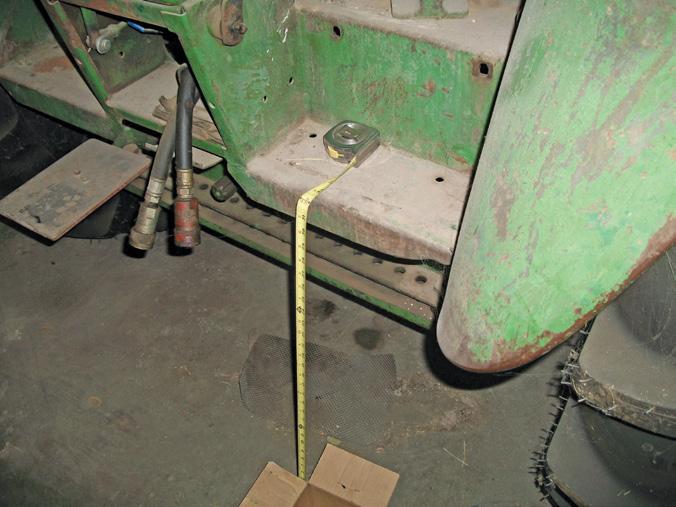
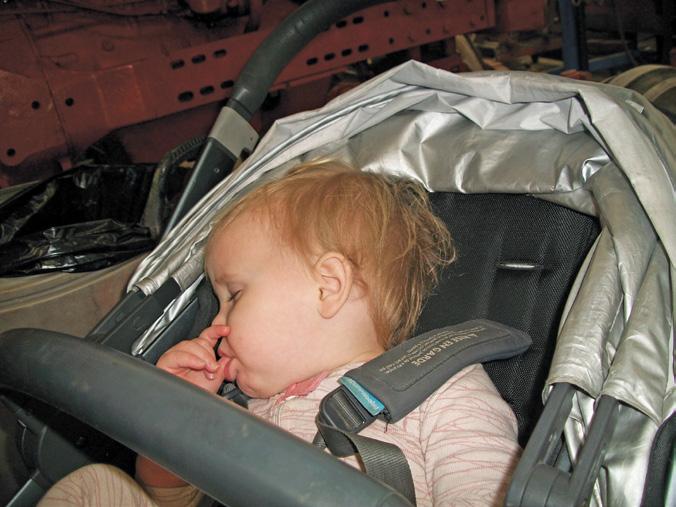
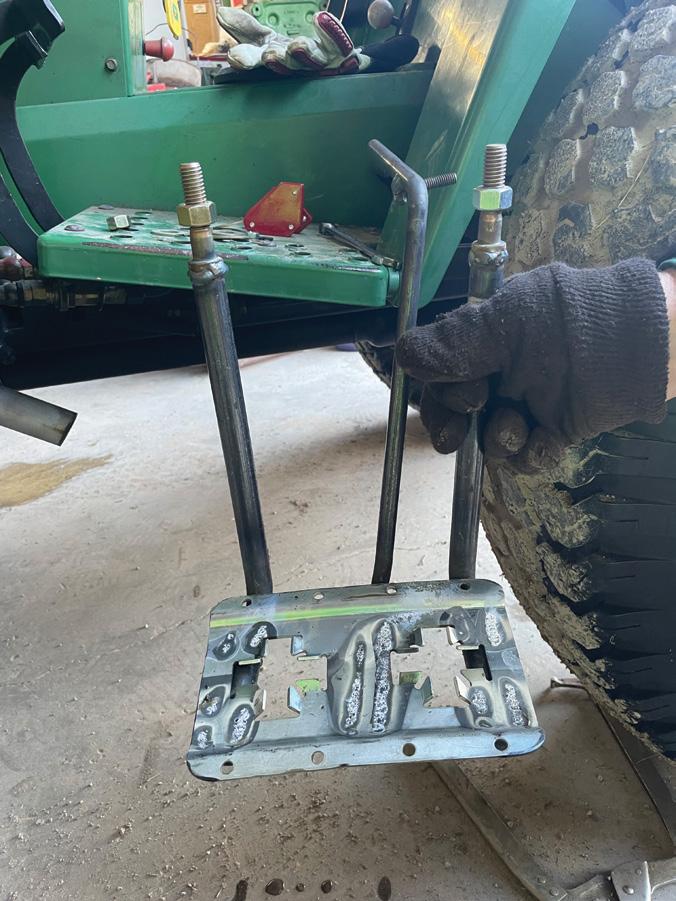
And finally, a JD 820 (Photo 6) with 34 inch rear tires at a step height of a whopping 33 inch step.
A short discussion followed and Dan stated that he is going to start building steps for old tractors so short people and older people like me, and even ladies, can get up onto their tractors safely AND gracefully. He stated that he would start with a prototype model for our 955. And with that, a need turned into an idea, and an idea turned into a tractor step. The very next time that I saw Dan, he came equipped with an arm full of metal and a head full of ideas. So while baby Thea took a nap (Photo 7), we put our heads together and welded up a step that looks like this (Photos 8 and 9). Its height from the ground is just slightly higher than the ground height of the front and rear axles.
The thought here is that if you are in the mud deeper than the axles, you are stuck anyway. As you can see, it is made of one inch cold rolled steel rod, and it uses the existing holes in the 955’s step (Photo 10) to mount to. Regarding the step “pad” (Photo 11), it has raised foot traction holes in the center that will allow mud and moisture to drain through, and allow no skin scraping or slipping, no matter what kind of shoes or boots you are wearing. The source for the metal is a




trade secret for now. I think that it all turned out very well for a prototype model.
But the real test is how do the ladies like it? Here is another of Dan’s daughters (Photo 12); her name is Truly. She stated that now even SHE can get on the tractor, and then next
Photo 9 • Photo 10, below
Photo 6 • Photo 7, below
Photo 4 • Photo 5, below
Photo 11 • Photo 12, below
Green Magazine® • April 2024 Page 57
Photo 8
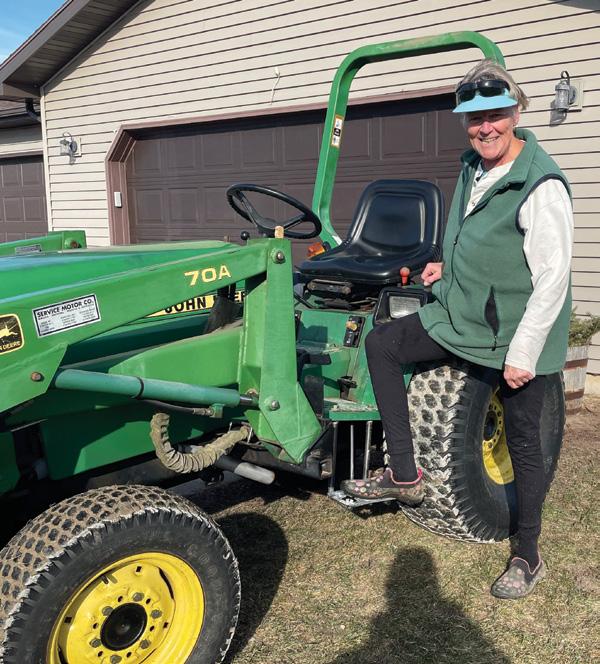

we have Jo Anne (Photo 13), smiling as she is stepping on it. You know what they say—“happy wife, happy life.” And last but not by any means least, here is the guy with the idea and the vision, Dan Pierson (Photo 14). One of his many famous quotes is “DREAM BIG.”
Is this a “one and done” project? I don’t think so. Dan has plans to modify the next step to make it more universal and easier to build. And then he wants to offer a variety of steps for tractors of all makes and models to meet the demand. These steps could be made quickly and in large quantities in his opinion. It has been a fun project to be involved with and I hope that the “dream” takes off for Dan. Oh, what’s that you say…where do you get one of these steps for YOUR tractor? Of course, you will have to let us know specifically what tractor (model and make) that you want to outfit with Dan’s step, and information such as how far is the step on that tractor from the ground and details such as that. Send an email with all of your contact information (email address, a good current phone number, your

name etc.) to this email address: 24steponit@gmail. com Contact Dan for more information.
As for me, I help where and when I can, but I must stay the course with my own business such as that 620 John Deere replacement cylinder block, so enough of the step-on discussion for now. Funny thing about tractor projects hanging around my shop—that is, they don’t fix themselves. The 620 block is rebored to .090 oversize but was not fitted to the new pistons and the cylinder bores. We find a clearance between the two at .005 (five thousandths). The recommended clearance is a minimum of .006 (six thousandths). I want to hit a number of .0065 (six and one-half thousandths). Is all of this concern over such a small number necessary? It will be, if the engine is all back together only to find that the piston was not “happy” in its new home when put back to work. Nothing is worse than “back-wrenching“ a new engine if something like this causes a failure. From piston clearance to checking every piston ring for end gaps, and then being sure that everything assembled as it should be, is the only way to go.
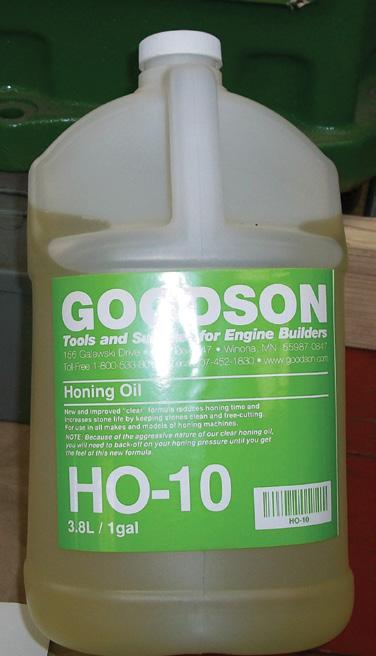
sired size, and then the 220 grit stones will finish it off and leave a cross-hatch on the cylinder wall, compatible for the rings to seal in to. Special honing oil (Photo 16) must be used very liberally as the honing procedure is done. This fluid allows the stones to cut as they should, and keeps them from clogging up with debris and not working properly.
Here then is our block, pistons, and all tools and measuring devices needed to get it done (Photo 17). Patience, persistence, and perfection is the only way to build a good engine. Next month (if nothing ELSE gets in my

As you can see in Photo 15, we will be opening up this block’s bore a bit using two sets of honing stones. The set in the hone is a 150 grit. When the desired bore size is opened to about 3/10’s from the desired size, the other set of stones will be installed. They are 220 grit. The reason for this is to quickly bring the bore out to just under the de-
way), there will be parts and pieces of this 620 to talk about. The cylinder head will be another item that must be dealt with so stay tuned for much more 620 discussion. I am also interested in measuring the old block and pistons to determine just how these old twocylinder Deeres will wear before they lose their efficiency as this one had. Times they are a’changing and many for reasons I do not understand. As for old Doc, I intend to stay the course.
Until we meet again, may God BLESS you and our precious United States of America.
This column is written by Ron and Jo Anne O’Neill.
Photo 17
Photo 15 • 16, right
Page 58 April 2024 • Green Magazine
Photo 13 • Photo 14, below
Dad, me and a John Deere “GP”
The year was 1947 and my dad is standing in front of the tractor and I, Ken Heipel, am sitting on the tractor pulling a twofurrow 12 inch Massey Harris plow. I was 11 years old, going on 12, and it was a hot, humid day in mid July. We were plowing the pasture field, which was 10 acres. We would summer fallow it until mid September and then plant wheat in it. In mid October, when the wheat was six inches tall, we would pasture cows in it if the ground was dry. Before we plowed the field, we would haul manure to the field with horses and a wagon. We would put the manure on little piles and then spread it by hand because we had no manure spreader. The day before we plowed the field, my dad would strike out all the lands.
At noon, we would take fuel to the field for the tractor. The tractor in the picture is my 1930 “GP crossover,” serial number 223797, which is the third to the last one built before the new 1931 models came out. These crossovers had a six inch bore, which gave them more power than the regular production 1930 models. There were 68 of these tractors pulled off the assembly line at random and many had other improvements. There were no two tractors built alike. Most of these tractors went to Steinbach, Manitoba. Two went to Wisconsin and one car load went to George White and Sons on London, Ontario. There are 10 or more of these tractors in the hands of collectors. Following is a partial list of them.

The day that the photo was taken, the tractor stopped dead in the field when I was plowing. My dad came over and drained the kerosene out of the carburetor, switched the three way valve to gas, and turned the flywheel but the tractor did not come to life. Later, after the milking chores were done, my dad harnessed the horses and we went out to pull the tractor home. It was all the big horses could pull and he had to rest them three times in 80 rods— which is a quarter mile. My dad called the John Deere dealer and they came out and put a Wico “C” magneto on the tractor. I was skeptical but it started on the second pull.
The tractor had no heat gauge or oil filter. For oil pressure, there was a rod that would come out of the main case behind the governor with a red tip on it. They called it the “red head” oil indicator.
This was our main tractor on 200 acres. It did mostly heavy work, cultivating, custom threshing, sawing wood, silo filling,


plowing and grinding feed. The tractor is all original except for the magneto. It has the same block and crankshaft. Right now it is sitting on planks in my shed. I think if I were to put gas in it, it would start on the second pull of the flywheel and thresh all day. My brother used it on his farm until 1988. When he had a farm sale, it was not sold, so I drove it home and put it in my barn. I eventually paid $650 for it, the same price my father paid for it new. It was the first John Deere tractor sold in Wellesly Township.
Submitted by, Ken Heipel
“GP” crossovers known to still exist 222348 222349 222357 222369 222378 222728 223295 223300 223770 223771 223772 223775 223796 223797 223798 223799 223801
Tractor owner Edward Heipel at the front with Ken Heipel on the seat in 1947. Below: Ken Heipel with the same tractor in 2006.
Green Magazine® • April 2024 Page 59

For Sale
520, fresh paint, good tires, starts and runs good, $4500. 50, 13.6x38 tires, fenders, new paint, $4000. 60, new paint, good tires, $4500. Ph. 616-836-5837. MI
1928 GP. GPO. GP Beaner. AOS. W-111 engine. Brass tag BO. Unstyled BN. M. MI. L (orange). LA. 40-U. 40-S. 420-S. 430-S. Ph. 269-461-3449. MI D3X

Rates: 50¢ per word, minimum charge $5 classifieds limited to 200 words ($100)
Photos: $40 per photo 2-1/4 inches wide or $20 per photo 1-1/4 inches wide
Discounts: 10% off for any ad running in three issues. No material changes allowed; payment must accompany ad
Classified & display ad info
•Green Magazine is mailed about the first of each month.
•Only John Deere items will be advertised.
•Positioning of ads is at publisher’s discretion.
•Green Magazine will not print any ads which it considers to be:
•offensive or proven to be dishonest;
•from competing publications or organizations
Phone 402-643-6269
Email: info@greenmagazine.com
Website: www.greenmagazine.com
Mailing address: Green Magazine, PO Box 95, Bee, NE 68314-0095
Parting out JD M-MT-40-420-430 and A-B50-60-70 tractors. Call us for new, used and reproduction/replacement 2 cylinder parts. John Shepard, 715-265-4988. WI
Moving, must sell, John Deere 1928 D, 1949 M, 1946 G, 1939 B. LA with no tag. Ph. 573-682-0134. MO
1959 John Deere 630, runs and operates well, good Firestone tires, very nice sheet metal. No 3-point hitch. All original condition. $3900. Ph. 641-228-6565. IA

display ad Rates
Full page: 7-1/4” x 9-1/2” ........... $800
Includes full color • Limit 800 words
Half page: 7-1/4” x 4-1/2” $450
Includes full color • Limit 400 words
Quarter page: 3-1/2” x 4-1/2” ... $250
Includes full color • Limit 200 words
Business card: 2” x 3-1/2” $125
Includes full color • Limit 100 words
2 column inch: 1/12th pg. $85
Includes full color • Limit 40 words
Bordered ads: per column inch .... $30
Full color, add $25 per photo
Limit 20 words per column inch
REMEMBER
If you move—call, write or e-mail Green Magazine with your new address FOUR WEEKS PRIOR to your move. If your magazine has an outdated address, the U.S. Postal Service may not deliver it to you. An outdated address also means we will not resend a missed issue to you free of charge.
Ph. 402-643-6269
PO Box 95, Bee, NE 68314
info@greenmagazine.com
140 garden tractor with mower and tiller. All in good condition. 1948 and 1949 A’s to sell for parts or make one good tractor out of both. One single front and other Roll-O-Matic. Ph. 208-313-3020. ID
2520 John Deere, 1970, SN 20052, gas Syncro, 6800 hours. Front and rear weights. Looks good. $10,800. Ph. 303-472-8120. Central KS
1955 JD 40 crawler, located in Leesburg Florida, photos available, needs work, $3500. Ph. 407-949-4698.
Payment
• All ads are to be paid in advance. Ads sent without payment and needing to be billed will be assessed a $4.00 service charge.
• Classified ads will be taken over the phone, if accompanied by a credit card payment. We are not responsible for errors in ads taken over the phone or for illegible ads received in mail. Display ads will not be taken over the phone.
• We do not send checking copies or tearsheets. Send $6.00 extra for a copy of the issue in which your ad appears.
Discounts
1) 10% discount - for any ad running in three consecutive issues. No material changes allowed. Payment for entire ad run should accompany ad.
2) 5% discount for camera ready - ad must be typeset, clear and at the proper size.
3) 5% cash discount - payment in full by check, without being billed.
Word limits
When preparing display ads, please take note of the word limits. We can place only so many words into a given area and still make a readable ad. If ads exceed word limits, advertiser will be billed for extra space.
Page 60 April 2024 • Green Magazine
Restoration Services, in association with Paul’s Paint & Glass Supply of Seguin, Texas, will do:
Restoration Services
Quality restoration, fine refurbishment & excellent body & paint work
We can also repair individual components on all two cylinder and New Generation Deeres
2495 Hwy. 46 North • Seguin, TX 78155 Ph. 800-933-6380
830-372-2195 • 830-401-1365 cell paulspaint78155@yahoo.com www.restorationservicestexas.com



Paul's Rod & Bearing
Specializing in JD babbitt bearings
Let us repour your rod & mains for models A, B, D, G, H, L & LA Ph. 816-587-4747
Since 1952
6212 N.W. Bell Road Parkville, MO 64152
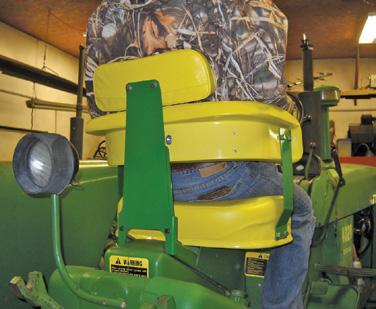
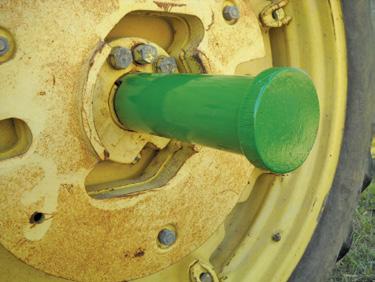
New Generation seat extended brackets, 4 inches longer than stock, not painted, 4 piece set, $120.
ALSO: Axle wedge removal tool, 530-4620, three sizes, $260 each. Brett, 402429-5311. NE C3X

JD 140 garden tractor, 48” mower deck, runs good and everything operates as it should. Straight sheet metal, paint good, always shedded. $1150 OBO. Ph. 573-881-7437. MO
been professionally painted. Has new rear tires and new batteries. Selling because of my health. Price is firm. $20,000. Ph. 740-501-6085. OH
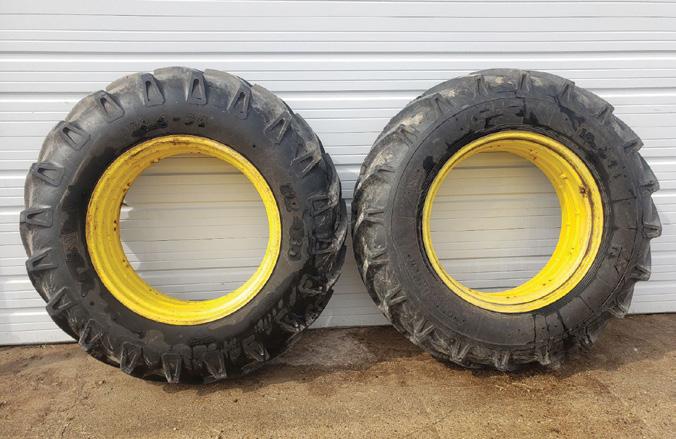
530, runs great, fresh paint, and decals, $8500. Ph. 616-836-5837. MI

Recovering original tractor steering wheels for 14, 15 and 17” three spoke flat or round wheels, $95; 19” four spoke wheels, $110. Please send your core or call for information. EverGreen Restoration, W7619 Walnut Dr., Spooner, WI 54801. Ph. 715-520-7876. Made in USA. WI C3X

1010 orchard. 1020 orchard. 1020 vineyard. 2020 vineyard. 1020-V w/sidewalk snowplow. 2030 orchard. 2255 orchard. 2240 orchard. 3010 utility. 300 turf. 301 turf. 401-C Pipeliner. 4230 open station. Ph. 269-461-3449. MI D3X
Two 18.4x34 tires on original JD rims, off of a 4020. Great condition, tread 95%, $2000 for the pair. Also one 12.4x36 Goodyear, 75%, $300. Ph. 920-829-6301. WI
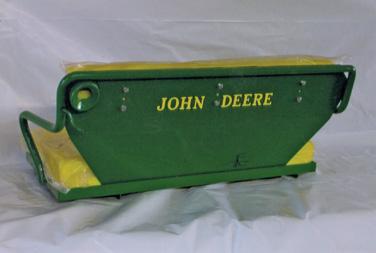
Buddy seat! For 20 and 30 series two cylinders. Will fit float ride seat or bat box. Looks like the original buddy seat! $475 plus S/H, includes cushions. Ph. 260-901-3076. Callaway Restorations, IN. K6X
Used John Deere two-cylinder tractor parts. Wide variety. Also, some New Generation parts. 30 years’ experience. Call or text Darwin Gingerich, 620-386-0071. KS
PAUL’S ROD & BEARING
JD 530, fully restored, fully loaded, 3500 hrs., $16,000. Ph. 612-704-6683. MN
Late model John Deere 4020, strong running tractor. SN T213R259327R. This tractor has
Green Magazine® • April 2024 Page 61
L, LA, LI and Unstyled L Parts
SOME NEW AND USED
New parts include battery box, seat, metal belly pans, light brackets and more
The Ridenours Trenton, OH
Ph. 513-988-0390
Visit our website: www.antiquejohndeere.com

and paint. $2850. Call 330-806-0145. OH
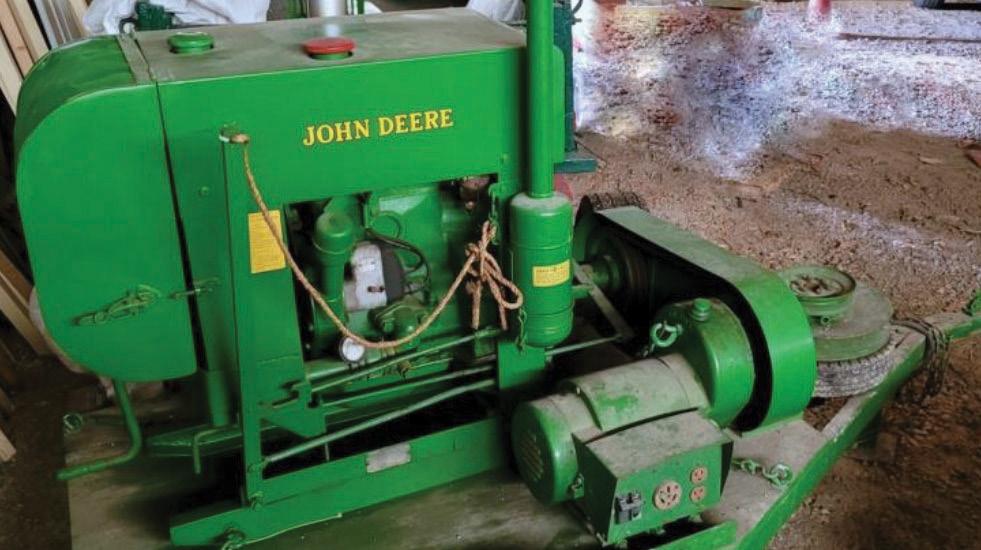
JD power unit, LUC, SN C52240, 19K generator, trailer, $380, unit restored by FFA class. JD 110, 1966 lawn mower, $500 OBO. JD 112H, 1966 lawn mower, $600 OBO. Ph. 217-762-2422 lv. mess., Monticello, IL.
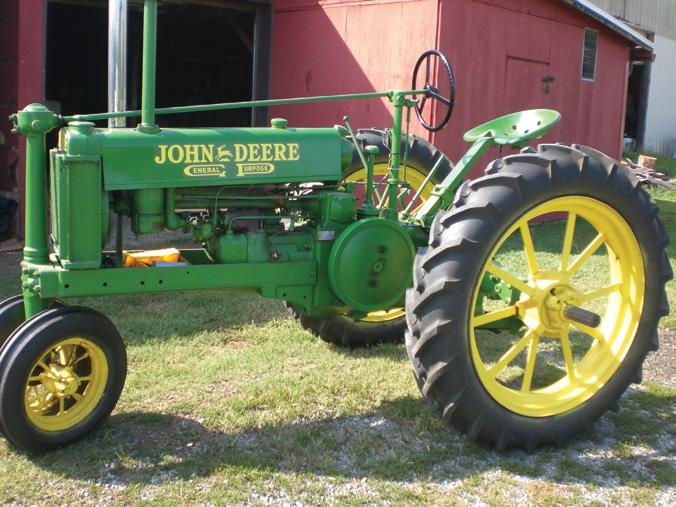

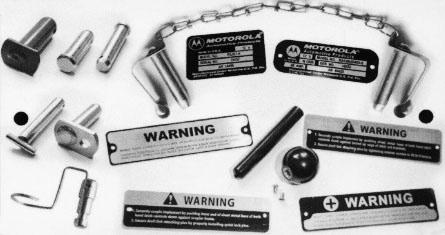
New Generation fuel gauges for 10 and early 20 series tractors, negative or positive ground, comes with new fuel tank sending unit, $160 for set. All our New Generation gauges fit in dash without modifications to the clamp bracket. Also have temperature and pressure gauges for same tractors. EverGreen Restoration, 715-520-7876; www. evergreengauges.com. WI C3X
Reproduced aluminum WARNING PLATES for 3-pt. Quick Hitches. Motorola alternator and amp regulator plates, 35-55-72 amp. Hydraulic cylinder stop pins with chains, spring steel clip, like original, three sizes – 3/8,” 7/16” and ½.” Ph. 712660-8447 cell. IA B3X

Dad has several John Deeres he is selling: JD 4620, 4020 PS, 4020 LP, 4020 Hi-Crop, 3020 wheatland (?), 420, 40 Hi-Crop, 40V, three ARs, LA, 4430 Hi-Crop parts (transmission, engine, etc), many more partial tractors. I am your contact, Jeff, phone 320-293-5038. Tractors are in LA, call for pictures and condition.

Fender grommets – part #R44619 and #R44621, left and right side for JD 4520, 4620, 5020, 6030 with roll bar and fenders. $149.95 per set plus freight. Ph. 712-252-0423. IA C3X
1955 JD 70 row crop diesel, SN 7023318, pony motor, power steering, good tires, 801 3-pt. hitch, second owner, used regularly, always shedded, runs good, $5500. Ph. 440-538-9456. OH
1946 B, electric start, new seat and battery, $2500. 1949 B, repainted, runs good, $3500. 1936 B, unstyled, fenders, spoke wheels, $3500. Ph. 616-836-5837. MI
ADVERTISING DEADLINES for upcoming issues of Green Magazine® May 2024 issue: April 1, 2024 - display ads due April 5, 2024 - classified ads due June 2024 issue: May 1, 2024 - display ads due May 5, 2024 - classified ads due FOR MORE INFO: See page 60 of this issue Call 402-643-6269 Email: info@greenmagazine.com John Reed Antique Tractor Parts John Reed antique J tRaCtoR paRts Phone 580-651-5646 • 806-733-5646 14475 FM 1262 • Gruver, TX 79040 johnreedtractorparts@yahoo.com www.johnreedtractorparts.com www. parts4tractors.com Pistons, radiators, magnetos & manifolds “H” GOV BEARINGS Fits H, R, 80, 820/830: $35.00 plus S/H SHEET METAL BOLT SETS Early styled tractors (pan seated models) A, B hand start • A, B long hood • G, GM & H $35.00 plus S/H RADIATOR BOLT SETS Unstyled tractors: $45.00 Styled A, B, G and H + 50, 60 & 70: $40.00 520-up: $30.00 • plus S/H We specialize in JD model H tractor parts— new, used and reproduction THOUSANDS of model H parts! Ridenours - L parts John Deere
John Deere B, one remote, like new 38” tires, excellent sheet metal
1936 unstyled B, great shape, show ready. $5000 OBO. Ph. 434-470-8644. VA
1966 3020 PS, DSL, 3348 original hrs, top link, restored, new tires, SN 92603. $20,000. Ph. 330-464-3680. OH
Page 62 April 2024 • Green Magazine
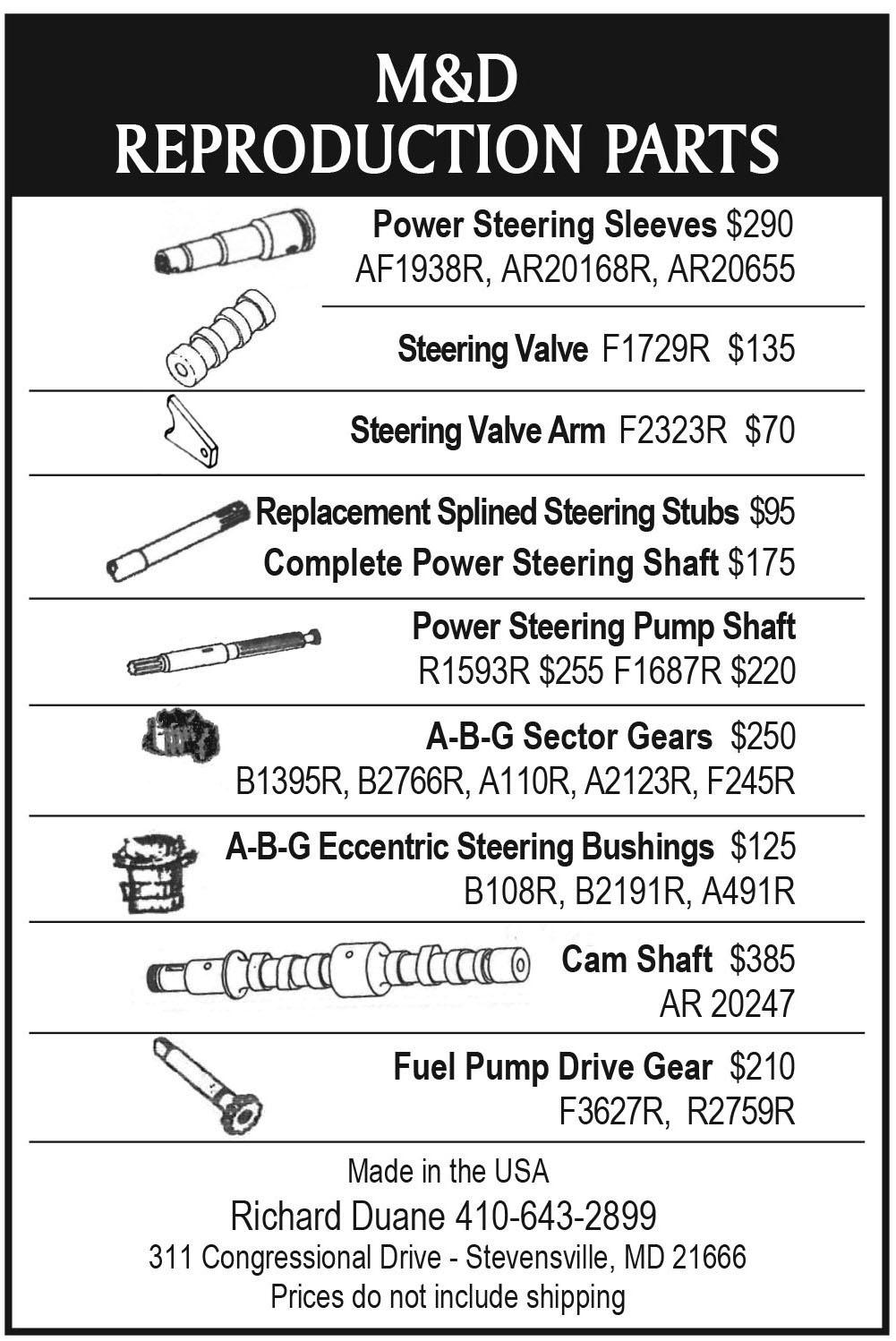

D3X
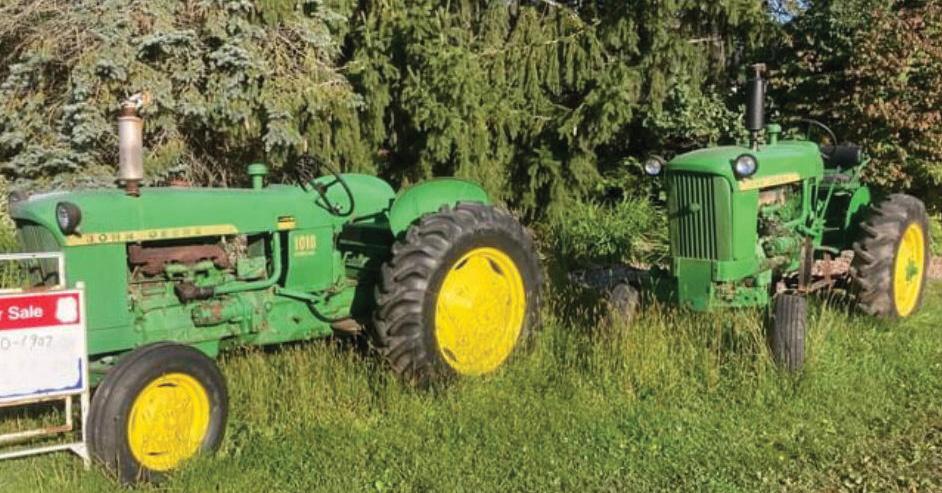
Two Cylinder Diesel Fuel Systems - Stock & Modified
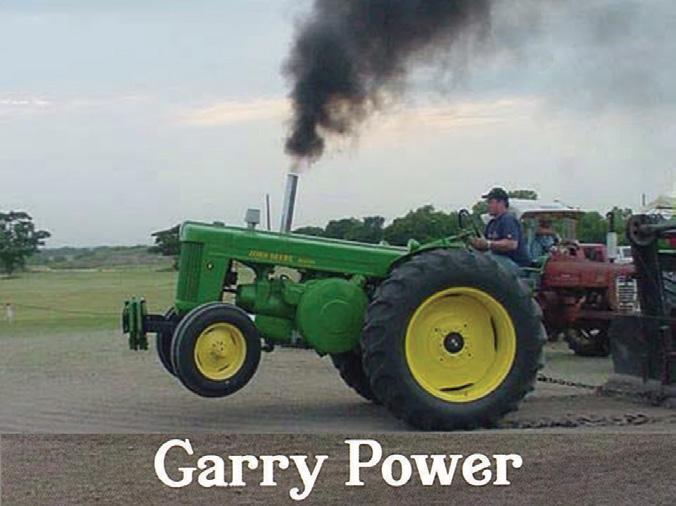
•
730 electric and 720 pony start diesels, WF and 3-pt., excellent tin and tires, $10,000 OBO for either. 720 gas wheatland, 3-pt. and dual hyd, excellent, $8000 OBO. Ph. 715-676-2220 evenings. WI
1965 JD 3020 gas standard, one of 160, all new tires, 5785 hours, front and rear weights, photo GM January 2024. Ph. 419825-3333. OH
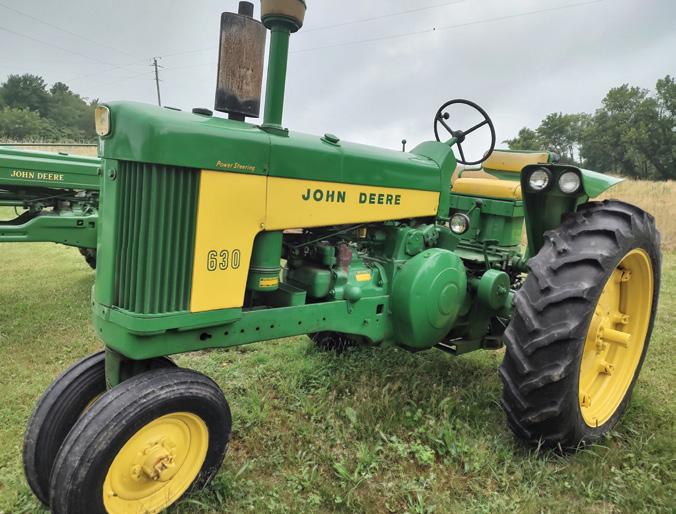
OH
LGT tractors: early 110; 112; 400; 430 diesel. 120/140 front 540 PTO. 316/318 front 540 PTO. 120/140 front wheel weights. 400 rear wheel weights. 430-D front blade extension bracket. Ph. Ph. 269-461-3449. MI D3X
Large inventory of good used two cylinder parts. Call for parts needed - casting numbers and/or parts numbers appreciated when you call. Detwiler Tractor Parts, Spencer, WI. Ph. 715-659-4174 or 715-6594252 weekdays 9-5. C6X
Lots of model D and R parts - call for a good deal. Ph. 785-821-2600. KS C3X
SERVICE INSTRUCTION CARDS. Reproduced sets of 3 for 3010 RC and RC utility; 4010 RC and standard. $35 postpaid. Green Iron Farms, 1320 Hwy. 92, Keota, IA 52248. Ph. 319-560-9508, tesieren@gmail.com. B6X-ALT


1936 JD B, complete motor job, carb rebuilt, and all new rubber, $6000. Ph. 607-3697656. NY
1941 AR, electric start, completely restored. Ph. 636-296-3112. MO C3X
1965 JD 110 lawn tractor, with 38” mower, 42” front blade, 80 dump cart, two M11029 slab weights, original wheel weights, complete restoration, asking $3850. Ph. 419-825-3333. OH
Parting out: Unstyled L, L, LA, LI, M, GP, GPO, GPWT, AOS, BO Lindeman, BO/ BR, AO/AR, 40-U, 420-U, 330-S, 430-U, 60 orchard, 1010, 2010, 1020 orchard, 2020, 3020 utility. Ph. 269-461-3449. MI D3X
Dillner's Tractors Excellent reproduction TOOL BOXES ALSO: New Generation tool boxes • GP, D & LA brake linings • Carburetor rebuilding • H773R dust shields • Clutch brake pads • Governor springs BOB DILLNER 973 Corley Rd. • Manns Choice, PA 15550 814-733-4397 www.dillnerstractors.com CALL or see website for more info A thru 730D
Transfer Pump Gears •• Also: Bosch 14mm Barrels & Plungers
••
Bendix 13.5mm Barrels & Plungers • Bosch & Bendix Injector Tips • New with Increased Flow • Injector Springs • Needle & Guides • Many Obsolete Parts 970-554-2108 hendrichfarmtractors.com
1950 D, runs as good as it looks, $14,000 OBO. Ph. 704-600-8101. TN
John Deere 1010 RUS and a John Deere 1010 S for sale. Both tractors run and drive well. $5200 each OBO. Ph. 616-520-1907. MI
John Deere 630, row crop, 3-pt., LPTO, remote, flat fenders, air stack, PS, cushion ride seat, show condition. Call 330-8060145.
1958 JD 420T, wide front, liquid propane, runs, SN 126704, with implements, $7500. Ph. 575-535-2480. NM
Green Magazine® • April 2024 Page 63
• Two Cylinder diesels—our speCialTy
• CompleTe Two Cylinder diesel
• Fuel injeCTion repair and CalibraTion
• Cylinder bloCk boring up To 8”


We also have good sources for aftermarket products for two cylinder John Deeres including Taper-Lock flywheels, engine parts, grilles, battery boxes, manifolds, mufflers, pony motor ignition parts, etc.
• 2 cyl. & later JD air cleaner conversions, Lindeman through 430C trunion bushings
• 70-830 diesel piston kits in stock, STD, .045, .090, .125 os
Renaissance Tractor
120
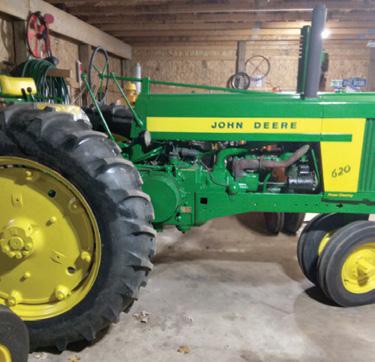
620 repainted, with 3-pt., starts and runs great, like new tires. Ph. 616-836-5837. MI
L-4100T motor. Depression D air cleaner. AI/BI/DI seat. AI front end casting. K-W, Remy and gas lighting parts. GPO air cleaner. GP Beaner front axle. Big bore GP gas tank. 1010/2010 side panels. 2020 grove hood and PTO shield. New Gen orchard manifolds and exhaust pipes. Ph. 269-461-3449. MI D3X

2010 JD X740 diesel garden tractor, with 62” mower, 47” snow thrower (used twice), 54” front blade, very rare 60” center mount blade, chains and wheel weights. Ph. 419825-3333. OH

Fuel gauges for John Deere 2 cylinders with original face. Six or 12 volt positive and negative ground comes with new fuel tank sending unit. $135 for the set. See our ¼ page display ad for other gauges. EverGreen Restoration, 715-520-7876; www. evergreengauges.com WI A3X
Yellow zinc wheel bolts for Waterloo or Dubuque 1/2” NF and 9/16” NF. Square head also for cast wheels. Ph. 217-5024504. G6X
Canopies for JD 3020, 4020, etc. Powder coated yellow. $1135. Quantity discounts. Ships truck freight. Nelson Horning, 585526-6705. NY C12X
1956 John Deere 320S. Completely restored. Have cultivator, not restored. Way too much to list. Call for details. $12,500. Ph. 716-735-3848. NY D3X
We have parts for your 45 combine! www.45combineparts.com. Ph. 417-2592520. MO A6X
ELECTRIC STARTER KIT for R, includes 12 volt starter, bracket with battery box, breather, water manifold, water pipe. Alternator with top and bottom brackets, mounting hardware and battery cables. $1595. Free shipping. Ph. 717-445-9465. PA D3X
New and used parts for JD two cylinder tractors and crawlers and some NOS parts. Models A, B, D, G, H, LA, M, 40, 50, 60, 70, 70D, 440, 520, 620, 720D, 530, 630, 730, etc. A&L Parts, 315-536-0543. NY C12X
WIRING HARNESSES,
battery cables and spark plug wires made to order for restoration or repair. Covering models from the 1930s to the 1980s. Electrical parts including: switches, regulators, lights, relays, alternators. Wiring harness repair/ rebuild service. Worldwide shipping. See our display ad in this issue. Call or email for a free catalog. Agri-Services, 13899 North Road, Alden, NY 14004. Ph. Website: www. wiringharnesses.com. Email: agriserv@ rochester.rr.com. D3X
Gear reduction starter built for 3010 JD through xx60 series. Adaptable to some 8000 series JD tractors and some JD loaders. Starts easier. About $100 cheaper than OEM. No core charge. Call 218-234-6500. NE C3X
Automatic release brake locks for two cylinders. Haben 4’ sickle mower for 140 garden tractor. Parts: 420W, 50 and 630 RC; 520-630 LP and A-730: air stacks, 3-points. Hose and breakaway kits for dual hydraulics 520-730; split pedestals for A and B: also Behlen overdrives, round spokes and lugs. 800/801 hitches and parts. Aftermarket parts. Rollover plows and plow parts: 820, 825. Marlin Smith, Pine Valley Farm Equipment. Ph. 712-579-9922. IA C3X
Dubuque parts: Top links, utility anchor yoke assembly, M3434T steering arm, Float Ride seat; PTO shafts, orchard manifolds, PTO belt pulleys, sway bars and brackets, PTO shields, 40-W drawbar, 330/430 standard drawbars. AO/60/620 orchard sheet metal support bracket. Ph. 269-4613449. MI D3X
John Deere tractor repairs and restorations – all two cylinders and New Generation tractors. Pickup and delivery available. 4177 White Oak Road, Paradise, PA 17562. Ph. 717-687-3761. B3X
1965 3020 diesel, Power Shift, wide front, dual hydraulics and PTO, 7046 hours. Recent engine overhaul. New rims, new paint, lots of new parts, $18,500 or best offer. Ph. 641-228-8046. IA C3X
Wheels: A-1106-R cast 24”, L/LA deep-dish fronts, styled L rears, 9.5x24” 1010 turf duals, GP round spokes, GPO front steel, GP lister fronts, GPWT rear spokes, BO/BR front spokes, BO/BR rear steel extensions, BO/AO 24” rims, D/DI front spokes. Ph. 269-461-3449. MI D3X
Dubuque tractor HOOD BOLTS: Airlock 160 threaded hood bolts, looks like original Airlock ¼ turn fastener. Has same face, but allows you to snug up metal without harming paint. Set includes 11 Airlock bolts, unuts and nylon washers. For all M, 420 and 430 series. $60. Battery box winged Airlock bolt also now available, $15. Both for $70, includes shipping. Ph. 217-502-4504. IL L6X
360-748-0026
Cabe Road • Chehalis, WA 98532 800-784-0026 •
Page 64 April 2024 • Green Magazine
New, used & reproduction
Crawler parts: Lavoy Wilcox
JD CRAWLER PARTS
Steering clutch parts, brake bands, bearings, final drive gears, engine kits, carb kits, radiators, fans, water pumps, battery sheet metal, seat cushions, gauges, light switches and more www.jdcrawlers.com
Lavoy Wilcox • Horace, ND
Phone 701-361-1006 • 8-5 CST No Sunday Calls
PARTS AND DECKS for older Deeres. 110, 140, 200s, 300s, 400s and over 150 lawn tractors for sale. Ph. 219-942-2242, website: tractorsalesandparts.com. IN B6X
Parting out 1953 John Deere 70 gas. Ph. 402-485-2887. NE C3X
Carr’s Repair: We’ve got you covered! D and R overbore piston kits for sale - D overbore .125-.250, R overbore .045-.125, SPECIAL $595! 720-830 JD diesel .125 overbore piston kits. Restore those JD tractors to original! Ph. 807-487-2548. International Falls, MN. No Sunday calls. Website: www. carrsrepairvintageparts.com (A12X)
Carburetor, water pump, distributor rebuilding. Farmers Service Incorporated. Ph. 330-482-4180, www.farmersserviceinc. com OH L6X
Weights: suitcase, BO/AO front spoke wheel weights, L/LA, M/MT, M-1168-T, 320/330 fronts, 420W/430W front, 40/420/430 S/U rear spinout weights, 1010 front, 1020/2020 fronts, 1530/2440 suitcase bracket. Ph. 269-461-3449. MI D3X
Electric starter kit for 70/720/730. Includes 12 volt starter, bracket, alternator and brackets, engine cover, breather standpipe, plug and caps for water ports, $1250. Kit for 80/820/830, $1350. Battery box now available. Free shipping. Also battery cable kit now available. Ph. 717-445-9465. PA D3X
60” drive over deck for a 3520 w/mounting brackets. JD 140 w/3 valves, 3-pt. hitch, 42” deck, snow blower, hard cab, tiller w/ two extensions, sickle mower, front PTO, bottom blade. Ph. 904-755-1763. WI C3X
Berry Cam Service: For your 2, 4 and 6 cylinder camshafts, stock or antique pullers. Ph. 320-395-2377. Location: 1948 175th Street, Lester Prairie, MN 55354. D6X

New and used JD two cylinder parts. Specializing in H, M, MT, 40, 420, 430, GP, 800 and 801 3-points and parts. Also: See my eBay store for specials and NOS parts. Some NOS parts, many reproduction parts. Dave Cook Tractor Parts, 715-373-2092. Morning calls are BEST. WI B3X
Many rebuilt machine and tested mags and carbs for two cylinder JD tractors and for other makes as well. Also have parts for old Splitdorf mags. Over 30 years’ experience. Call EZ Tractor Shop, ask for Eldon, 785-332-5482. KS C3X
Implements: Plows - model 835 rollover, F-45 3-pt, 2x16”, #51, #411, #412, #415. Disks - KBL, KBA, RWA, model E, #31 offset, model Y. 246-247 planter. F-1150 harrow. Boom crane. Hi-Crop lister. #20 scoop. TP-16 subsoiler. #22 subsoiler. #80 blade. TP-26 forklift. #12/ #14 rotary hoe. 3-pt toolbar rippers. 953 wagon. HD-2240 harrow. Ph. 269-461-3449. MI D3X
1950 model A John Deere, runs, with 45 loader, hydraulic pump on governor, chains on rear tires. Ph. 507-447-2237. MN B3X
Scott’s Tractor Restoration, 14025 Haumesser Road, Shabbona, IL 60550. We offer complete restoration and mechanical repair on all makes and models of tractors. Showroom quality. Ph. 815-762-0851, website: www.scottstractorrestoration.com or email: twocylindersh@aol.com. A12X
THREE PIECE FRONT WEIGHTS for JD 520-730. Good reproduction. U.S. made. $1000. Also numbers 4, 5 and 6 are available, $350 each. Detwiler Tractor Parts, Spencer, WI. Call 715-659-4174, 715-6594252 or 715-659-4525 (office) 9-5 M-F. H6X
Mounted implements: H-3 two-way plow; L/LA planter; L/LA belt pulley; L/LA plow; LA-113 harrow; M-10 cultivator; M-111 planter w/ fertilizer attachment; M/ MT disc; M/MT plow; M-404 offset disc hanger; M disc hanger. Triumph wagon. Horse drawn buggy. Ph. 269-461-3449. MI D3X
Fresh in for parts—820, unstyled B, M, 70, 80, 420, 3010 utility. Also parting out styled and unstyled A, AR, B, D, H, R, 40, 50, 60, 720 gas and diesel, 840, 1010, 2010, 3010, 4010, 3020, 4020, 1530 and 2030. Countryside Tractor, 618-731-6625. IL B3X
We have clutch covers, grill screens, manifolds, battery boxes, water pumps, steering wheels and more, plus a yard full of used 2 cylinder parts tractors. Over 25 years of experience. We also have battery boxes, grills, steering wheels and other parts for New Generation tractors. Call Shepard’s Tractor Parts, 715-265-4988. WI
Hoods, grills: Styled L, LA, 40, 420, 430, 435-D, 650 compact, 4100 compact, 1010, 2010, 1020 orchard, 2020 grove, 1530, 2030, 2640 orchard, 2940, 2150, 2350, 2950, and others. Ph. 269-461-3449. MI D3X
Green Magazine® • April 2024 Page 65
NEW manufactured parts for John Deere L, LI and LA. Forty-two years of experience making these parts! Grilles, bases, propeller shaft guards and shield assemblies. Ron Brungart, cell 570-660-4573. PA D3X
New and used John Deere small square baler parts. Knotter rebuilding service. Our free catalog makes it easy to figure out what your baler needs. Call Finger Lakes Equipment, 585-526-6705. NY C12X
Carburetors: DLTX-5, DLTX-10, DLTX-18, DLTX-46, DLTX-51, DLTX-53, TCX-12 replacement, TSX-13, TSX-60, TSX-245, TSC514, TSC-530, TSX-641, TSX-688, Ensign BJ, GP water valve. Ph. 269-461-3449. MI D3X
Parting out 3010D, 70D and 620. Ph. 641228-4282. IA I12X
High-speed road gears for John Deere tractors A, B, D, H, 50, 60, 620, 630, 730 models for tractor rides. Ph. 701-942-3102. ND C3X
1950 styled AR, many unstyled G parts. 70 diesel just fresh in! Parting out: 70 gas burner, 630, good tin; styled G, also H. Parts for unstyled A, B, GP, D. Styled A, B, D, G, 50, 60, 520 and 620. Some R parts. Can deliver JD parts to LeSueur, Minnesota. Call Larry Frederick, 308-5207416. NE J6X
Pedal tractors: small 60, large 60, 130 restored, dealer pedal car, LGT, three hole 10, 4020 (D-63), early 4430. 1977 Liquifire 340 snowmobile. Koiritz 440 L/C motor. Various snowmobile hoods. Ph. 269-4613449. MI D3X
Toys, Books, Manuals & Videos
Dealer signs. Men's green bicycle. Arcade and Ertl toys. Operation, Care and Repair farm machinery books. Sales literature. Memorabilia. Ph. 269-461-3449. MI D3X
TRACTOR MANUALS AND LITERA
TURE, large selection, ag, industrial, L&G. Jim Robinett, 5141 Kimball Road, Ontario, OR 97914. Ph. 206-713-3441, send email: tractrmnul@aol.com. OR C12X
It’s easy to place an ad in Green Magazine. For more information, see page 60 of this issue or call Green Magazine at 402-6436269 from 8:30 to 4 p.m. weekdays.




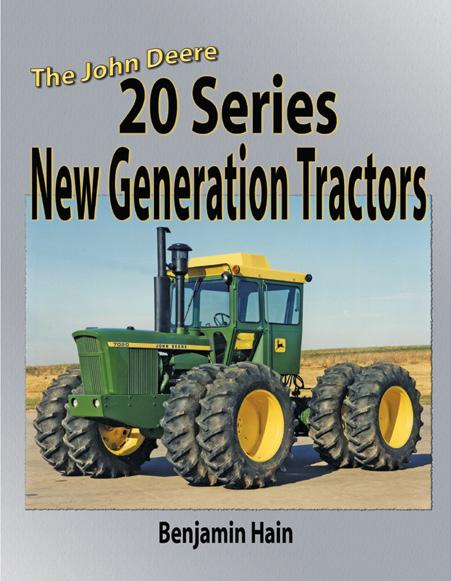

The John Deere 20 Series New Generation Tractors The John Deere 20 Series New Generation Tractors By Benjamin Hain This book is 128 pages packed with information on the John Deere models 820, 1020, 1520, 2020, 2520, 3020, 4000, 4020, 4320, 4520, 4620, 5020, 6030, 7020, 7520, 8020, WA-14 and WA-17 Includes history and development, specifications, production numbers and horsepower ratings. All the features you’ve come to expect in Green Magazine publications, giving the complete story of Deere’s finest line of tractors. 128 pages, 11x8-1/2 inches, soft cover • Prices includes postage Order NG20 : $28.00 U.S. • $35.00 Canada & Foreign Call 402-643-6269 • Email info@greenmagazine.com Online www.GreenMagazine.com Mail: Green Magazine • PO Box 95, Bee, NE 68314-0095 Visa, Mastercard, Discover, Am Express accepted • Nebraska residents, add 5.5% sales tax • U.S. funds only REMEMBER: Display ads are due the 1st of the month Classified ads are due the 5th of the month Page 66 April 2024 • Green Magazine

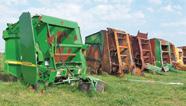



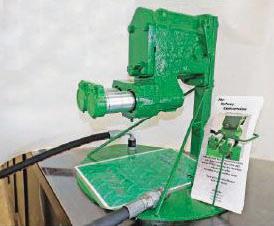


Have a question? Mr. Thinker has an answer. Green Magazine PO Box 95 Bee, NE 68314-0095 info@greenmagazine.com Send in your question today. $315 DELUXE CONVERSION KIT NO MORE DRIPS! • An easy leak-free ISO conversion kit for John Deere tractors from 1964-1982 • Push-pull design eliminates levers • Breakaway action includes all seals and dust covers Remanufactured stepper motor Fits models: 6000 SRS tractors ‘00, ‘05, ‘10, ‘15 & ‘20 SRS OEM part #AL181805 $450.00 exchange $200.00 core value Ph. 315-536-3737 GreenLight Products LLC Rebuilt in our facility 2-Cylinder Plus Tractor Salvage 2-Cylinder Plus Tractor Salvage A’s, Bs, 420s, 430 thru 4010, Hs & Ms Hay Equipment, Balers, Disk Binders & Hay Bines David and Robin Marlin 417-589-2634 • 417-589-3337 322 Marlin Prairie Dr • Conway, MO 65632 Only 70 miles northeast of Branson, Missouri Obsolete parts - The Old Tractor Company OBSOLETE PARTS CHECK YOUR PART NUMBERS against one of the largest inventories of obsolete and reproduction John Deere parts in the world www.theoldtractorcompany.com The Old Tractor Company • Box 89 • Franktown, CO 80116 TEXT: 303-594-3074 (texting preferred) Ph. 231-846-8243 Green Magazine® • April 2024 Page 67
Wanted & Announcements
Wanted: Looking for a 1971 JD 4000 diesel tractor, SN 257293. Syncro-Range transmission, wide front, no diff lock, was on 16.9x38” tires. Did have a Trojan seed corn emblem on front side panels. All help is appreciated. Last seen in Bowling Green, MO, heading for Illinois in the mid ‘80s or so. Ph. 573-881-7437. MO
Wanted: Mounting brackets for JD 158 loader to fit a 20 or 30 series tractor, any condition is fine. Ph. 417-938-4685. MO
Wanted: Looking for an above average condition JD 210 LE (1997-2007). Prefer model year 2004-2007, Power Shift transmission and clamshell bucket with verifiable engine hours below 5000. Email: TimothyCLong@ mac.com Ph. 716-652-3646. NY

Wanted: NEED YOUR HELP looking for a JD 630, SN 6317349, was in my family for 4 generations. I want it back to give to my son. Should be easy to identify if it hasn’t been repainted, the 6-3-0 on the hood were installed vertically instead of horizontally. Refer to the picture. Last known in Missouri, possibly Rolla. Thank you, bless you for any help. Ph. 615-543-0088. TN
Wanted: Two row corn head for John Deere 55 round back combine. Ph. 701-824-4210. ND D2X
Wanted: Hercules four-cylinder engine or parts model OOB used on John Deere No. 5 combine. Ph. 308-380-0500. NE C3X
Wanted: John Deere ground-driven corn picker in any condition. Email CornPickerBob at mrcornpicker@aol.com or text CornPickerBob at 815-761-3709. IL B3X
Wanted: Gas tank for a 1929 GP, gas tank for a 1928 model D, must be in good condition. Ph. 608-963-8251. WI C2X
Wanted: Rope start attachment for a John Deere R pony motor. Ph. 309-256-1100. IL K6X
Wanted: Looking for a John Deere 5020 row crop in good condition. Ph. 712-8304296. IA C2X
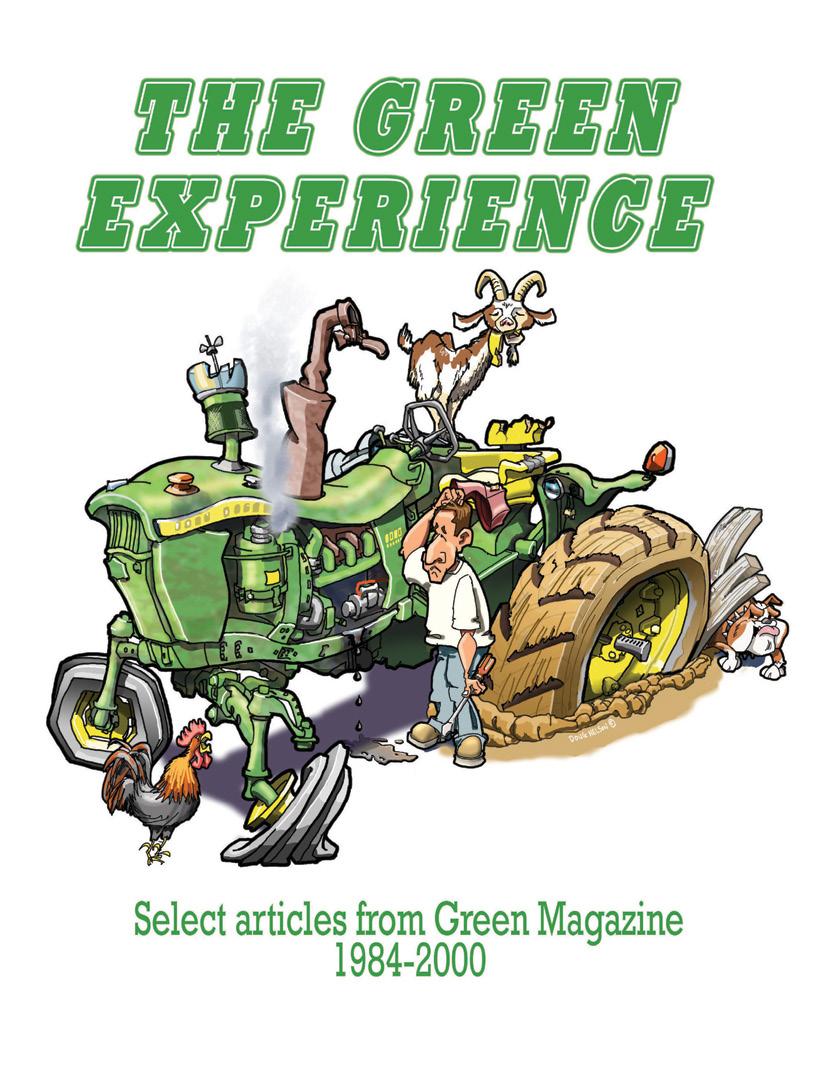





Visa, Mastercard, Discover, Am Express accepted Nebraska residents, add 5.5% sales tax U.S. funds only Approximately 96 pages of the best articles taken from Green Magazine’s first 15 years. Every member of the family will enjoy this book of restorations gone awry, trips that didn’t go as planned, cherished memories and sometimes profound situations. Not a technical or historical book, but a book about the lives and experiences of those who enjoy John Deere tractors. A GREAT gift idea! Place your order today! • Approximately 96 pages • 11x8-1/2 inches • Soft cover • Prices includes postage Order GREX $20 U.S. • $30 Canada • $40 Foreign 402-643-6269 • info@greenmagazine.com www.greenmagazine.com Green Magazine • PO Box 95, Bee, NE 68314-0095 We welcome your letters, photos and stories! For more information, call 402-643-6269 or email info@greenmagazine.com Page 68 April 2024 • Green Magazine

APRIL 2024 Green Magazine DISPLAY ADVERTISER INDEX
2-Cylinder Plus Tractor Salvage, 67
Agri-Services, 23
A&L Parts, 7
Auction: Bill & Sharon DeVries, 7
Auction: Dale Snieder Estate, 7
Auction: John Kleyn Estate, 7
Book: The Green Experience, 68
Book: The John Deere 20 Series
New Generation Tractors, 66
Book bundle deal, 2 Brillman Company, 69
Burrey Carburetor Repair, 22
Central Fuel Injection Service, 22
Countryside Tractor, 36
Crawler parts: Lavoy Wilcox, 65
Decals: QuipCal.com, 61
Dillner's Tractors, 63
DVDs - Green Magazine, 74
EverGreen Restoration, 37
Fabricated tractor partsDave Haala, 22
Fisk Carburetor and Ignition, 67
Garry Power, 63
GreenLight Products, 67 Green Magazine back issues, 71 Green Magazine binders, 71 Green Magazine Bookstore, 70
Iron Bull Mfg., 22
Jensales, 8
John Reed Antique
Tractor Parts, 62
Jorde’s Decals, 60
K&K Antique Tractors, 15
L and LA parts - Ron Brungart, 66
Lakeside Service & Supply, 23
Lind Bros Tractor and Parts, 36
Martin Parts & Repair, 3
Martin Repair, 37
McDonald Carb & Ignition, 36
M&D Reproduction Parts, 63
Miller Tire, 23
Obsolete parts - The Old Tractor Company, 67
Paul's Rod & Bearing, 61
Renaissance Tractor, 64
Restoration Services, 61
Ridenours - L parts, 62
Scenic View Engine, 65
Show: Classic Green Reunion, 37
Show: Greater Minnesota Two-Cylinder Club, 7
Show: Threshermen and
Show, 14 Steiner Tractor Parts, 75 TP Tools
9
CONTACT US to be included on this list of Green Magazine display advertisers 402-643-6269 info@greenmagazine.com
Green Magazine® • April 2024 Page 69
Collectors
& Equipment,


book should be on the “must read” list of any unstyled “B” owner. Offers the same type of info as the unstyled “A” book (at right). Written by experts who have collected and restored the unstyled version of Deere’s most popular tractor, 84 pages, 11x8-1/2,” soft cover. GM8B - $39.95 US, $47.95 C, $52.95 F
The John Deere 20 Series New Generation Tractors This book is packed with info on the JD 820, 1020, 1520, 2020, 2520, 3020, 4000, 4020, 4320, 4520, 4620, 5020, 6030, 7020, 7520, 8020, WA-14 and WA-17. History and development, specs, production numbers and horsepower ratings. 8-1/2x11,” soft cover, 128 pages. NG20: $28.00 US, $35.00 C/F

Bookstore
The place to go for accurate and informative books

1934-1938 Now in its fourth printing, no other book goes into so much detail on a single model of tractor. Shows illustrations of nearly every change made in the parts that make up the unstyled “A.” Written by Wes Malcolm, 95 pages, 11x8-1/2,” soft cover. GM7A - $39.95 US, $47.95 C, $52.95 F
THE GREEN EXPERIENCE
Articles first seen in Green Magazine 1984-2000
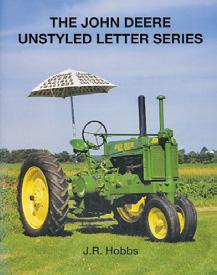
The John Deere Unstyled Letter Series Covers the JD unstyled GP, D, B, A, L, G, AR, AO, AI, BO, BR, BI, BO Lindeman, DI, 62, Y, W, AOS, Waterloo Boys and predecessors. Production numbers, year/SN breaks, original prices, matched working equipment, magnetos, carbs, wheels, history. 8-1/2 x 11,” soft cover, 160 pages. GM10: $24.00 US/C, $31.00 F NOW ON SALE! $18.00 US, $30.00 C/F
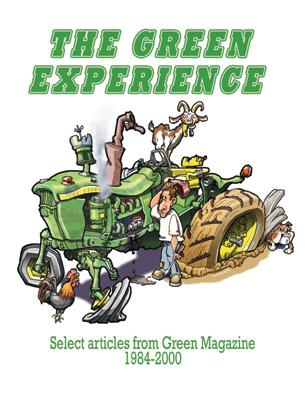
Approximately 96 pages of the best articles taken from Green Magazine’s first 15 years. Every member of the family will enjoy this book of restorations gone awry, trips that didn’t go as planned, cherished memories and sometimes profound situations. Not a technical or historical book, but a book about the lives and experiences of those who enjoy John Deere tractors. 11”x8-1/2,” about 96 pages, soft cover. GREX - $20.00 US, $30.00 Canada, $40.00 Foreign

Mr. Thinker’s John Deere Almanac, Fourth Edition All the same info found in earlier editions plus now Dan Brotzman’s New Gen and Gen II SN guide. For all models built from 1918 to 1972: history, SN/year breaks, accurate production numbers (no 820 three cylinder, 1020, 1520, 2020), notes on some significant changes, charts on tractor fluid capacities, cubic inches, compression ratios, torque specs, list of plow beam numbers. Info on proper colors of mufflers, axles, horse drawn equipment, fuels/lubricants, E/W stationary engines, L&G tractors. Chart on heights, weights and top speeds; SN/year charts for models 45 through 105 combines; tractor/loader application chart; SN/year charts for all tractors built from 1973 to 1990; and production numbers for models 4030 and 4230. 8-1/2”x51/2,” soft cover, black/white. MRT4 - $17.95 US, $28.00 C, $36.00 F US = United States • C = Canada price • F = Foreign price





The John Deere Hi-Crop Book This book provides serial number lists for JD models A, G, 60, 70, 620, 720, 430, 630, 730, 2010, 2510, 4010, 2520, 3020 and 4020. Verify Hi-Crop serial numbers, build dates and shipping locations in a pocket-sized book that’s easy to carry anywhere. Production summaries of two cylinder HiCrop tractors provided, as well as Hi-Crop totals by state and more. 72 pages, 5.5 x 8.5,” paperback, limited quantity. Order GMHC - $19.95 US, $26.95 C/F
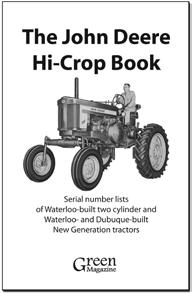
A Tractor Goes Farming Author Roy Harrington (co-author of John Deere Tractors & Equipment, Vol. 2) has put together a book that places the child in the driver's seat of a variety of tractor makes and models. Short sentences that kids will be able to read alone or with help and full color photos to please everyone. 32 pages, 7 x 8-1/2, hardbound. AS6T - $10.95 US, $16.95 C/F

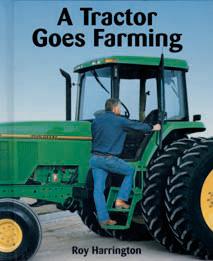
Grandpa’s John Deere Tractors This book for kids tells the history of Deere and Company starting with John Deere and his steel plow. Then in 48 pages with 50 color photos, it talks about how farming and JD tractors have changed. Best for kids 5 to 10 years. 7 x 8-1/2, hardbound, written by Roy Harrington. AS8K - $13.95 US, $19.95 C/F
How John Deere Tractors and Implements
Work Kids are always asking questions, especially about big machines. This book will give kids the answers they crave as they step into the field with impressive John Deere tractors and implements. Ages 8 to adult. 8-1/2 x 11, hardbound, 48 pages. AS9H - $14.95 US, $21.95 C/F

A book is a great gift — for yourself or someone else! Orders can be called in or placed online with a credit card or by mail with a check. For more information, see yellow box in opposite column.
Please use stock numbers when ordering books To place an order, give us a call, send by mail or go online Shipping UPS & First Class Mail daily • ALL PRICES INCLUDE SHIPPING Green Magazine • PO Box 95 • Bee, NE 68314-0095 Phone 402-643-6269 info@greenmagazine.com • www.GreenMagazine.com Please send all remittances in U.S. funds • Nebraska residents add 5.5% sales tax Visa, Mastercard, Discover & American Express accepted
A Specialized Look Into The Unstyled Model A: The Handbook of the John Deere A
A Specialized Look Into The Unstyled Model B: The Handbook of the John Deere Model B 1934-1938 This
Page 70 April 2024 • Green Magazine







Green Magazine binders PO Box 95 Bee, NE 68314-0095 Ph. 402-643-6269 info@greenmagazine.com www.greenmagazine.com Binders Keepers! Order BIN1 No need to punch holes in those precious magazines to hold them in a three ring binder. These binders have inserts to hold your magazines in place. Magazines are easy to put in, easy to take out and can be read while in the binder. Order BIN1 • Binders are now available in sets of 2 Each binder comes with 12 inserts • Additional inserts can be ordered—prices listed below U.S. $48 for set of two binders w/12 inserts each or $88 for set of four binders w/ inserts Additional inserts are $14 per dozen or $34 for three dozen CANADA $68 for set of two binders w/12 inserts each or $128 for set of four binders w/inserts • Additional inserts are $24/dozen or $54 for three dozen ALL OTHER COUNTRIES $88 for set of two binders w/12 inserts each or $168 for set of four binders w/inserts • Additional inserts: $34/dozen or $64 for three dozen Visa, MC, Discover, AmExp accepted • Nebraska residents, add 5.5% sales tax • U.S. funds only All prices include shipping/postage Green Magazine back issues COST FOR BACK ISSUE S, NOW AVAILABLE PER SET : U.S., PER SET: $29.00 • Nebraska residents, add 5.5 percent sales tax CANADA, PER SET: $70.00 U.S. funds • OTHER FOREIGN COUNTRIES, PER SET: $100.00 U.S. funds For more information or to place an order, call 402-643-6269 Green Magazine • PO Box 95 • Bee, NE 68314-0095 www.GreenMagazine.com • info@greenmagazine.com SET 1: 2014 and older (feature article listed after each issue) Apr 2011 Lost models • Oct 2011 7520 • Aug 2012 4030 Nov 2012 520 • April 2013 US B May 2013 4230 • June 2013 40 • July 2013 6600 combine Aug 2013 R • Nov 2013 8010 • Feb 2014 420 March 2014 Waterloo Boy, 1 • April 2014 Waterloo Boy, 2 May 2014 4620 • June 2014 720 July 2014 530 • Aug 2014 1020 Sept 2014 Unsty G • Nov 2014 Pre-D SET 2: 2015-2018 (feature article listed after each issue) March 2015 Late A • April 2015 1010 • May 2015 330 June 2015 BR/BO • July 2015 3020 • Feb 2016 4010 • March 2016 Uns L April 2016 2010 • May 2016 440 • July 2016 H • Aug 2016 820 Nov 2016 40 combine • Dec 2016 E engines • Jan 2017 3010 March 2017 2520 • April 2017 R • May 2017 4630 • July 2017 2030 Sept 2017 G • Oct 2017 W power units • Nov 2017 4430 Dec 2017 840 • Jan 2018 7020 SET 3: 2019 and newer (feature article listed after each issue) Feb 2022 H • March 2022 70 diesel • April 2022 830 June 2022 1010 • July 2022 60 • August 2022 1520 • Sept 2022 Unstyled B Oct 2022 330 • Nov 2022 Unstyled L • April 2023 GP June 2023 3010 series • July 2023 Late styled A Aug 2023 820 • Sept 2023 4040 • Oct 2023 GP specialties • Nov 2023 R Dec 2023 440 • Jan 2024 WA 14-17 • Feb 2024 4010 • March 2024 Early styled B Cost for single back issues of Green Magazine: $7.00 each U.S. (Nebraska residents add 5.5% sales tax) $9.00 each Canada (U.S. funds) • $11.00 each other foreign countries (U.S. funds) Number of magazines in each set will vary as inventory changes Visa, Mastercard, Discover, AmExp accepted Green Magazine® • April 2024 Page 71
Mr. Thinker,
I have a 730 diesel with a loose flywheel. The service manual says to torque it to 275 foot pounds. I did with my Snapon torque wrench and it still rocks on the crankshaft. I don’t dare go tighter; I did that on a “G” and split the flywheel and now it sits. Every now and then in the ads, there is mention about a taper-loc flywheel. Where can I get one? Help!
K.W., Connecticut
Martin Parts and Repair, a regular advertiser in this magazine, sells them. Give them a call at 574-598-6083. One of our advertisers could probably sell you a good flywheel for your “G” also. MT
Dear Mr. Thinker, Do you know when the PTO shaft on the “G” was changed from 1-3/4 inch to 1-3/8 inch?
C.E., Texas

Yes, the “G” PTO shaft was changed from 1-3/4 inch to the industry standard 1-3/8 inch at serial number 43401. That would be mid-year 1950. MT
Mr. Thinker,
I found a plow at an estate sale. It has John Deere 191 stamped on the top of it. I am assuming it is actually made by John Deere? If so, I am wondering what color(s) it should be painted? Also, would there be a source to get handles for it? Where could I get a picture of one with the correct handles?
E.K., Montana
The chart in Mr. Thinker’s John Deere Almanac tells us that beam 191 was used on a model NA5, NA6, GP5N and several other plows. See the illustra tion here for how they were painted, and yes,
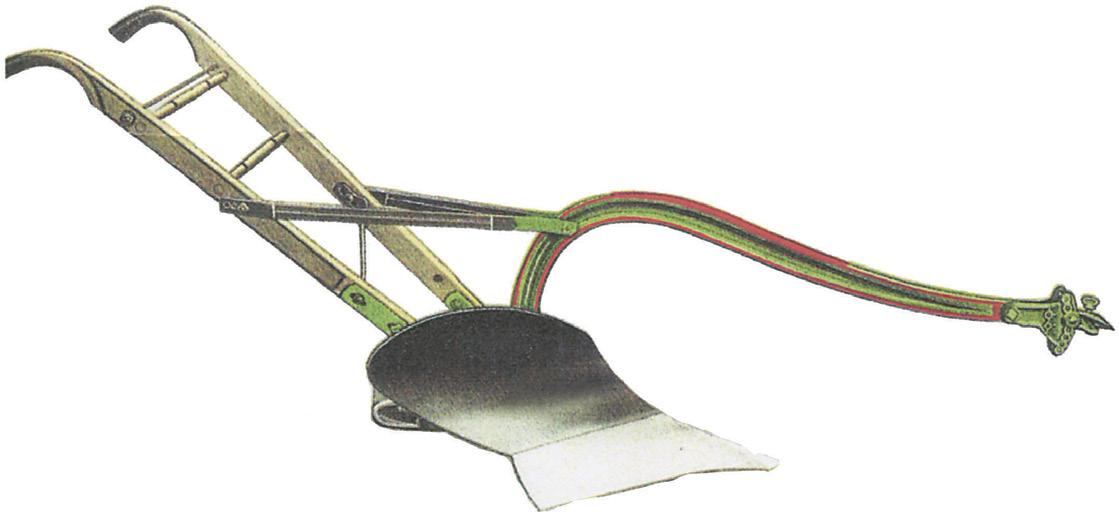
collectors who own NOS examples say that they were actually painted that way. Wood handles are easily found on the internet, or call Hansen Wheel and Wagon shop at 605-996-8754. MT
Mr. Thinker, I have an unstyled “B” that I am getting ready to paint. A friend of mine tried to tell me that I should not paint the carburetor, because they left the factory unpainted. I’m not sure that his is correct. What is your take?
R.R., Minnesota
Like Mr. Thinker’s parents used to tell him, you should really try to find smarter friends. The carburetors were installed on the assembly line. When the tractor came to the end of the assembly line, it was started, driven to the test room for an initial run in, tested for horsepower and given a general inspection. If the tractor passed, it was sent to the wash room, dried off and then painted, including the carburetor. Painting was fast and furious and other than perhaps the serial number tag, mag and gauge faces, little was spared. Go ahead and clear coat your carb if you want, but they didn’t leave the factory that way. MT
Mr. Thinker, I have a 2010 ag crawler. Was this the last and largest John Deere ag crawler?
S.M., Pennsylvania
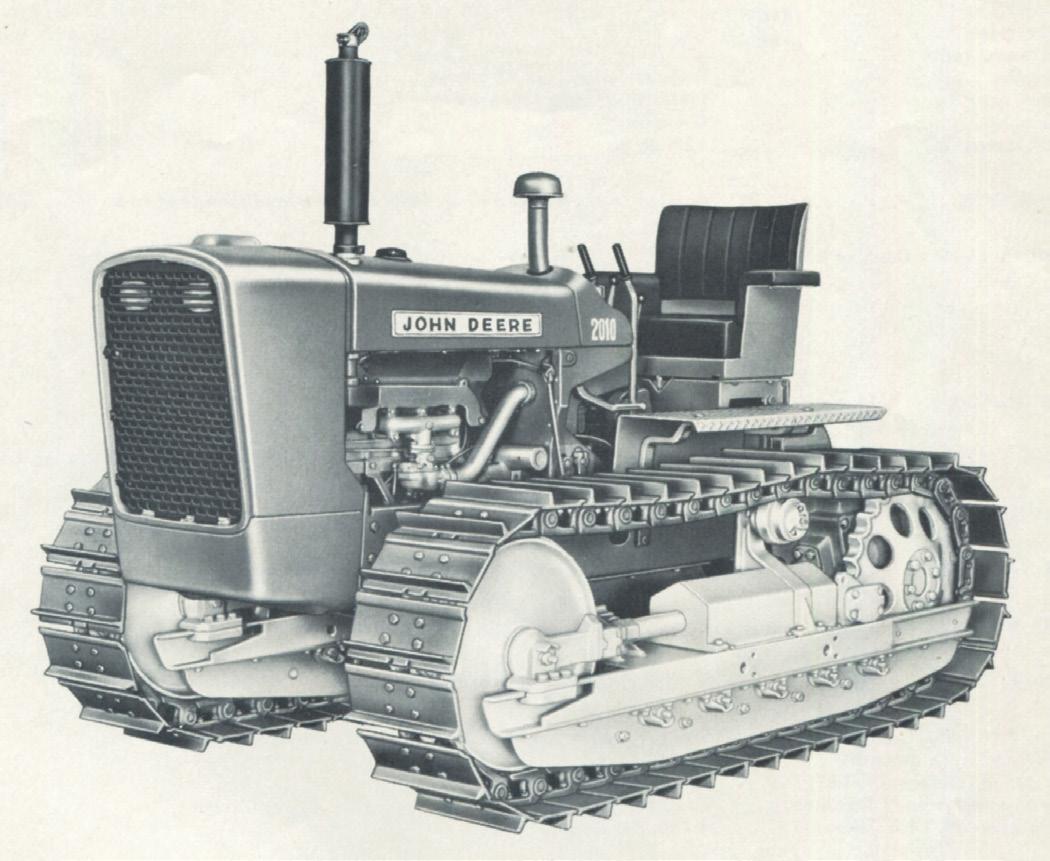
Page 72 April 2024 • Green Magazine
The good news is with only 159 built, you have a fairly rare machine. The bad news is they are definitely not one of Deere’s better products. In fact, many would put the 2010 crawlers somewhere between the Yugo and the Pontiac Aztec. You could say that they were the last steel-tracked Deere ag crawler, or the last crawler for a while, that is until the 8000 series was introduced in the 1990s. MT
Dear Mr. Thinker,
Do you recall an article from some time ago that gave information about using an 8000 series gear reduction starter on a 1940 “A”?
D.M., Michigan


Seems like yesterday, but it was long ago. Almost 21 years ago in fact; it was the August 2003 issue that explained how an 8000 series starter could be used on an early styled “A.” It bolts right up with the only real modification needed being that since you don’t have the little pedal to step on, you will need to add a push button switch or ignition key. MT
Dear Mr. Thinker,
I have a 1950 model “B” with a single front wheel. It has round rear axle housings instead of square like
most of the late tractors. Could they have been changed at some point?
D.M., Missouri
Your tractor is a “BN,” not a “B.” Both “BN” and “BW” tractors never received the square rear axle housings. MT
Mr. Thinker,
When did the square tube front axles come out? I have a 620 with a round tube front axle. Could it have come from the factory that way?
J.V., Washington


Square tube front axles were introduced at about the same time as the 70 diesel, which would have been in about November of 1954. Your 620 probably didn’t leave the factory with a round tube front axle, but it is possible that it was sold new with one, since a narrow front could have been exchanged for a round tube left in inventory at the branch house or dealership. MT
Answers to Mr. Thinker are provided by a variety of “experts.” Mail a question to Mr. Thinker/Green Magazine PO Box 95 • Bee, NE 68314 Email: info@greenmagazine.com Green Magazine® • April 2024 Page 73
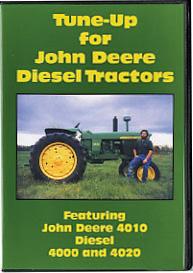




VJT4: Tune-Up Video for John Deere Tractors. 4010, 4020 and 4000 diesel JD tractors. 42 min.
VJE4: Engine Rebuild for John Deere Tractors. 4010, 4020 & 4000 diesel JD tractors. 2 hrs.
VJTQ: Tune-Up Video for John Deere
Dubuque-Built Tractors. Featuring 420 JD with information pertaining to the M, MT, 40, 430, 440, 320 and 330 JD tractors. 64 min.
VJEQ: Engine Rebuild for John Deere
Dubuque-Built Tractors. Featuring 420 with information pertaining to the M, MT, 40, 430, 440, 320 and 330 JD tractors. 90 min.
VJDE: John Deere A, B, G, 50, 60, 70 Engine
Rebuild From tear down to starting it back up. A must for the beginner. 85 min.
VJDT: John Deere A, B, G, 50, 60, 70 Tune-up. Don’t need an overhaul, just a tune-up? This video is for you. 60 min.
VJDR: John Deere Powr-Trol and Power Lift
Repair Keep those hydraulics and rockshaft running right. 51 min.
VJDP: How to Paint a Tractor. Give that old tractor a finish better than original. 56 min.
VB2C: How to Rebuild DLTX Carbs: The Rest of the Story. Tells how to get those stubborn screws loose, how to correct common running problems and other secrets. 111 min.


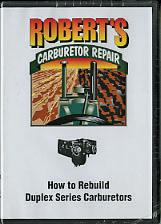
VBBM: How to Rebuild Wico Magnetos. Disassembly, repair and reassembly of one of a tractor’s most important parts. 103 min.


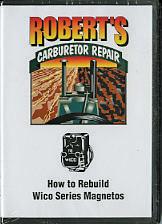
VBBG: How to Rebuild Governors Keep that JD running smooth. 121 min.
VBBS: The How-To’s of Sheet Metal. Repair dents, cracks and rust. 118 min.
VB3D: How to Rebuild Duplex Series Carburetors. Tractor pull but not idle? Start hard and runs only by working the choke? Run for short periods and then quit? This video will help trouble shoot such problems and go through a complete overhaul of the Duplex carburetor. Designed for the home mechanic with a basic tool box. 111 min.

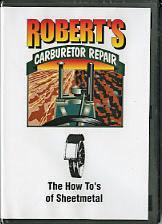

VTNG: New Generation Engine Restoration. Two disk set! Learn everything you need to know to confidently restore JD New Gen engines. Watch as Harvey Hamilton of Tired Iron Restoration guides you through a complete engine rebuild of a JD 3010 diesel. Filmed in HD, over 7 hours of content. Perfect visual companion to the technical manual. Includes engine diagnosis, inspection and repair of every component and step by step disassembly and reassembly. Advanced principles apply to other tractors including the 3020, 4010 and 4020. Follow behind the scenes to Barry’s Quality Machine to see the machining process and to Diesel Fuel Injection Service to see a pump calibrated.
VTNG: U.S. Price $59.95 • Canada $65.95 • Foreign $70.00





PO Box 95 • Bee, NE 68314-0095 402-643-6269 info@greenmagazine.com www.greenmagazine.com Nebraska residents add 5.5% sales tax Visa, Mastercard, Discover, and American Express accepted
DVDs - Green Magazine
GreenMagazine.com Check out the website for books, museum links, advertising and more!
Prices for DVDs shown ABOVE: U.S. $26.00 • Canada $32.00 • Foreign $37.00 Page 74 April 2024 • Green Magazine


Ervin Depcinski of Cass City, Michigan
heading home after a long day in the field with his 6030.































































































































































 A 1938 “A” with No. 25 cable lift loader owned by Mike Bowers of Lancaster, Ohio.
Right: Pictured here is Herman Schiel of Barton, New York with his 1957 model 720.
Right: Terry Harrimon and his 1969 4020 that his dad bought brand new in Scottsbluff, Nebraska from Frank Implement company. It’s been in the family ever since his purchase.
A 1938 “A” with No. 25 cable lift loader owned by Mike Bowers of Lancaster, Ohio.
Right: Pictured here is Herman Schiel of Barton, New York with his 1957 model 720.
Right: Terry Harrimon and his 1969 4020 that his dad bought brand new in Scottsbluff, Nebraska from Frank Implement company. It’s been in the family ever since his purchase.




 Left: Don Papenburg of Streator, Illinois cultivates with his 1937 “A.” The tractor was bought new by his grandfather from G.W. Riss and Sons.
Left: Don Papenburg of Streator, Illinois cultivates with his 1937 “A.” The tractor was bought new by his grandfather from G.W. Riss and Sons.













 Photo 8
Photo 6 • Photo 7, below
Photo 8
Photo 6 • Photo 7, below






 Photo 11 • Photo 12, below
Photo 13 • Photo 14, below
Photo 15
Photo 11 • Photo 12, below
Photo 13 • Photo 14, below
Photo 15































 Photo 8 • Photo 9, below
Photo 5 • Photo 6, below
Photo 8 • Photo 9, below
Photo 5 • Photo 6, below


























































































































